- Central America
- 10 Things To Know Before...

10 Things to Know Before Visiting Lake Nicaragua

Lake Nicaragua is a huge expanse of water; in fact, the Spanish conquistadors thought it a sea when they first saw it. Here are ten things you should know before you visit the lake.
It’s great for birdwatching.
There are a number of nature reserves dotted around the lake which are great for birdwatching . In particular, you should check out Los Guatuzos and Isla El Zapote.

Different people call the lake different names
There have been plans to build a canal through it.
Ever since Spanish rule ended in 1820, there have been schemes to build a canal running from the Atlantic to the Pacific through the lake. Interest died down after the completion of the Panama Canal in 1914, but the idea was recently resurrected by a Chinese group. However, it doesn’t look as if any work will be done anytime soon.

There is a volcanic island in the middle
The island of Ometepe consists of two volcanoes, Concepcion and Maderas, and the lava from previous eruptions. It’s a beautiful place to visit and you can hike up both volcanoes for great views over the lake.
It’s the largest lake in Central America
At 177 kilometres (110 miles) long and with an average width of 58 kilometres (36 miles), Lake Nicaragua is an impressive body of water.
It’s the only freshwater lake that contains oceanic animal life
It is thought that the lake used to be an ocean bay, until a volcanic eruption turned it into an inland basin. This trapped animal life such as sharks , tarpon and swordfish, which have since adapted to their new freshwater home.

Its size makes for some interesting geographical quirks
Due to the fact that the lake drains into the Caribbean Sea via the San Juan River, the city of Granada was an Atlantic port despite the fact that it’s far closer to the Pacific Ocean. Although it might seem weird when you look at the map, this allowed Granada to become a wealthy city in colonial times and you can still see evidence of that legacy today.
Bull sharks are found in shallow waters
The unpredictable bull shark is one of the most dangerous species in the world’s oceans for humans, and they are known to live in Lake Nicaragua. However, they do not generally live in the areas that are most frequented by tourists.
It used to be raided by pirates
Lakeside towns were raided until fortifications were built on the San Juan River in the 17th century. These days, it’s a lot calmer!
It’s perfectly placed for visitors
It’s easy to make Lake Nicaragua part of your trip due to the proximity of other top attractions. The surf town of San Juan del Sur is an hour from the port of Rivas, where you can take a ferry to Isla Ometepe. Return to the mainland at Rivas and it’s only an hour’s drive to the colonial city of Granada, which is itself within easy reach of Masaya and the international airport at Managua .
Since you are here, we would like to share our vision for the future of travel - and the direction Culture Trip is moving in.
Culture Trip launched in 2011 with a simple yet passionate mission: to inspire people to go beyond their boundaries and experience what makes a place, its people and its culture special and meaningful — and this is still in our DNA today. We are proud that, for more than a decade, millions like you have trusted our award-winning recommendations by people who deeply understand what makes certain places and communities so special.
Increasingly we believe the world needs more meaningful, real-life connections between curious travellers keen to explore the world in a more responsible way. That is why we have intensively curated a collection of premium small-group trips as an invitation to meet and connect with new, like-minded people for once-in-a-lifetime experiences in three categories: Culture Trips, Rail Trips and Private Trips. Our Trips are suitable for both solo travelers, couples and friends who want to explore the world together.
Culture Trips are deeply immersive 5 to 16 days itineraries, that combine authentic local experiences, exciting activities and 4-5* accommodation to look forward to at the end of each day. Our Rail Trips are our most planet-friendly itineraries that invite you to take the scenic route, relax whilst getting under the skin of a destination. Our Private Trips are fully tailored itineraries, curated by our Travel Experts specifically for you, your friends or your family.
We know that many of you worry about the environmental impact of travel and are looking for ways of expanding horizons in ways that do minimal harm - and may even bring benefits. We are committed to go as far as possible in curating our trips with care for the planet. That is why all of our trips are flightless in destination, fully carbon offset - and we have ambitious plans to be net zero in the very near future.

See & Do
The best markets to visit in nicaragua.

Bars & Cafes
The best wine bars in nicaragua.

Places to Stay
The best hotels in granada, nicaragua.

Where to Stay in Granada, Nicaragua

Managua: Why This Hidden Gem Deserves to be Explored

The Story Behind How Nicaragua Got its Name

How To Go Volcano Boarding in Nicaragua

The Best Boutique Resorts in Nicaragua

The Best Bed and Breakfasts in Nicaragua

The Best Hotels in Nicaragua for Every Traveler
The most beautiful historical towns and cities in nicaragua.

Guides & Tips
11 nicaraguan words and phrases you need to know, culture trip spring sale, save up to $1,100 on our unique small-group trips limited spots..

- Post ID: 1000051672
- Sponsored? No
- View Payload

Activity Guides , Adventure Travel , Travel Reviews , Travel Tips
December 18, 2023
10 Things To Know Before Visiting Lake Nicaragua

10 Things To Know Before Visiting Lake Nicaragua: Lake Nicaragua, the biggest lake in Focal America, is an entrancing traveler location with an uncommon mix of normal magnificence, social importance, and energizing exercises. Alongside its wonderful view, notable towns, and volcanic islands , Nicaragua is home to this enormous freshwater lake.
On the off chance that you remember a modest bunch of essential subtleties before your getaway to Lake Nicaragua, it ought to go without a hitch. Finding out about the neighborhood culture and the different environments in the space is fundamental prior to visiting this stand-out area. Pay attention to the following.
A List of 10 Things To Know Before Visiting Lake Nicaragua
Cultural diversity:.
Lake Nicaragua and the encompassing towns are similarly basically as socially different as the remainder of Nicaragua. The lakeshore is home to numerous indigenous communities, each with its own culture, beliefs, and history. Meet local people, find out about their way of life, and be astonished by the variety that makes this spot unique.
Ometepe Island:
You really must see Ometepe Island, which is situated in the very centre of Lake Nicaragua. Concepción and Maderas, the island’s two volcanoes, have shaped it into a place of breathtaking natural beauty , fascinating history, and vibrant social networks. Make time on your vacation to see the island’s typical attractions, such as its waterfalls, petroglyphs, and the chance to ascend to the peak of the volcano for breathtaking vistas.
Wildlife and Biodiversity:
The flora and fauna of Lake Nicaragua are very varied. Numerous aquatic and terrestrial species call the lake their home. Waterfowl and transitional bird enthusiasts will be ecstatic. To observe iguanas, monkeys, and a plethora of bird species in their native habitat, consider taking a boat ride to Grenada’s islands.
Volcanic Activity:
Volcanoes in the area give the landscape a unique and spectacular quality. The region’s richness is enhanced by volcanoes, which also offer uncharted potential. Pay attention to health regulations and stay informed about any volcanic activity. To ensure a safe and important experience while researching the volcanic aspects of the area, engage with local specialists and consultants.
Transportation and Accessibility:
Getting around Lake Nicaragua calls for a wide range of transportation options. Prepare ahead of time for your mode of transportation, whether it’s the ships that connect the towns in the central area or the boats that explore the islands in the lake. If you want to make the most of your trip , especially if you want to explore remote areas, think about renting a car or hiring local guides.
Weather and Seasons:
If you want to plan a successful trip, you must first understand the local surroundings. Because of its tropical climate , Nicaragua experiences clearly defined rainy and dry seasons. Prepare for the rare rainstorm, especially during the rainiest period of the year, and adjust your workout schedule accordingly. For picture-perfect weather, most people recommend going during the dry season, which typically runs from November to April.
Cuisine and Culinary Delights:
The cuisine of Nicaragua is an artful fusion of indigenous ingredients and Spanish influences. Taste some local specialties like gallo pinto (rice and beans), vigorón (a traditional meal with yuca, hog skins, cabbage salad), and fresh seafood. Discover the local markets for a guaranteed culinary adventure and seize the opportunity to savour the district’s unique flavours.
Language and Communication:
English isn’t widely spoken in a few distant locations, even if Spanish is the authoritative language. Learning some simple Spanish words can open doors for you when you travel . Make the most of the opportunity to meet people, ask them questions, and obtain a feel for their culture.
Social Style:
While visiting Lake Nicaragua, regarding the neighborhood customs and traditions is pivotal. Individuals from Nicaragua are broadly kind and inviting, so showing certifiable interest in their way of life makes certain to be valued. It is respectful to welcome somebody with a “Hola” or “Buenos das” prior to snapping their photo.
Ecological Insurance:
Capable the travel industry is fundamental assuming that the sensitive climate of Lake Nicaragua is to be safeguarded and its normal wonder kept up with. Don’t litter, give your support to businesses that put sustainability first, and get involved in preservation efforts to reduce your impact on the environment. The pristine location’s long-term existence will be ensured by respecting the local species and adhering to the authorities’ guidelines.
Conclusion:
The destination of Lake Nicaragua is full of everyday wonders, social prosperity, and adventure . Enjoy an excursion that safeguards the lake as well as investigates its excellence by getting it. Finding out about the nearby culture, embracing new conditions, and rehearsing the travel industry. Lake Nicaragua will leave an indelible impression on anyone brave enough to explore its beaches , regardless of what draws you there—the stunning volcanic landscape, the historic villages, or the welcoming locals. I hope you like reading “10 Things To Know Before Visiting Lake Nicaragua”.
Related posts:
- Bali Indonesia Tourism 2024
- 8 Best Hikes In Argentina in 2024
- Travel Tips and Hacks
- Honduras Beach Resorts
Leave a Comment Cancel reply
Save my name, email, and website in this browser for the next time I comment.
Things to Do in Lake Nicaragua, Nicaragua - Lake Nicaragua Attractions
Things to do in lake nicaragua.
- 4.0 of 5 bubbles & up
- Good for Kids
- Budget-friendly
- Honeymoon spot
- Good for Couples
- Good for Big Groups
- Adventurous
- Good for a Rainy Day
- Hidden Gems
- Good for Adrenaline Seekers
- Things to do ranked using Tripadvisor data including reviews, ratings, photos, and popularity.

1. Las Isletas
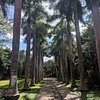
2. Encuentros Club
- Nicaragua Full Day Tour from Costa Rica
- Full-day trip to Nicaragua
- PRIVATE Day trip Granada Isletas +Colonial City tour from Managua
- Granada Isletas and City tour
- Day Trip to Granada Nicaragua from Playa del Coco Areas
Travel to Nicaragua: what you need to know
Jul 3, 2019 • 6 min read

From lava-spewing volcanoes to idyllic, far-away beaches, Nicaragua's natural landscape measures up to some of the world’s best. But a series of clashes between anti-government protestors and the supporters of president Daniel Ortega have caused the death of 325 Nicaraguans in the spring of 2018 and placed a cloud of uncertainty over the entire country.
The ethical dilemma of traveling to Nicaragua
The Nicaraguan government has been accused of using tourism as a PR tool to promote a stable image of the country. While everything may seem ‘normal’ on the surface, the reality for Nicaraguans is quite different. Visiting tourists can provide a false image of normalcy, but tourists not visiting has a direct impact on an already bad economy and the livelihoods of thousands of families who rely on it.
Even the most intrepid travelers have concerns. The embers of violence have cooled and life is slowly returning to a sense of normalcy. It’s important to exercise caution, but here are areas in Nicaragua ready to welcome travelers.

Nicaragua’s misunderstood ugly duckling. As the capital, Managua is more prone to political demonstrations. The constant police presence is an occasionally alarming reminder that big brother is watching.
Even before the protests, many travelers used Managua as a hub to get other spots around the country. But, if you elect to stay in the city for a few days, exercise caution and avoid protests.
The chaotic city without street names is not easy to navigate, but you'll eventually find yourself exploring third-wave coffee shops, food-truck parks, authentic local food, specialty stores and local markets. And when the sun sets, the party begins with Nicaraguan music concerts, Latin dance parties, underground electronic fetes, craft beer bars and fine cuisine.
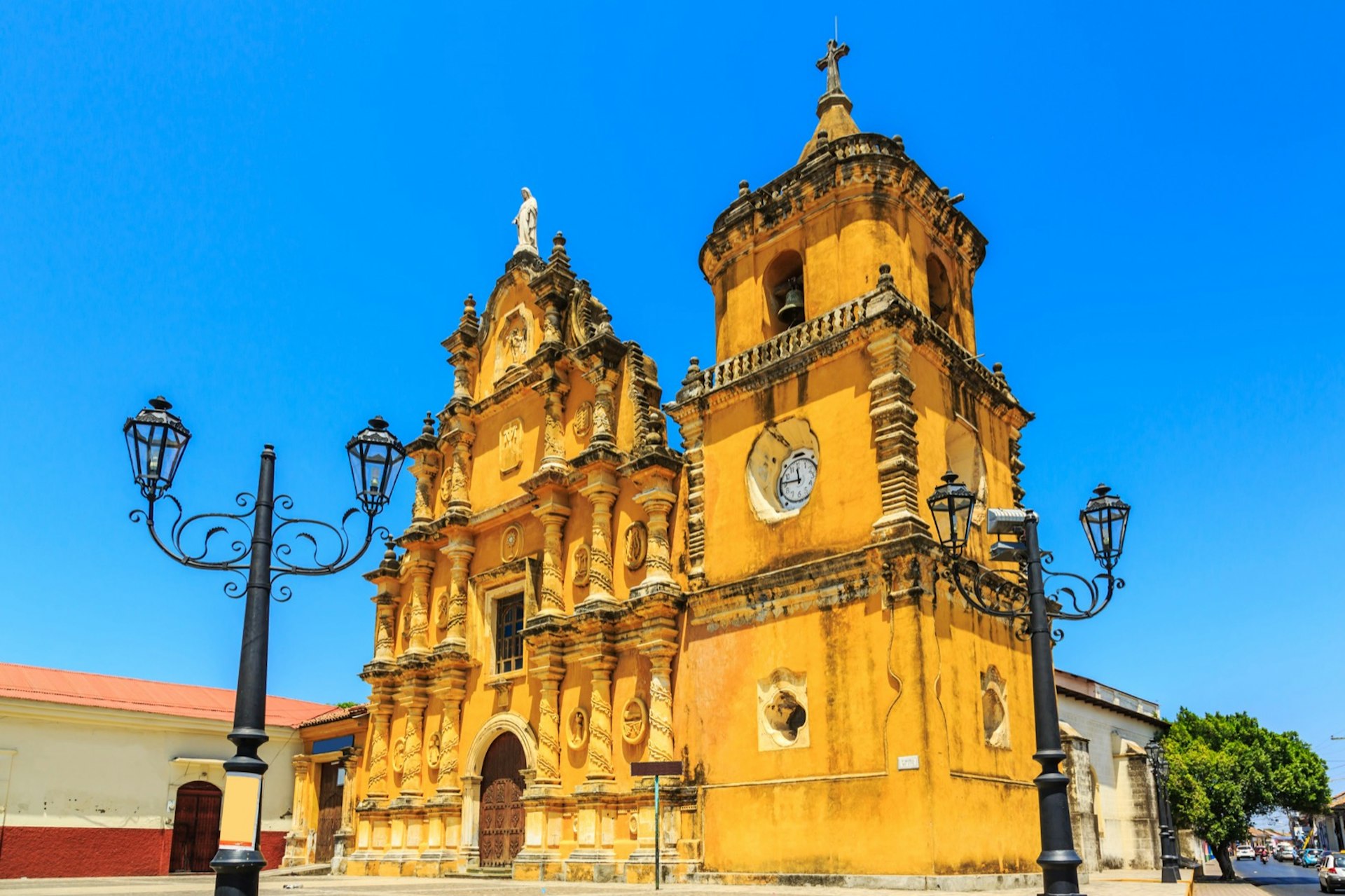
León and las Peñitas
León is a vibrant city full of inspiring architecture and artsy vintage murals.
The student town, considered the heart of Nicaragua, is located an hour-and-half from the capital city of Managua and was once home to Nicaragua’s greatest poet – Rubén Darío .
The city was a hot spot during the protests and demonstrations can happen anywhere around the city. If a protest begins, do not get involved and leave the area.
While in León, access the rooftop of the Cathedral Basílica de la Asunción (the largest in Central America) for a unique view of the city and the surrounding volcanic chain of Maribios. Pay a visit to Fundación Ortiz Gurdián to see one of the finest contemporary art museums in Central America. For an adrenaline fix, try volcano surfing down the black sands of the Cerro Negro.
Just 25 minutes west of León you’ll find Las Peñitas beach an easy-going surf spot with access to mangroves and Isla Juan Venado – a nature reserve popular for its bird-watching and turtle nestings.
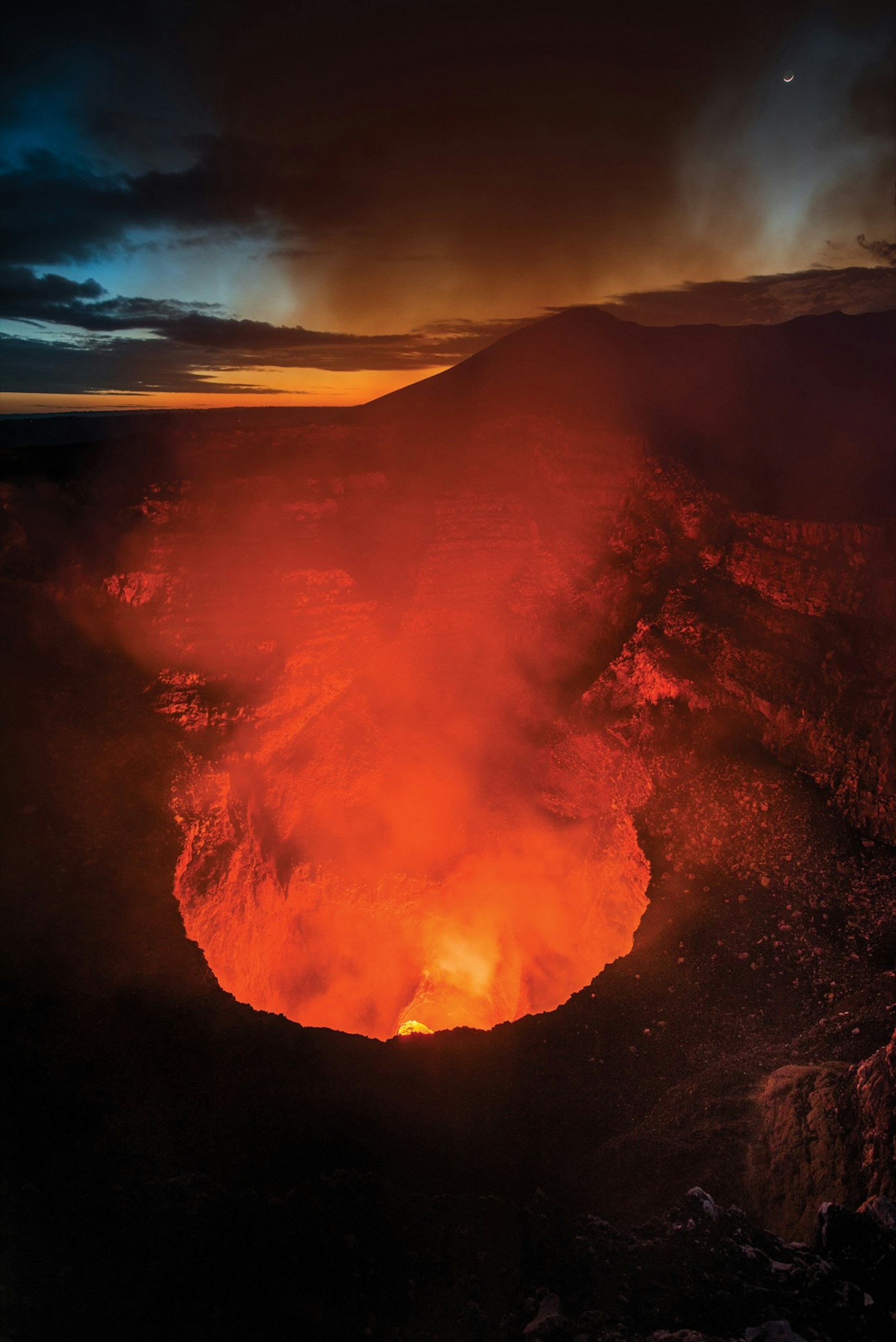
Volcán Masaya
In a country filled with volcanoes, Volcán Masaya stands out from the crowd. The very active natural wonder was known as the ‘mouth of hell’ by Spanish conquistadors, is located on Parque Nacional Volcán Masaya, the country’s largest national park. For truly mesmerizing views, visit Volcán Masaya at night.
The town of Masaya, located 30 minutes from the national park, was a stronghold of anti-government protesters. As a result there was a strong police presence in the area causing many businesses to close. Though the situation has cooled down, it would be best to skip this small town.

History lives on every corner in Nicaragua’s oldest town. Founded in 1524, Granada has been invaded by pirates led by Henry Morgan and burned down twice by the self-proclaimed ‘President of Nicaragua’ William Walker, an American expansionist from Nashville.
To get a true sense of Nicaraguan history, however, visit Convento y Museo San Francisco, one of the best museums in the region.
Granada is located at the foot of the green and dormant Volcano Mombacho . The area boasts a nature and wildlife reserve with clear designated hiking trails, ziplines and coffee haciendas. Mombacho also offers panoramic views of Granada and Lake Cocibolca.
If the mainland isn’t for you, stay on one of the 365 islets that make up the archipelago – Isletas de Granada, which was formed by a massive volcanic landslide 20,000 years ago.
A darling among tourists, Granada has felt the brunt of the civil unrest. The peaceful and picturesque town painted in bright colors is now mainly shuttered as nearly half of the city’s businesses have closed in the past year. You can still find a decent variety of restaurants and cheap 'crisis' deals at a wide range of hotels as the remaining businesses try to stay afloat.
Corn Islands
The white-sand Caribbean paradise found on the Corn Islands remains remote and untouched. Distance kept the secluded getaway free of the violence and protests, leaving the beaches pristine and environment serene. Of course, all this serenity comes at a price – no cars, wifi or electricity (at times), particularly on Little Corn . But once you set eyes on the area, you won't mind at all.
Laguna de Apoyo
Located about 9 miles (15 km) north of Granada, this peaceful crater lake is believed to be the cleanest and deepest in the country. Whether you decide to just view from the crater's edge in Catarina or Diriá or head to the bottom of the crater for swim, you won't be disappointed.

Pacific Coast Beaches
All the beach towns in Southwestern Nicaragua have remained relatively calm and isolated from the civil unrest. The cluster of mountains, bays and uncrowded waves have something for everyone; from world-renowned surf breaks in Popoyo, which hosted the world surfing games in 2015, to affordable luxury beach developments in Tola.
International hub – San Juan del Sur – attracts the young and beautiful, but also offers top-notch lodgings (try El Coco Azul ) and fantastic dining (try Asados Juanita ). Not completely immune to all the troubles, tourism numbers have also dipped in the area in comparison to prior years.
Reaching Ometepe and seeing its famed twin volcanic peaks – Concepción and Maderas – was the kind of arduous journey that never attracted very large numbers of travelers.
The area was under heavy police presence during the height of the unrest, and though things have cooled down, the local economy is suffering. Tourism has almost completely disappeared and many people have gone back to basic agricultural practices to survive.

Northern Highlands
The land of coffee and cigars isn’t usually high on travelers’ list, but anyone seeking a mountain experience won’t find a better place.
The civil unrest reached the main towns of Matagalpa and Estelí , but things have settled down. Estelí is the major producer of premium cigars in the world. Spend an afternoon learning the art of cigar manufacturing.
Matagalpa is about an hour-and-half southeast of Estelí and is filled with endless lush green mountains and waterfalls. Enjoy the coffee farms , the farmstays and unspoiled country life.
Essential travel tips
The United States has issued a level 3 ‘Reconsider travel’ advisory on Nicaragua due to the ‘civil unrest, limited healthcare availability and arbitrary enforcement of laws'. Both the UK and Canada have issued ‘exercise a high degree of caution’ travel advisories.
Commercial airlines still fly to the country.
When in Nicaragua
- Avoid all demonstrations
- Don’t take photographs of the heavily armed police.
- Sign up for online alerts from your local embassy to stay on top of any political unrest.
Nicaragua is under the international scope for sanctions, the economy is in a recession expecting a decrease in GDP of 7-11% for 2019.
Armed robberies have been reported by travelers; however, no tourists have been killed, including during the height of the civil unrest.
Explore related stories
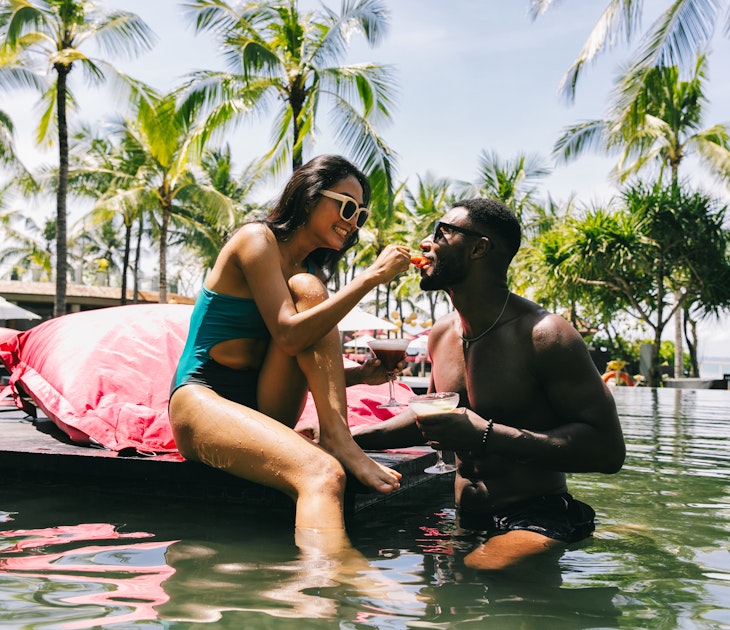
Feb 12, 2024 • 10 min read
Sun-soaked beaches and colorful coral reefs – even the cheapest tropical vacations seem to have it all. Here's where to go.

Jan 29, 2024 • 11 min read

Jan 7, 2024 • 3 min read

Oct 25, 2023 • 19 min read

Oct 10, 2023 • 6 min read
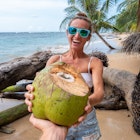
Oct 24, 2022 • 5 min read

Sep 2, 2022 • 5 min read
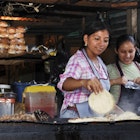
Jun 28, 2022 • 7 min read
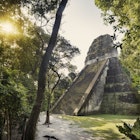
May 3, 2022 • 9 min read
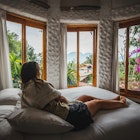
May 1, 2022 • 6 min read

Stop Dreaming. Start Packing.

Travel Tips For Ometepe, A Volcanic Island In Lake Nicaragua

Ometepe Island is the largest island in Lake Nicaragua. Covering an area of 276 square kilometers (107 square miles), its curious hourglass shape rises out of the water with an active volcano on one end and a dormant one on the other. Farmland and homes lie between the volcanoes on this island whose name comes from the Aztec words “ome” meaning two and “tepetl” meaning mountain. I found it to be such an extraordinary place to visit and would go again in a heartbeat! Here are some travel tips for Ometepe Island in Nicaragua:
Getting to Ometepe Island:

The best way to get to this island easily is by ferry boat, which may be boarded in the Nicaraguan town of Rivas. Upon arrival at the port, you will notice that it is small and bustling with a flurry of activity.
When I was in Rivas with a group, there were two small ferries, each about the size of a tugboat and definitely not the size of your average ferry. One ferry even had about 100 mattresses stacked on the top deck. Thankfully we were taking the other boat, which looked old and could spring a leak and sink at any moment. We boarded with our luggage, which workers placed on the second floor. It was fascinating to watch – one man on the first floor would lift heavy bags or suitcases above his head to the man on the second floor, which is where he carefully placed them until the end of our hour-plus-long journey to the Ometepe town of Altagracia at the Port of Grace. This luggage handling process then had to be done in reverse for disembarkment.
Arriving on Ometepe Island:
Ometepe Island has its own bustling port. Once we boarded the luggage onto a van, we headed out to our lakeside accommodations on the other side of the island in Altagracia. As we drove through the port town, we noticed tourists milling around, bars and restaurants lining the streets, and small hotels and hostels. Past that, farmland and lush greenery on both sides of the road greeted us. Occasionally, we would see farm animals and stray dogs freely walking along the side of the road, something I was very curious about since you do not see much of that in the States.
Accommodations on Ometepe Island:

There are plenty of options for hotels, homestays, and hostels when you visit this large island, with approximate prices ranging from $10-$200 per night. The cost of a hostel is closer to the $10/night mark and a nicer hotel or resort will be more expensive.
There are many relaxing options on Ometepe, where you can be as lazy or adventurous as you want. Let’s look at a few of those options here:
1. Hike a volcano.

With two volcanoes to choose from, there are a few hiking choices, and all of them are rather challenging and you are not allowed to hike on your own. The stipulation is that you need to hire a local guide, which is non-negotiable.
Through a local guide, choices for volcanic hikes are:
- Hike to the top of Volcán Concepción (1,600 meters or 5,249 feet in elevation). The last part of this 16km hike is extremely steep and rocky.
- Hike to the top of Volcán Maderas , standing at 1,394 meters (or 4,573 feet), is slightly easier, but gets steep and muddy. At the top, however, is a crater lake, which is supposed to be beautiful.
- Hike to the viewpoint of Volcán Maderas , which will still be a challenge but not nearly as difficult as the other two hiking choices. It’s shorter than the other hikes, so if you are short on time, this may be the best option.
Which hike would you choose? To learn more about hiking a volcano on Ometepe Island, please click here to visit the article.
2. Have lunch with a view.

La Mariscada located at Hotel Villa Paraiso is located on the beach and a great place to relax especially if you went on a strenuous volcano hike. The tables are set outside overlooking the lake in a lush, tropical setting. Once your food and drink are ordered, head down to the beach where you can go for a swim, walk along the soft sand, or sit in a beach chair until you decide to go back to your table. Then, feast on delicious Nicaraguan food and wash it all down with a local beer!
3. Swim in a natural spring.

Oja de Agua is a set of natural spring-fed pools fed by an underground river from Maderas Volcano. The water is rather cool, which is incredible on a hot, sunny day (but if there’s cloud cover, you may find it too cold to swim). Coco Loco, a rum and coconut water drink served in a coconut, may be ordered in a number of locations around the pool. Try out the Tarzan swing, which was essentially a rope attached to a thick stick you hold onto with your hands. Just climb up to a platform, grab the rope, and swing into the chilly water. It’s a fun way to get in! There’s no lifeguard around so be as cautious as you can after drinking some Coco Locos. For other brave souls, there’s a tightrope along one of the pools to try. The tightrope is tricky but it’s also incredible to see others walk along it without falling.
Oja de Agua has outdoor showers that can double as change rooms. Admission isn’t too expensive either at just $5.00 USD/person (or even less expensive at $3.00 if you’re a Nicaraguan national). There’s an enclosed restaurant/bar area as well, but you may want to hang in a lounge chair by the pool the entire time. It’s quite a fun experience and definitely worth a visit if you find yourself on Ometepe Island.

During our time here, I asked a local a looming question I had (and you may be wondering the answer, too) – Why are there so many farm animals walking along the side of the road? Those animals looked like strays (at least to me), but he assured me they belonged to farms in the area and that they leave early in the morning to go find food and return home around mid-afternoon.
If you do find yourself in Nicaragua, Ometepe Island is a must. There’s just no other place on earth like it! If you’re in Nicaragua, consider taking a tour of Ometepe Island and spending the night.
Note: Nicaragua celebrates Valentine’s Day too! Find out about it in this post .

For any trip that takes you 100 miles or more from home, consider purchasing travel insurance. TravelInsuranceMaster.com recommends the best plan and value for your specific trip in just 3 steps, working with the world’s leading providers to bring a large variety of plans and benefits to their site. This saves you time so you can get back to the best part – planning and ultimately enjoying your vacation!

(Some posts, like this one, contain affiliate links. If you make a purchase using the link, I earn a small commission at no cost to you. Anything I earn offsets the cost of running this website. Thank you for your support!)
This post may contain affiliate links with which I earn a small commission at no additional cost to you.

You May Also Like

13 Best Things to Do in Provincetown on Cape Cod, Massachusetts

7 Epic Things To Do In Costa Rica That Don’t Involve Zip-lining

Yacht Ride In Dubai Marina: All You Need To Know
Best things to do in Nicaragua
Book your individual trip , stress-free with local travel experts
- roughguides.com
- best-things-to-do-in-nicaragua
Plan your tailor-made trip with a local expert
Book securely with money-back guarantee
Travel stress-free with local assistance and 24/7 support

written by Andy Turner
updated 04.01.2023
A land of contrasts, Nicaragua is Central America’s sweet spot with all of the culture and nature, yet with few tourists. Word is quickly getting out about Nicaragua, long off the radar for all but the hardiest of travellers to Central America. Feeling inspired? Explore these best things to do in Nicaragua.
1. Take a walk around the streets of León
2. take the ferry to isla de ometepe, 3. surfing in san juan del sur - one of the best things to do in nicaragua, 4. marvel at the colourful granada, 5. get involved in outdoor activities at apoyo lagoon natural reserve, 6. take a river tour at río san juan, 7. feel the tranquillity on a secluded little corn, 8. volcano boarding - one of the most exciting things to do in nicaragua, 9. visit miraflor cloudforest reserve, 10. take a tour of the cigar factories in estelí, 11. head to the tropical solentiname archipelago, 12. explore the islets of granada, 13. see the majestic volcanoes in masaya volcano national park, 14. visit lake nicaragua, 15. take a ride to somoto canyon, 16. try gallo pinto and other local delicacies.
This article is inspired by our Rough Guides guidebooks — your essential guides for travelling the world.
A vibrant university town with a revolutionary past. Closer to the Pacific coast, near the Honduran border, León is the country’s second largest city with a population of 200,000. The swelteringly hot lowland city has maintained its colonial core, with more than a dozen 18th-century churches, many of which are connected by underground tunnels once used to escape pirate attacks and now part of the sewer system.
The colonial baroque Basilica Catedral de la Asuncion was built between 1747 and 1814 and is the largest cathedral in Central America. Having endured earthquakes and bombings, it has become a symbol of the city itself.
Explore León in Nicaragua, home to the largest cathedral in Central America on the Colonial City Tour . See the ruins of one of the continent’s first Spanish cities, preserved by ash from a volcanic eruption.
Where to stay in León:
- Best for hospitality: Casa de Los Berrios . Boasting a garden, terrace and views of garden, Casa de Los Berrios is situated in León, 2.3 km from Guadalupe. Among the facilities at this property are a concierge service and a tour desk, along with free WiFi throughout the property. The hotel has family rooms.
- Best for comfort: Hotel Flor De Sarta is an elegant, boutique hotel located in León, 500 m from the city's historic cathedral. Free Wi-Fi access is available, as well as an outdoor pool.
Find more accommodation options to stay in León

Cathedral in Leon, Nicaragua © emperorcosar/Shutterstock
The world’s largest volcanic island within a freshwater lake, Ometepe is one of Nicaragua’s primary attractions, even though it’s quite rugged and lacks much infrastructure. Seeing the island’s twin volcanic peaks from the lake – the perfectly conical Concepción and forest-covered Madera, connected by the Istián isthmus – is one of the best things to do in Nicaragua.
Primarily used for agricultural purposes, nearly anything will grow in Ometepe’s rich volcanic soil, including coffee, bananas, and avocados. Pre-Columbian petroglyphs and rock carvings are found across the island, though there is likely much more to be discovered beneath the thick jungle.
Travel from Granada to Ometepe Island and enjoy a day of sightseeing and relaxation. Explore the diversity of plant and animal life in this UNESCO Biosphere Preserve. Learn about the various tribes and cultures on the island, and hang out on the beach.
Where to stay at Isla de Ometepe:
- Best for location: Hotel La Omaja . Offering year-round outdoor pool and terrace, Hotel La Omaja is located in Mérida in the Rivas Region Region, 40 km from San Juan del Sur. Guests can enjoy the on-site restaurant. Free private parking is available on site.
- Best for relaxing vibes: La Urraca Loca Hostel . Boasting a restaurant, bar, garden and free WiFi, La Urraca Loca Hostel is situated in Balgue, 12 km from Maderas Volcano and 3.3 km from Santa Cruz. 4.3 km from Punta Gorda and 4.8 km from Las Cuchillas, the property provides barbecue facilities and a terrace. The accommodation features a shared kitchen, and organising tours for guests.
Find more accommodation options to stay at Isla de Ometepe

Volcano on Isla de Ometepe, Nicaragua © Pete Niesen/Shutterstock
Surfing by day, partying by night in Nicaragua's favourite beach resort is certianly one of the best things to do in Nicaragua. A little more than a couple of decades ago, word started to get out about a sleepy fishing village with great surf breaks called San Juan del Sur.
San Juan del Sur’s main attraction, the beach, encircles a crescent shaped bay where the San Juan River empties into the Pacific Ocean. Aside from a few beachside restaurants, most amenities are set back from the beach’s southeastern corner, in a seemingly thrown-together grid packed with surf stores, a microbrewery, an artisanal donut shop, taquerias, and dozens of small hostels and hotels.
Where to stay at San Juan del Sur:
- Best for surfing: Dreamsea Surf Resort Nicaragua features a restaurant, outdoor swimming pool, a bar and garden in San Juan del Sur. Featuring family rooms, this property also provides guests with a terrace. The accommodation provides evening entertainment and room service.
- Best for backpackers: Buena Onda Backpackers . Buena Onda Backpackers offers some rooms that have sea views, and the rooms include a private bathroom with a shower. The accommodation offers a terrace. Speaking English and Spanish, staff are always on hand to help at the reception.
Find more accommodation options to stay at at San Juan del Sur

Sunset surf in Nicaragua © Anthony Sheardown/Shutterstock
A tourist-friendly colonial jewel, now painstakingly restored. Established in 1524, Granada is the oldest colonial city in the Americas and shares some of the Moorish architecture of its Spanish namesake.
The centre of Granada’s historic core is at Parque Colón, a vibrant central square where parrots squawk in the tall palms and food stands sell vigorón, a traditional snack of pork and cabbage wrapped in banana leaf.
For many travellers, the cobblestone streets and colonial townhouses-turned-boutique hotels in Granada serve as a base from which they explore the rest of the country. Easy day trips from the city allow for hikes on the forested slopes of the Mombacho Volcano or for soaks in the hot springs below it.
Explore the colonial architecture of Granada on Lake Nicaragua on a 3-hour tour , and admire landmark attractions such as the San Francisco Convent, Merced Church, and La Polvora Fort. Ride a horse carriage to some of the most scenic surroundings.
Where to stay in Granada:
- Best for style: Miss Margrits . Offering an outdoor pool, Miss Margrits is located in Granada. Miss Margrits features a garden, barbecue facilities and a TV lounge. Other facilities offered at the property include a shared lounge, luggage storage, washing and an ironing service.
- Best for B&B: El Arca de Noe . Featuring free WiFi and a terrace, El Arca de Noe B&B is located at the historic center of Granada, only two and a half blocks from the central park and the cathedral. Complimentary breakfast and city tour is included with your rate. You will find a shared kitchen at the property as well as hammocks in the terrace.
Find more accommodation options to stay in Granada

Granada, Nicaragua © Javier Garcia/Shutterstock
Related articles from the blog

Twenty minutes west of Granada is the Laguna de Apoyo Nicaragua’s largest volcanic lagoon. More than 200 meters (656 ft) deep and 6km (4 miles) in diameter, the caldera is ringed with lush forests where toucans and white-face monkeys can easily be spotted on a short hike.
A few restaurants and ecolodges, some of which rent kayaks, can be found on a strip along the northwestern shore of Apoyo, though the majority of visitors come on a day trip from Granada.
Lake Apoyo is an attractive tourist destination thanks to its dark sand beaches for swimming, kayaking, hiking, snorkelling, bird watching, paragliding, boating and more.
Enjoy panoramic views of Granada, Lake Nicaragua, and the Laguna de Apoyo with this Mombacho Volcano Nature Reserve tour .

Mombacho volcano and the Apoyo lagoon © Shutterstock
Take to the water to explore the tropical forest and the El Castillo ruins. On the south eastern shore of Lake Nicaragua, where it meets the San Juan River, San Carlos is a bustling port town.
Most travellers pass through here on their way to the Solentiname Islands, using their time while waiting for boats to hang out at the string of bars and restaurants located in stilted wooden houses over the water. Agencies in town can arrange tours east along the San Juan River, where there are several unique hotels. A Spanish-built fortress can be seen at El Castillo which is much stronger than the one in San Carlos.

El Castillo © Bas van den Heuvel/Shutterstock
The islands of Big Corn and Little Corn are a world of their own. With white sand beaches fringed with palm trees and turquoise water offering the country’s most pristine coral reefs.
A single paved road runs the length of Big Corn Island, which is where most tourism in the Corn Islands is concentrated. For those that think there is too much going on over on Big Corn Island, they will love Little Corn. Less than 2km (1.2 miles) long, the tiny isle is accessible by speedboat several times a day from Big Corn Island, an approximately 30-minute ride.
There are no cars here, just a patch of jungle circled by clean, clear beaches and one well-trodden footpath which makes relaxing on this beach one of the most tranquil things to do in Nicaragua.
Where to stay at the Little Corn:
- Best for peaceful vibes: Little Corn Island Beach and Bungalow is set in Little Corn Island, 15 km from Corn Island. Guests can enjoy the on-site restaurant. Certain rooms have a seating area for your convenience. Some rooms feature views of the sea or garden. The rooms include a private bathroom equipped with a bath or shower.
- Best for luxury: Yemaya Reefs . Located on North End Beach, Yemaya Reefs offers tropical gardens, stylish bungalows with ocean views. Each oceanfront bungalow features elegant contemporary décor and a terrace with a seating area, plus hammocks. All rooms have a ceiling fan, a safe, mosquito nets and a private bathroom with handmade toiletries. Air conditioning is provided in all rooms for an extra fee.
Find more accommodation options to stay at the Little Corn

Little Corn island, Nicaragua © Chrsitian Hartmann/Shutterstock
Downhill fun on the ash-covered slopes of Cerro Negro near León . The ruins of the original León, a Unesco World Heritage Site known as León Viejo were laid buried in ash from the 1610 eruption of the Momotombo Volcano. The ruins were lost for 300 years until the late 1960s.
Excavations have revealed brick walls and the general layout of the city, as well as the cathedral and plaza, with the headless remains of founder Francisco Hernández de Córdoba beneath it. The site can be visited on a day-long guided tour through any agency in León, such as Vapues and are usually combined with a hike to the top of the Cerro Negro Volcano, with options for sandboarding down the black volcanic slopes.
Find some more interesting ideas for your trip in our guide to the Central America adventure .
Experience volcano boarding on this adventurous 5-hour tour from León . Hike up to the top of the Cerro Negro, where you can admire the spectacular views and walk around the crater. Then enjoy the thrill of sliding down this active volcano.

Speed ride on volcano boarding - one of the best things to do in Nicaragua © PixieMe/Shutterstock
Near the border with Honduras, just off the Pan-American highway, Estelí is a university town that gave rise to the Sandinistas. Set in a broad valley surrounded by forested hills, the highland city is Nicaragua’s third largest.
Roughly 30km (19 miles) northeast of Estelí is the Miraflor Cloudforest Reserve, notable for the tourist-friendly organic farming community that adjoins it. The reserve centres on a mountain lake ringed by primary forest that is transected by hiking trails to several waterfalls.

Reserva Natural Miraflor, Nicaragua © Shutterstock
After the Cuban Revolution in 1959, Cuban cigar makers flocked to Estelí to take advantage of the ideal tobacco growing conditions in the surrounding countryside. Today, some of the best cigars in the world come from the city and it remains one of the primary local industries.
While most cigar factories do not offer tours, some do, and these can be set up through any hotel or tour agency in town. The tours reveal how the leaves are dried and the tobacco rolled, though some are more elaborate with multi-day itineraries that include extensive sampling and visits to farms, such as at Drew Estate .
Where to stay in Estelí:
- Best for families: Hotel Casa Vínculos . Situated in Estelí, 5.2 km from San Pedro, Hotel Casa Vínculos features accommodation with a restaurant, free private parking, a bar and a terrace. Among the facilities at this property are a shared kitchen and a tour desk, along with free WiFi throughout the property. The hotel has family rooms.
- Best for friendly vibes: Hostal Mariella . Located within 5.7 km of El Pastoreo and 5.8 km of San Pedro, Hostal Mariella provides rooms in Estelí. The property is around 6.9 km from La Pintada, 7.7 km from El Ocotillo and 8.2 km from Estanzuela. Free WiFi and a shared kitchen are provided.
Find more accommodation options to stay in Estelí

Cigar factory in Esteli in the northern mountains of Nicaragua © Shutterstock
In the quietest corner of Lake Nicaragua, the 30-plus small tropical islands that make up the Archipiélago de Solentiname have been the unlikely centre of the internationally renowned primitive art movement. In the 1960s, the poet and priest Ernesto Cardenal helped inspire the islanders to paint the flora and fauna around them.
Other artists came, as did television crews to capture the phenomenon, and today many of the roughly 1,000 residents here make a living painting and carving sculptures of local fauna out of balsa wood. Most tourist amenities, which are few, are concentrated in Mancarrón, the largest island and where Cardenal based his colourful parish in the whitewashed Iglesia Nuestra Señora de Solentiname.

One of the moat beautiful and traditional islands of Solentiname in Nicaragua © Bas van den Heuvel/Shutterstock
The archipelago of 354 islands called Las Isletas is easily reached from Granada’s waterfront. Many of the islands have been purchased by wealthy residents of Managua (who have built mansions on them). However, others – often just the length of a fishing line away – are quite humble, with rustic yet charming wooden shacks.
From the southern end of the Complejo Turístico Cocibolca near Granada, boat tours explore the islands, stopping at the small Spanish fort of San Pablo. Another way of experiencing Las Isletas is to stay at the eco-friendly Jicaro Island Lodge the premier hotel in Las Isletas and built using local materials. The lodge helps fund an organic farm on one of the islands and supports several schools.
Explore the islets of the immense Lake Nicaragua on a 2.5-hour kayaking tour . Pass jungles and savannas rich with vibrant vegetation and wildlife, as well as savoring views of the lake, Granada, and Mombacho Volcano from atop an old colonial fortress!
Find some accommodation options to stay at the Islets of Granada

Lake Nicaragua near Granada, Nicaragua © Shutterstock
Nicaragua’s capital of folklore, Masaya is just 9km (5.5 miles) from Granada. Surrounded by hissing volcanoes and tiny rural villages known for their handicrafts, visiting Masaya should be on your list of things to do in Nicaragua for buying souvenirs.
Nicaragua’s first and largest national park, the 54 sq km (34 sq miles) Parque Nacional Volcán Masaya is the home of five craters and two calderas. The extremely active Masaya caldera, known as the ‘Gates of Hell’ to the Spanish, exploded as recently as 2001, allowing a new vent to form; ash and steam regularly shoot out into the sky above.
Looking for more volcano destinations? Explore our guide to the world's top 20 volcanoes.
Explore Masaya Volcano, one of the most active volcanoes in Central America, on this 6-hour tour from Granada . Explore the smoking craters of the volcano before exploring the local artisan market and visiting the town of Catarina.
Where to stay near Masaya Volcano National Park:
- Best for lagoon: Paradiso Hostel . Located in La Laguna, 11 km from Mirador de Catarina, Paradiso Hostel provides accommodation with a restaurant, free private parking, a bar and a shared lounge. The accommodation offers a private beach area and a range of water sports facilities, as well as a garden and a terrace.
- Best for gardens: San Simian Lodge . Featuring garden views, San Simian Lodge in La Laguna features accommodation, a restaurant, a bar, a garden, water sports facilities and a terrace.
Find more accommodation options to stay near Masaya Volcano National Park

Masaya volcano, Nicaragua © Shutterstock
Lake Nicaragua, also called Lake Cocibolca, is nearly the same size as South America’s Lake Titicaca, which is why the Spanish nicknamed it the ‘Mar Dulce,’ or Sweet Sea. There are plans to make the lake the centrepiece of a canal project that would rival the one in Panama, likely causing serious environmental degradation, though it might never become a reality.
For now, the lake is an ecotourism hotspot, with the island of Ometepe – made of two volcanoes and the narrow strip of land between them – as the focal point. Farther afield is the Solentiname archipelago, an artist colony, and the Rio Coco, which runs parallel to the Costa Rican border and gives access to the Caribbean coast.
Explore Nicaragua Lake and all its beauty, amazing views, great bird life and learn about the Spanish Colonization with this Las Isletas boat tour .

Lake Nicaragua, Ometepe, Nicaragua © Shutterstock
The Spanish began settling in what is the scenic Nueva Segovia region in 1534, though pirates sailing up the River Coco from the Caribbean in search of gold repeatedly attacked. The settlers moved to what is now Ocotal in 1654, quickly developing an important source of timber for the growing nation.
Today, the city of 30,000 is home to a lovely central plaza filled with tropical foliage, pine trees, and flowers, and sided by a neoclassical church. The surrounding countryside, chock-full of cattle ranches and coffee fincas, makes for fine cycling and several tour agencies and hotels in town will rent bikes.
Southwest of Ocotal on the PanAmerican Highway, not far from the Honduran border, is the Somoto Canyon, a rugged gorge with unusual rock formations.
If you are interested in the Central America destinations also try our guides to the best things to do in Costa Rica or the best things to do in Dominican Republic .

Somoto Canyon, Nicaragua © Shutterstock
The origins of Nicaragua’s most famous dish, gallo pinto (literally, painted rooster), trace back to a former province called Guanacaste, which is now a part of Costa Rica. Still, Nicaraguans claim the dish, which is comprised of seasoned rice and black or red beans mixed with onion, cilantro, garlic, and peppers.
Bananas and plantains find their way into almost in dish as tajadas (plantain chips), tostones (pressed and fried in oil), and maduros (slow roasted with sugar). In Granada, the most famous dish is vigorón, a plate of boiled yuca topped with fried pork skin and cabbage slaw that’s served on a banana leaf.
Nacatamales, Nicaragua’s version of the tamale, is served in markets and restaurants around the country, often with distinct regional preparations.

Gallo pinto © Shutterstock
It should be noted that apart from its exotic beauty Central America is also one of the cheapest destinations to travel to. Read our guide to the budget trips around the world and find more places which combine excellent leisure activities with accessibility.
Visiting Nicaragua is a truly unforgettable experience. For more inspirational travel tips check our Rough Guide books . If you travel further in Nicaragua, read more about the best time to go and the best places to visit in Nicaragua . Also learn about getting there , getting around the country and where to stay once you are there.
If you prefer to plan and book your trip to the Nicaragua without any effort and hassle, use the expertise of our local travel experts to make sure your trip will be just like you dream it to be.
We may earn commission when you click on links in this article, but this doesn’t influence our editorial standards. We only recommend services that we genuinely believe will enhance your travel experiences.
- Authentic Experiences
- Where to Stay
- Central America & the Caribbean
- Inspiration
- See & Do
- Where to stay
Planning your own trip? Prepare for your trip
Use Rough Guides' trusted partners for great rates
Travel advice for Nicaragua
From travel safety to visa requirements, discover the best tips for traveling to Nicaragua
- Culture and Etiquette in Nicaragua
- Getting around Nicaragua: Transportation Tips
- How to get to Nicaragua
- Eating and drinking in Nicaragua
- Sports and Outdoor activities in Nicaragua
- Travel Tips Nicaragua for planning and on the go
- Best time to visit Nicaragua
Find even more inspiration for 73 here
Ready to travel and discover nicaragua, get support from our local experts for stress-free planning & worry-free travels.
- Travel advice
- Travel Bucket List
- Central America
- Travel Tips
Ometepe Itinerary (4 days): Complete Day-by-day Breakdown

An island in Nicaragua’s largest lake made up of two active volcanoes. Sounds like something out of a movie, right? But no, this is real life and it’s right here in Nicaragua. Ometepe Island is an extraordinary destination resting peacefully within Lake Nicaragua. Framed by the imposing profiles of twin volcanoes, Concepción and Maderas. It offers a unique blend of natural beauty and cultural heritage and belongs alongside Granada , Leon , and San Juan del Sur on any Nicaragua itinerary. This Ometepe itinerary will guide you through the island’s diverse landscapes, from challenging volcanic hikes and lush nature reserves to encounters with local traditions and archaeological treasures. Whether you’re an adventure seeker, a culture enthusiast, or simply in pursuit of tranquility, Ometepe presents an array of experiences that promise to leave an indelible mark on your journey through Central America.
Ometepe Itinerary in Short
- Day 1 : El Pital Chocolate Paradise
- Day 2 : San Ramon Waterfall and Ojo de Agua
- Day 3 : Kaying the Istian River, Charco Verde and Punta Jesus Maria
- Day 4 : Hike a volcano (Maderas or Concepción)
Ometepe Itinerary in Full
How many days do you need in ometepe.
In my opinion, you can never spend too much time in Ometepe. It’s honestly a place like no other. Plus it’s really cheap!
If you want to do something new every single day, 4 days is the perfect amount of time to spend on Ometepe Island . Although, you can squeeze everything into 3 days if you don’t fancy hiking one of the volcanoes. Alternatively, you can easily extend your stay in Ometepe to a week (or longer) if you want to go slow, relax, and embrace the natural island life.
Thus, 4 days is a happy medium.
4-Day Ometepe Itinerary
Day 1: arrive and visit el pital chocolate paradise, arriving in ometepe by ferry.
The only way to get to Ometepe is by boat. The most popular ferry service runs from San Jorge near Rivas to Moyogalpa, Ometepe’s main dock . It costs 50 cordobas (just over £1) for foot passengers. This service runs multiple times per day and takes approximately 45 minutes . When the waters are choppy, the journey can take longer (it definitely feels it!).
Alternatively, there is another ferry service running from San Jorge to San Jose del Sur in Ometepe. This runs twice per day.
Once a week, there is also a ferry running directly from Granada to Ometepe island. It departs at 17:00 every Monday, arriving in Puerto de Gracia in the north of Ometepe at 19:00 before running overnight to San Carlos.
Take a bus or taxi to Balgue in the north where I recommend booking your accommodation.
El Pital Chocolate Paradise
Nicaragua is famed for its cocoa and high-quality chocolate and Ometepe is one of the best places to learn about the manufacturing process, connect with nature, and (most importantly) taste the chocolate!
The Pital Chocolate Paradise offers tours of their cacao farm and their chocolate factory. You can discover how it is made by viewing the growth, drying and fermentation processes, as well as learning about the history of cacao from your guide.
Of course, it’s not all educational! We got to taste chocolate and were shown how to taste it (though I’m sure I knew how to do this already).
I would recommend the 2pm tour which gives you time to travel in the morning. Book at least 24 hours in advance.
Times: 10am, 12pm or 2pm Duration: 2 hours Cost: 20 USD

From El Pital chocolate paradise you can watch an amazing sunset.
Stay overnight in Balgue. La Urraca Loca is one of the most popular hostels in the area.
Day 2: San Ramon Waterfall and Ojo de Agua
The best way to explore Ometepe is by scooter. Most hostels offer scooter rental or can point you in the direction of a nearby rental company. 24-hour rental for a scooter cost me $18 (650 NIO).
If you are not comfortable renting a scooter, renting an ATV is a great alternative . These 4-wheelers are more stable on gravel roads if you are not used to scooters.
San Ramon Waterfall
Before it gets too warm, head out to the south of the island. From the main road, you can ride a couple of kilometres uphill. The road is steep and may be challenging for scooter newbies.
From the car park, it’s another 45-minute hike to the waterfall. It is uphill almost all of the way, but you will be rewarded with one of the tallest waterfalls I’ve seen, standing at more than 50m. You can cool off in the waterfall before heading back down again.

Ojo de Agua
Ojo de Agua, which translates to the waterhole or ‘eye of water’, is a natural spring nestled in the jungle in the north of the island. The mineral spring has crystal-clear waters sourced from Maderas Volcano.
On a volcanic island, you may expect the water to be warm. However, it is refreshingly cool. the pool has a diving board, slackline and swings to keep guests entertained.
Howler monkeys and spider monkeys occasionally pay a visit too.
If I’m brutally honest, it’s a glorified pool and could be skipped off your Ometepe itinerary in you are tight for time or money. However, this oasis of beauty is a pleasant way to chill out and unwind in the heat of the day. I imagine it’s also very peaceful first thing in the morning before the crowds arrive.
There is a restaurant with cooked meals, snacks, alcohol and soft drinks. They also have toilets, changing rooms, shower facilities and parking which are all well-maintained.

Times: 08:00-17:00 Duration: 1-3 hours Cost: 10 USD ($5 entry + $5 food voucher)
NOTE: I suggest heading to Ojo de Agua around lunchtime to make the most of the food voucher that comes with the ticket. If you want to beat the crowds, going early is better.
Watch the sunset from one of the beaches on the south coast. Playa Mango, Playa Limon or Monkey Beach.
Stay overnight in Balgue.
Day 3: Kayaking Tour and Charco Verde
Kayak tour of rio istian.
Head towards the centre of the island where you can kayak in the Istian River (Rio El Istian). You can go on a kayak tour through the mangroves where you will see a variety of wildlife.
During our tour, we saw lots of birds, turtles, and a caiman!
We booked through El Caiman.
Times: 08:00-17:00 Duration: 2-3 hours Cost: $25 (but often less)

Charco Verde
Charco Verde, which translates literally to ‘Green Puddle’ is a small, protected nature park in the south of the island. This tranquil lagoon area has a beach, mangroves, walking trails, forests and an abundance of wildlife to explore. As well as a separate butterfly garden and visitor center.
It’s not as impressive as some of the nature you will find elsewhere in Central America, however being able to see snakes, butterflies and howler monkeys in such a short walk is a pleasant way to end the day.
Times: 08:00-17:00 Duration: 1-2 hours Cost: $5

Punta Jesus Maria
Watch the sun go down from the best sunset spot on the island, Punta Jesus Maria . This black sand beach juts out from the mainland on the southwest side of Ometepe giving you unspoiled views across Lake Nicaragua as the sun goes down. If you face the opposite direction, you can see the volcanoes that make up the island.

Whilst you are on the east side of the island, enjoy dinner in Moyogalpa . As the largest town in Ometepe, it has more going on and more options for places to eat.
Stay overnight in Moyogalpa if you are planning to do Concepcion Volcano. Remain in Balgue if you are planning to do Maderas Volcano.
In Moyogalpa, I recommend The Landing Hostel or Hostel Life is Good .
Day 4: Hike a volcano
Hiking one of the two volcanoes on Ometepe gives you a completely different perspective of the whole island. You have two options: Concepcion or Maderas . Concepcion Volcano is the taller of the two, standing at 1610m. Maderas Volcano is 1394m in height. Maderas has a crater lake in the middle.
Unfortunately, I’ve not completed both hikes so I can’t definitively say there is a better option. Though Maderas is lower, the hike distance is actually longer. The hike through the cloud forest is tough with muddy conditions frequent. On the other hand, the Concepcion summit is steeper. Both hikes take around 8 hours and should be completed with a guide.
Unless you have strong feelings about a particular volcano, I would opt for Concepcion Volcano.
Tours for both hikes set off early in the morning, transporting you to the trailhead at the foot of the volcano. You will spend all day trekking up and down the volcano and should return late afternoon depending on the speed of your group.
NOTE: Cloud cover is common at the summit of the volcano. Check the weather forecasts and try to plan for a day with clear weather.

Leaving Ometepe
You can only leave Ometepe Island by ferry. Your best option to leave is from the port of Moyogalpa which heads to San Jorge and costs 50 cordobas. Similarly, ferries from San Jose also go to San Jorge.
The Granada ferry leaving Ometepe is a bit more difficult. It leaves San Carlos at 5pm on Tuesday and arrives in Ometepe around 1am ready for a 2am departure. This should arrive in Granada at 6am on Wednesday.

Ometepe Itinerary Mapped Out
Ometepe Budget
You’re probably wondering how much should you expect to spend during this 4-day itinerary.
As a backpacker, I spent around $150 during my four days in Ometepe. Maybe slightly more with any unaccounted-for costs. The breakdown is approximately as follows, averaging around $37.50/day including:
Day 1 – $35.50
- Ferry to Ometepe: $1.50
- Bus to Balgue: $2
- Pital Chocolate Tour: $20
- Food/Drink: $6
- Accommodation: $6
Day 3 – $45.50
- Scooter Rental: $9
- Kayak Tour: $13.50
- Charco Verde entrance: $5
- Food/Drink: $12
Day 2 – $35
- Scooter Rental: $9 ($18 split between two)
- Ojo de Agua entrance: $10
- Food/Drink: $10
Day 4 – $34
- Concepcion Volcano Hike Guide: $28
What to do if you have more time in Ometepe?
Visit the petroglyphs
Visit these ancient rock carvings and offer a glimpse into Ometepe’s historic roots. The carvings were created by the island’s indigenous communities, and provide insights into their customs and stories. They are scattered all across the island, but the most popular are on the slopes of Maderas (Hotel Finca Porvenir and Finca Magdalena). The petroglyphs stand as tangible remnants of Ometepe’s cultural heritage and are proof of tribal inhabitants before the Nahuatl speakers arrived (dating back as far as 4AD).
Hike the other volcano
If hiking one volcano isn’t enough for you, there’s one more for you! Both Concepcion and Maderas have their differences, so you can make up your mind on your favourite by hiking them both.
Before you go
Thank you for reading my 4-day Ometepe itinerary. If guides, itineraries and travel content like this interest you, head over to my blog page to find out more.
If you are new to Matt’s Next Steps , check out the About Me page to find out a bit more about who I am, my travel adventures, and why I wanted to become a travel writer.
Please comment below and let me know your thoughts and experiences, or if there is anything else you want information on.
Happy travelling!
Share this:
Traveler, conservationist, photographer, blogger, and well-being enthusiast.
Further Reading...

25 Beautiful Photos from my trip to Northern Madagascar

San Salvador Itinerary (3 days): Ultimate Day-by-day Guide

How to visit Ubehebe Crater (Death Valley National Park)
No comments, leave a reply cancel reply.
Save my name, email, and website in this browser for the next time I comment.
Notify me of new posts by email.
Cueva del Gato and Charco Frio: Guide to an amazing day-trip
Volcano boarding at cerro negro (nicaragua): all you need to know, discover more from matt's next steps.
Subscribe now to keep reading and get access to the full archive.
Type your email…
Continue reading

15 Top-Rated Attractions & Things to Do in Nicaragua
Written by Carri Wilbanks Updated Jul 13, 2022 We may earn a commission from affiliate links ( )
Biodiverse and naturally beautiful, Nicaragua is a still off-the-grid destination, filled with active volcanoes, cloud forests, jungles, lakes, and two coastlines, all boasting plenty of attractions and things to do.
Outdoor adventure enthusiasts can hike to natural attractions like crater lakes in dormant volcanos or sled down mountains of ash on wooden boards. While those in search of wildlife experiences can explore one of the many protected reserves around Nicaragua that are home to everything from jaguars to howler and white-faced monkeys and hundreds of species of birds.
With beaches on both its Caribbean and Pacific Ocean coastlines, there are plenty of options for getting wet as well. Towns like San Juan del Sur on the Pacific Ocean's Emerald Coast near Costa Rica are top places to visit, famous for their colorful architecture and surf scene. While the Corn Islands in the Caribbean Sea are known for their laid-back beach vibe.
Managua is Nicaragua's capital city, but people tend not to linger here unless visiting for business. Many things to do really lie in the smaller cities, like Leon and Granada , which are known for their colorful architecture and churches, and natural attractions such as Lake Nicaragua. It is the largest freshwater lake in Central America and home to hundreds upon hundreds of islands, including some with amazing ecolodges.
And then there are the multitude of volcanoes, some dormant; others, like the Masaya Volcano , still very much active. Here are our picks for the top things to see and do around Nicaragua.
1. Islets of Granada
2. corn islands, 3. masaya volcano, 4. cerro negro, 5. mombacho volcano nature preserve, 6. lake nicaragua, 7. san juan del sur, 8. somoto canyon national monument, 9. isla ometepe, 10. bosawas biosphere reserve, 11. granada, 12. reserva natural miraflor, 14. apoyo lagoon natural reserve, 15. san juan de oriente, map of attractions & things to do in nicaragua.
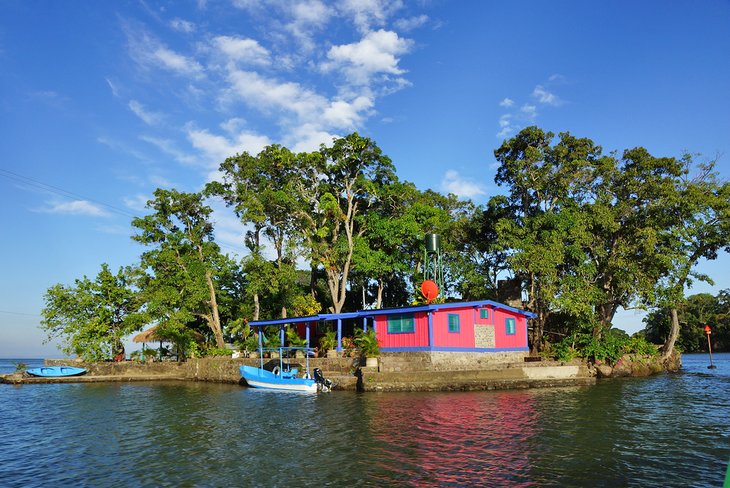
Lake Nicaragua is home to 365 small islands that form an archipelago known as Las Isletas or Islets of Granada, due to their location southeast of the colonial city of Granada. The islets are more than 25,000 years old, initially formed from the ash and stones of the Mombacho volcano .
While some islets are deserted, others have limited development, mostly in the form of ecolodges. Jicaro Island Lodge is one such place. The boutique property is truly special, a place where you can disconnect to reconnect with nature. And you can explore the other islets by SUP board or kayak from the dock at Jicaro if you're staying here.
The accommodation at Jicaro Island Lodge is in two-story wooden treehouses that have an indoor/outdoor vibe and truly feel like sleeping in the midst of the jungle (but are protected from mosquitoes and other biting bugs).
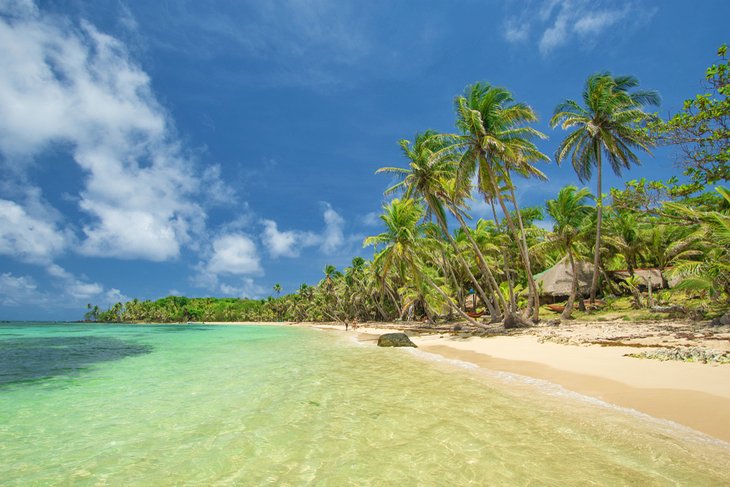
In the Caribbean Sea, about 70 kilometers off Nicaragua's east coast, the Corn Islands are where to go for a laid-back holiday. Big Corn is where you will usually arrive (there are flights from Managua), but you can sleep on either isle.
Despite its name, the Big Corn is actually quite small, and you can bike around it in about an hour. The beaches here are beautiful, light-gold-sand affairs fronted by crystal-clear, turquoise water that stays warm year-round.
From Big Corn, it is a 40-minute boat ride to Little Corn . The tiny island has some accommodation and eating options but no banks or vehicles. You can walk around Little Corn in less than an hour.
There is excellent diving in the reefs off both the Corn Islands, which is why many people visit.
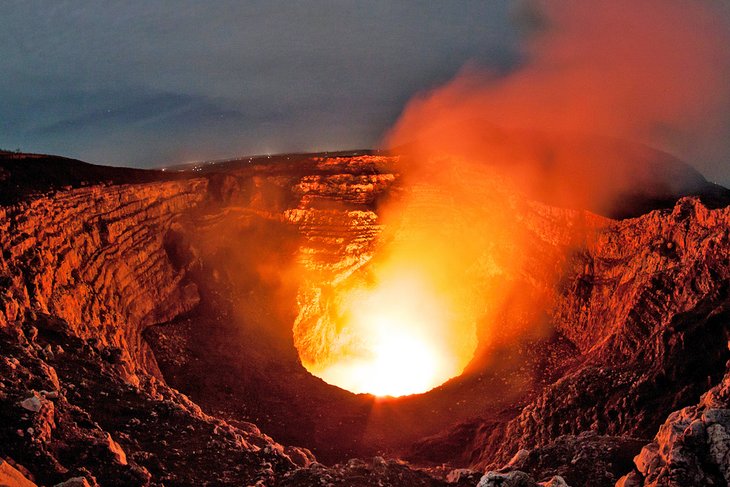
Protected in the country's largest national park, the Masaya Volcano is also one of Nicaragua's top places to visit, just 20 kilometers south of Nicaragua's capital city of Managua.
The most amazing part about visiting this active volcano is how close you can get to the lip of the crater in a private vehicle - you simply drive right up to the edge and park, although you have to park facing downhill in case an emergency evacuation is necessary.
Looking down into the crater, you can see a lake of molten lava. Visit after dark to see the glow the bubbling lava creates inside the pit. If you visit during the day, there is a museum on-site, as well as picnic facilities.
The volcano can be visited on a day trip from Managua or Granada .
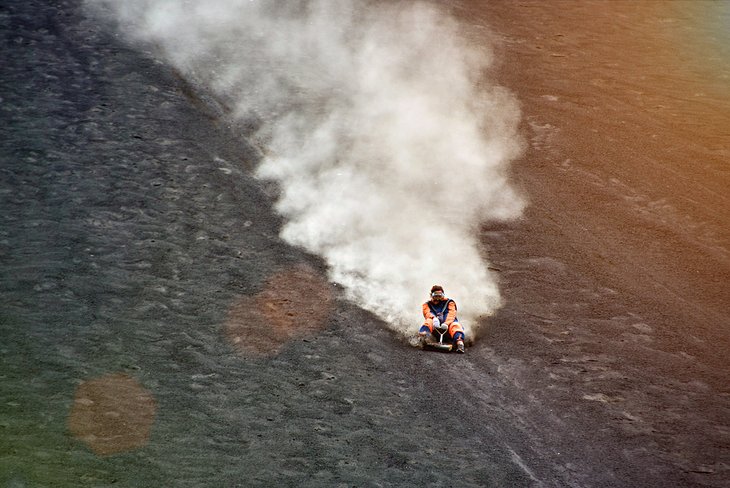
If you want to get your adrenaline pumping a bit then head to Cerro Negro. One of the youngest volcanoes in the world, it last erupted in 1999 and features a dramatic black cone.
While it's still considered active, today most people head to Cerro Negro to try their skills at volcano surfing. The sport involves riding down the side of the volcano's black ash on a wooden surfboard. You'll be wearing a boiler suit and goggles for protection, and you can reach speeds of upwards of 60 miles per hour. The boards can either be ridden sled style (sitting down) or standing up like a surf or snowboard.
Note that to ride down the volcano, you have to hike up. The trek takes about 40 minutes. Most people try this on an organized adventure tour.
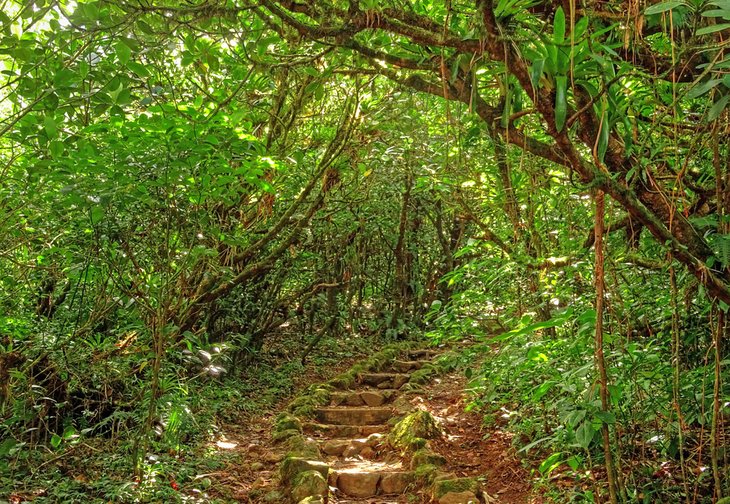
Located atop the dormant Mombacho Volcano, this nature preserve includes a unique cloud forest landscape and covers 2,500 acres. It sits to the southwest of Managua , just 10 kilometers from the colonial town of Granada and magnificent Lake Nicaragua .
Surrounded by rural farms and coffee plantations, the landscape is beautiful. The reserve is known for its prolific, colorful and fragrant flora, with more than 800 species of plants growing here.
There are also hundreds of animal species making their home on Mombacho, including the bright red and green quetzal bird and a number of monkey species such as white-faced monkeys and howler monkeys. The best way to experience the preserve is on one of the many hiking trails running through it.
The reserve is also home to a tourist center, where you can pick up a guide to hike around one of the four volcanic craters, all covered with a rare type of cloud forest that is only found in one other spot in Nicaragua: the Maderas volcano on Ometepe Island .
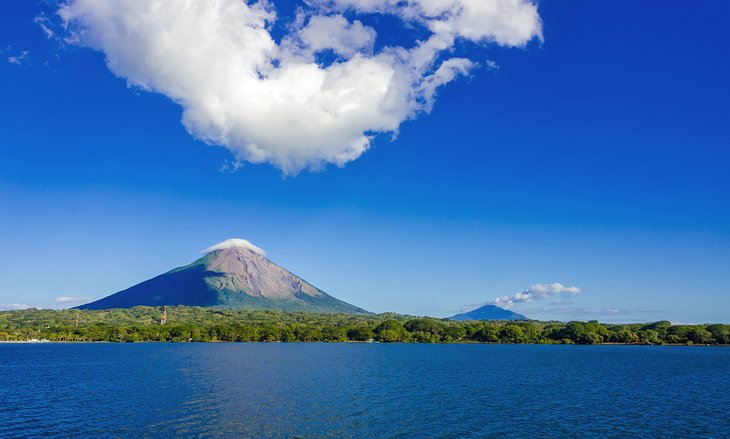
When Spanish colonists first saw Lake Nicaragua, it was so vast, they thought it was a sea. In reality, it is Central America's largest lake at 177 kilometers long with an average width of 57 kilometers. It is home to more than 365 small islets and larger islands, like Ometepe, with two volcanos, in the lake's center.
Another interesting fact about Lake Nicaragua is that it is the only freshwater lake to have ocean animals, including sharks. It is believed the lake was once a sea bay, but then a volcano erupted, trapping marine life and turning it into an inland lake. Over the millennia, the marine life has adapted to living in freshwater.
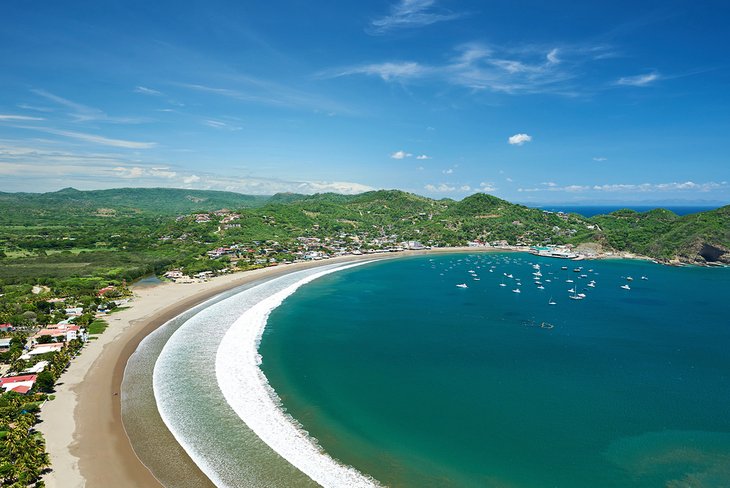
In southwest Nicaragua, on the Emerald Coast, near the border with Costa Rica , San Juan del Sur is a vibrant town with a large expat community and an excellent surf beach just 20 miles to the north. The town itself is filled with colorful buildings and murals. There is also a large Christ of the Mercy statue perched on a hill overlooking the city below that is worth a hike up for sunset, especially to experience the views.
And then there is the long gold-sand meets Pacific Ocean Playa Maderas beach, which is also lined with small hotels and eco-resorts. It picks up most of the swells that hit Nicaragua and is best approached at medium to high tide.
The beach is also known for its long, drawn-out sunsets with an amazing display of bright, shifting colors.
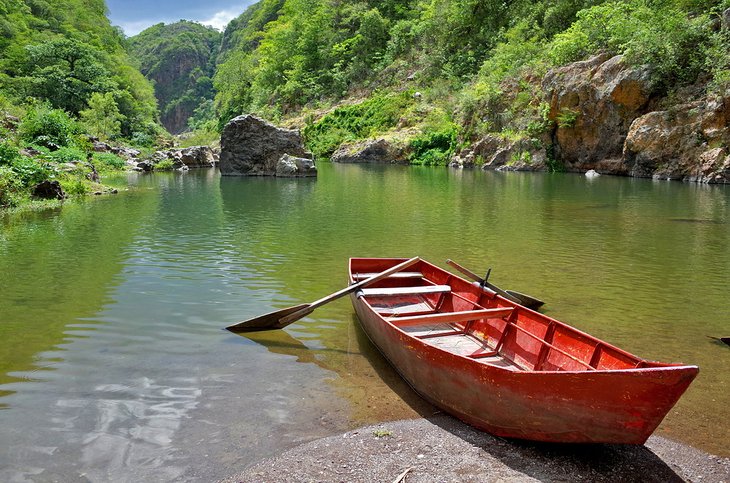
Discovered accidentally in 2004 by two Czech geologists, Somoto Canyon National Monument is now a protected gorge in northern Nicaragua about 2.5 hours from Leon .
The scenery here is stunningly beautiful, and this is also another perfect destination for adrenaline addicts. You can book four- or six-hour descents of the narrowest section of the gorge. Both trips require rock scrambles, floating down rapids in inner tubes, and jumping from high cliffs into deep pools. The six-hour trip also includes rappelling down cliffs into bat-filled caves. Either way this is an adventurous day trip.
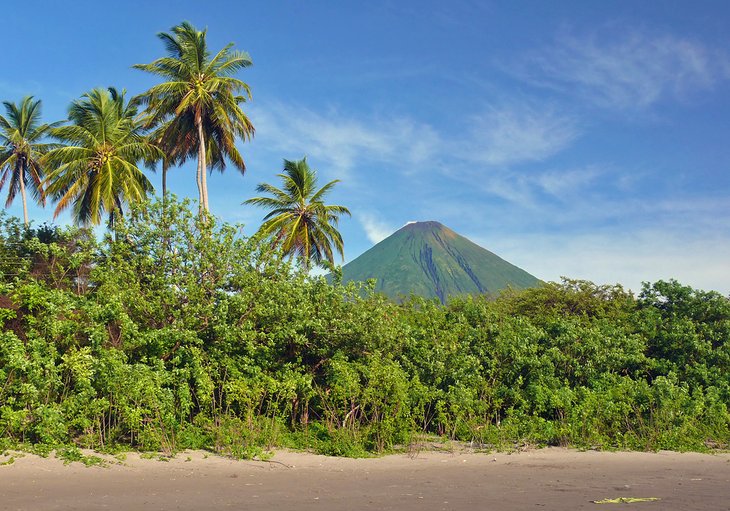
Isla Ometepe is in Lake Nicaragua, the largest freshwater lake in Central America and also home to the Islets of Granada. The island has not one but two volcanos, both of which can be climbed.
Maderas is the volcano in the south of Ometepe, and it is less active than the Concepcion volcano in the north. The hike to the summit of Maderas takes you to a beautiful crater lake. There is also an impressive waterfall at the base that cascades for almost 50 meters down a sheer rock wall.
The island is also popular for horseback riding, mountain biking, or kayaking the Istian River that runs through it. You can also just laze on the white sands of Santo Domingo beach.
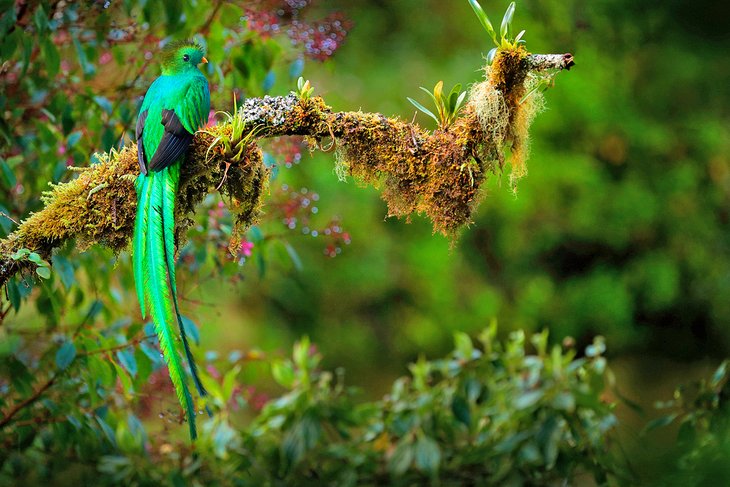
Second only in size to the Amazon rainforest in Brazil, Nicaragua's Bosawas Biosphere Reserve was established in 1997 to protect the biodiversity found in this northern corner of the country. The reserve also protects the free flow of species between Mexico and Central America.
A birder's paradise, you'll find that 600 of the 790 bird species that call Nicaragua home live in this reserve. You'll also find plenty of mammals, including jaguars, Baird's tapir, and spider monkeys in the trees and on the forest floor.
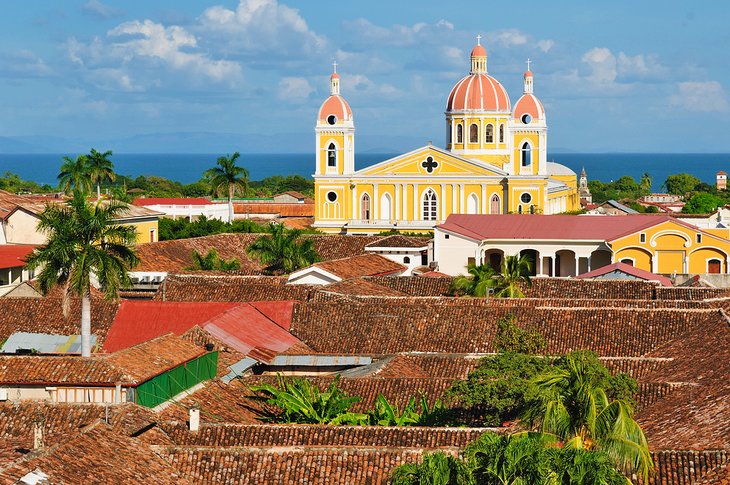
Colorful Granada is a wonderful old city to wander for an afternoon. It is home to some of the best-preserved architecture in Nicaragua, including a number of buildings and churches constructed in Spanish colonial style.
Here, you'll find Convento San Francisco , which is one of the oldest churches in Central America. It has an unmissable Tiffany blue facade, and inside, you'll find one of Nicaragua's top museums, dedicated to the country's pre-Columbian people. There are also restaurants, shops, and coffee houses with sidewalk seating around its main square.
Granada is a popular base for exploring the islands in Lake Nicaragua on whose shore it sits.
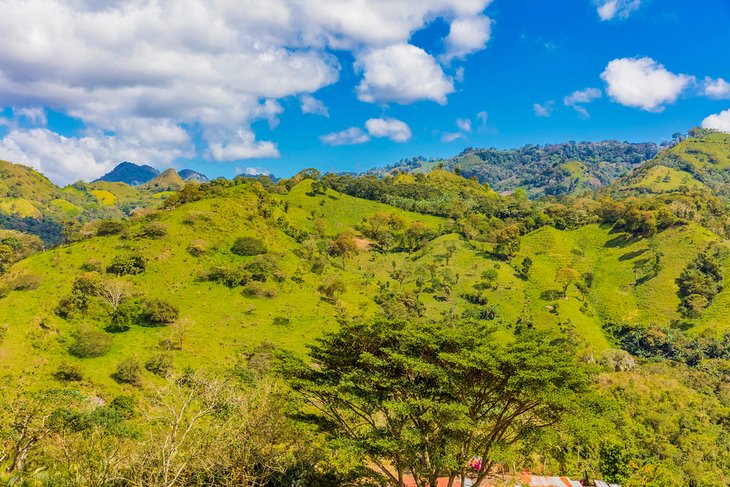
From cooling off under icy waterfalls to horseback riding or trekking in search of some 300 species of birds that live here, including the bright queen quetzal, there is plenty to keep you naturally entertained at Reserva Natural Miraflor.
This reserve in Nicaragua's north covers three climate zones, including dry forest and cloud forest. Visitors can also participate in community tourism projects here at coffee cooperatives. These give you a chance to spend a night with a local family and get a glimpse into their culture and way of life.
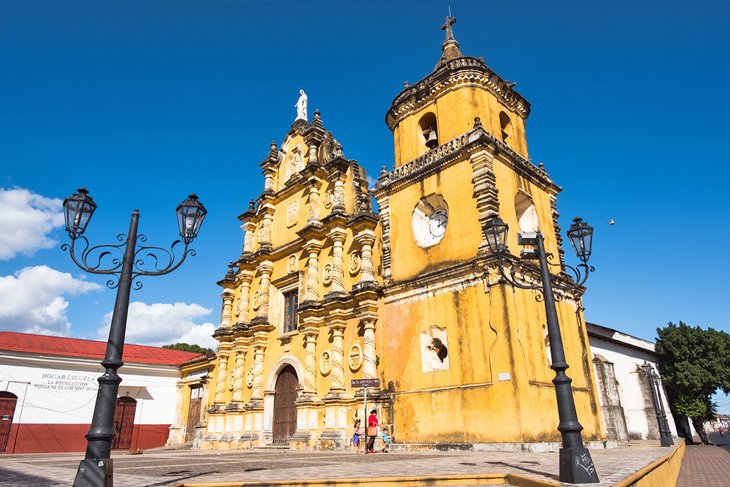
Home to Nicaragua's National University , Leon is considered the country's intellectual capital. The city is also known for its cathedral, art museums, and growing food scene. Leon's cathedral is Central America's biggest, and merges Baroque and Neoclassical styles.
Just a few blocks north of the cathedral is Iglesia de la Recoleccion , which is a beautiful church dating back to 1786. It is built in Mexican-style Baroque design and features a distinct, deep-yellow facade with cream trim. While strolling the walkable downtown, also keep an eye out for murals and graffiti dating back to the political war of the 1980s.
You can also visit the 16th-century ruins of Leon Viejo (old Leon), a UNESCO World Heritage site, and one of the first Spanish colonial settlements in the Americas. These ruins are just a short drive from Leon.
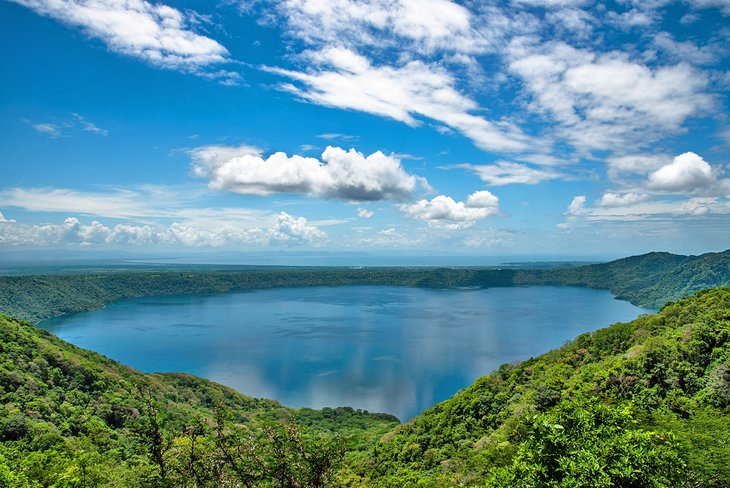
Less than a 30-minute drive from Granada , Apoyo Lagoon Natural Reserve is a giant volcanic crater lake that was created more than 20,000 years ago when the original volcano's cone imploded.
The lake is about 198 meters deep and is so big that when the wind blows hard enough, there are waves big enough to windsurf. The lake is also fed by volcanic fumaroles that keep the water warm and slightly salty.
Activities include kayaking, swimming, scuba diving to explore thermal vents, or just chilling at one of the restaurants on the beachfront.
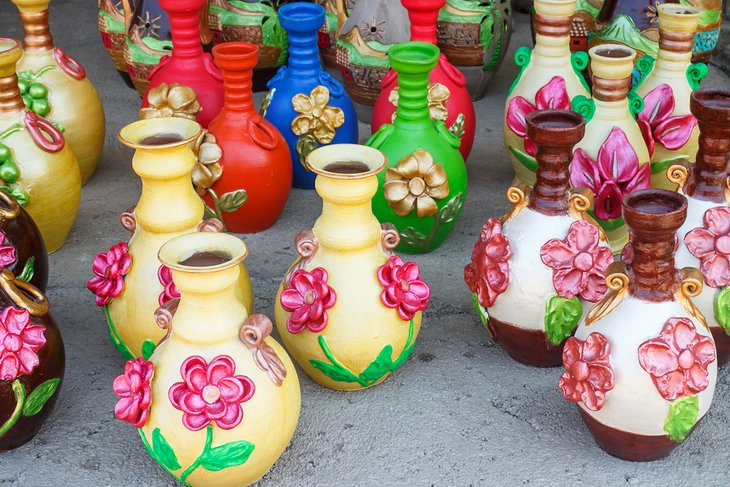
If you are in the market for ceramic handicrafts , whether in the form of ornately decorated vases or functional cookware, pay a visit to the village of San Juan de Oriente. Located about 45 kilometers from Managua, it is known as the "town of potters," and the artisans here have been creating beautiful pieces out of clay since before the Spanish conquistadors invaded the region.
Upon entering the small town, which has a beautiful setting overlooking the Masaya lagoon, you'll see dozens of pottery shops . The majority of people here earn their living creating colorful works of art and are very friendly and happy to share their work and the stories behind it with travelers. Most of the shops are family-run affairs, with one member in charge of the carving and design, another overseeing the kiln, and a third polishing the finished product.
Some names to look for while shopping include Gregorio Bracamonte's recreations of pre-Columbian jaguar vases (the artist passed away in 2019, making his work even more valuable today); and Helio Guitérrez, who is known for his bold geometric designs.
For working kitchenware that includes intricate designs, visit Miguel Angel Calero's shop. His pieces are also known for their highly polished, glass-like shine, and he has been called a local Michelangelo.
More Related Articles on PlanetWare.com
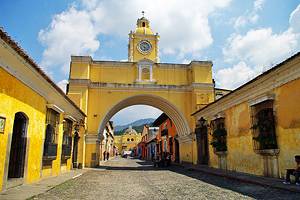
Central America: This part of the world offers many great adventures and intriguing destinations. To the south of Nicaragua, Cost Rica is fill with natural attractions, beaches, and incredible opportunities to see wildlife. Also worth checking out in Central America are the sights of Guatemala . Lakes, volcanoes, culture, and history make this a country worth working into your itinerary.

- 3.1 Itineraries
- 4.1 Climate
- 4.2 Terrain
- 4.3.1 Early history
- 4.3.2 Somoza and the Sandinistas
- 4.3.3 After the Contra War
- 4.4 The Nicaragua Canal
- 4.6 Units of measurement
- 4.7 Visitor information
- 5.1 Visa regulations
- 5.2 By plane
- 5.5 By boat
- 5.6 By train
- 6.2 By plane
- 6.3 By boat
- 6.4 By taxi
- 6.5 By motorcycle
- 6.6 By bike
- 6.7 By thumb
- 9.1 Baseball
- 10.2 Souvenir purchases
- 10.3 Taxes and tips
- 11.2 Shopping for groceries
- 17 Stay safe
- 18 Stay healthy
- 20.1 Embassies
- 20.2 Newspapers
Nicaragua is the largest country in Central America by area and the least densely populated. Nicaraguans (or "Nicas" as they are often called) like to refer to their country as the "país de lagos y volcanes"; the country of lakes and volcanoes. And those are indeed striking features as Nicaragua contains the largest freshwater body in Central America, Lake Nicaragua or Cocibolca . Inside Lake Nicaragua the famed Volcano Concepcion on Ometepe rises to about a mile in altitude, but other volcanoes such as Momotombo or Mombacho are also impressive.
Regions [ edit ]

Cities [ edit ]

- 12.154372 -86.273767 1 Managua - capital leveled by a 1972 earthquake and decried as bland, slowly coming into its own again
- 12.434825 -86.878833 2 León - colonial city, famous for students, leftist politics and its large cathedral
- 11.93035 -85.953592 3 Granada - charming colonial beauty, favorite with tourists and expats
- 11.973617 -86.096058 4 Masaya - pre-colonial city with a famous artisan market and easy access to the Pueblos Blancos
- 13.093092 -86.355447 5 Estelí - enjoy the many murals and the surrounding nature reserves
- 12.928525 -85.917436 6 Matagalpa - sip coffee where it is grown in this "Northern Pearl" with eternal spring
- 13.091008 -86.002361 7 Jinotega - coffee city in the mountainous north, with a cathedral and beautiful Lago Apanás.
- 12.013125 -83.764911 8 Bluefields - the biggest city on the Caribbean Coast and a major travel hub
- 11.132503 -84.771692 9 San Carlos - gateway to the Rio San Juan region
- 11.254197 -85.872281 10 San Juan del Sur - surfer town, party mecca and an anchoring point for large cruise ships
Other destinations [ edit ]

- 11.493333 -85.5615 1 Isla de Ometepe - spectacular island with two big volcanoes
- 11.922 -86.029 2 Laguna de Apoyo - crater lake and nature reserve with dark sand beaches
- 11.982778 -86.161944 4 Volcan Masaya - drive or climb up this smoke emitting volcano in Nicaragua's oldest national park
- 12.17465 -83.060375 7 Big and Little Corn Islands - Caribbean islands with diving, relaxing and fishing with no cars on the little one
- 12.3428 -83.671431 8 Pearl Lagoon - chilled out Caribbean town on a beautiful lagoon with the same name
- 11.042603 -84.472283 9 El Castillo - old Spanish fortress on the Rio San Juan and a good entry point for the nearby jungle
- 11.2 -85.033333 10 Solentiname Islands - a group of islands in Lake Nicaragua famous for their naive painting and balsa figurines
Itineraries [ edit ]
- Ruta del Tránsito
Understand [ edit ]
Nicaraguans like to call their country "país de lagos y volcanes" - Land of lakes and volcanoes and this certainly an apt description of the overall layout, particularly of the Western half of the country.
Climate [ edit ]
Temperature is most influenced by altitude. On the Pacific side there is a pronounced dry (November-April, known locally as "verano") and rainy season (known locally as "invierno") but the further east you got the longer the rainy season becomes and the rainier the dry season gets. Torrential downpours in the rainy season (May–October) can catch you by surprise and soak you within minutes, even in the Pacific lowlands, so be prepared if you're traveling during the rainy season. In the Northern Highlands cloud forests dominate and thus cold, foggy weather is no rare occurrence. Temperatures might drop to the tens Celsius in the early morning hours on high altitudes but snow is unheard of. The Caribbean coast is overall much wetter with rain a common occurrence even in the "dry" season. The last devastating hurricane to hit Nicaragua was Mitch in 1998 and the country is generally not in the main pathway of hurricanes, but you should still heed warnings and absolutely evacuate at the very least to the Pacific side if there is any chance of a hurricane hitting the place you're in. Hurricane Otto, which hit the country and neighboring Costa Rica in November 2016 left no dead and less destruction than feared, and showed that Nicaragua is now better prepared for natural disasters than in the past.
Terrain [ edit ]
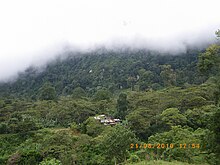
Nicaragua has an area of 130,373 km 2 . The most noteworthy features of Nicaragua's geography are visible at a glance: Lake Nicaragua in the southwest with a mostly low lying plain west of it that experiences dry seasons and has historically been the densest populated and most agriculturally used part of the country. In the north, high mountains gave rise to coffee and tobacco farming and this is where the country is at its coldest and also where most historical guerrillas be they Sandinista or Contra, found their hideouts. From northwest to southeast a spine of mostly active volcanoes stretches through the country - including Lake Nicaragua - with the volcano Cosigüina at the heart of the eponymous peninsula marking the northwestern-most end of this volcanic chain and the Solentiname islands the southeastern-most feature of volcanic origin in the country. The east of the country is dominated by tropical rainforest and has historically been sparsely populated. In the south the Rio San Juan meanders through a mostly low-lying plain with rainforest to either side while in the north the Bosawas rainforest begins in the foothills of the northern highlands and stretches almost all the way to the coast. The highest altitudes in the country are found in the north with the highest mountain - Cerro Mogoton (2,107 m; 6,912 feet) - sitting at the border with Honduras. The longest river of the country and all of Central America is the Río Coco or Wanki which forms the border between Honduras and Nicaragua for most of its length. Similarly the Rio San Juan forms the border with Costa Rica, though due to a 19th-century treaty the river belongs entirely to Nicaragua. The Rio San Juan is often considered a national symbol by Nicaraguans, not unlike the German fascination with the Rhine in the 19th century, but due to its historical inaccessibility (before a new road was constructed the trip from Managua would take 12 hours by bus), few Nicaraguans know the river first-hand.
Nicaragua's capital and largest city is Managua . Somewhere between a quarter and a third of the Nicaraguan population lives in or around the capital and it is thus the largest city and metro-area in mainland Central America , behind Guatemala City.
History [ edit ]
Early history [ edit ].
Although Columbus (known in Spanish as Cristobal Colón) made landfall in northeastern Nicaragua on one of his voyages, it was the western half of the country that first drew Spanish attention. The Conquistadors wreaked havoc on most indigenous civilizations through war, assimilation, enslavement, disease and deportation, however traces of indigenous cultures are still very visible in many aspects of modern Nicaragua. Nicaragua became a Spanish colony and cities such as Granada (one of the first European cities in the Americas that lasted) or its rival León were founded for administrative purposes, among others.
Nicaragua declared independence from Spain in 1821 becoming part of the short-lived first Mexican empire for two years before joining the (also short-lived) United Provinces of Central America; by 1838 upon the breakdown of this attempt at Central American Unity, the country became fully independent. The Caribbean Coast came under British control and remained a protectorate administered by the local Miskitos on behalf of the British until liberal general and President José Santos Zelaya conquered the area, which was subsequently named (and is still known to some Western Nicaraguans as) "Zelaya department". However, British, Miskito and general indigenous influence is still very visible on the Caribbean coast and Creole English is still spoken in places like Bluefields or Corn Island.
It was also roughly in this time (the 1850s) that Nicaragua became a major transit country for people wishing to get from the US East Coast to the West. American railroad and steamboat tycoon Cornelius Vanderbilt invested in the Ruta del Tránsito , and travelers such as Mark Twain passed along it.
The US Marines invaded Nicaragua several times. The invasions were almost always justified with domestic strife between conservative and liberal factions, but the US also tried to install leaders on friendly terms with them and - more importantly - their banana business. One of the cities that witnessed an invasion was San Juan Del Sur. General Sandino, seeing the US as invaders, took the war to them. This occupation lasted roughly six years, until the Marines withdrew from the country in 1933. Sandino is credited with the withdrawal of the Marines, but the change in Washington (from Hoover to Roosevelt) and the great depression certainly did not increase the US's will to occupy the country indefinitely. Sandino's victory was, however, short-lived, as the US changed its tactic from direct occupation to supporting a regime favorable to their aims through more indirect means.
Somoza and the Sandinistas [ edit ]
The mid third of the 20th century was dominated by the rise and fall of the Somoza dynasty. Anastasio Somoza Garcia seized power as the head of the Guardia Nacional (National Guard), which remained the center of power for all the Somoza years, after murdering Sandino after a peace-dinner held in his honor in 1934. Educated in the US and trained by the US Army, he was adept at managing his relations with the United States. Somoza is one of a few Latin American strongmen to whom the semi-anecdotal quotation from U.S. President Franklin D. Roosevelt "our son of a bitch" is said to refer. After his own assassination at the hand of Rigoberto Lopez Perez, Somoza García was succeeded by his sons, Luis and Anastasio Jr ("Tachito") Somoza Debayle. While the Somozas did not hold the presidency at all times, it was clear to everybody who the real power was at any given time.
The Somozas came to power claiming to be liberals and much of their opposition in the early days came from the conservative camp and the political dynasty of the Chamorros. Somoza soon consolidated support from the business sector by either buying off or expropriating anybody who might threaten his family politically.
While the reign of the Somozas did coincide with a period of relative prosperity and a small urban upper class could live comfortably as long as they did not run afoul of the regime, the Somoza family embezzled very close to everything, amassing land holdings the size of El Salvador and stifling development in some sectors of the economy to benefit their own ventures. Somoza Garcia for example let the national railway rot because he was the middle man for all importation of Mercedes buses and the railway was unwelcome competition. The railway never recovered from that neglect and what remained after Somoza's fall and 11 years of civil war was literally sold for scraps in the 1990s.
Luis Somoza's reign is often described as relatively liberal and open-minded compared to the more dictatorial approach of his father and his brother, but when he died in office of a heart attack his brother took over completely, after he had already been head of the national guard and highly influential before. By 1978, opposition to governmental manipulation and corruption (the last straws might have been the blatant embezzlement of relief funds after the 1972 Managua earthquake and the murder of popular anti-Somoza journalist Pedro Joaquin Chamorro in 1978) had become commonplace and resulted in decisive anti-Somoza military campaign that managed to take Managua and topple Somoza on July 19, 1979, a date that is still celebrated every year by the Sandinistas.
The most notable anti-Somoza movement were the Sandinistas, named after the liberal general of the 1930s and fighter against the US marines, Augusto César Sandino. Due to the nature of the Sandinista government, with their social programs designed to benefit the poor majority, their support for rebels fighting against the military government in El Salvador , and their close alliance with Cuba , the right-wing US President Ronald Reagan considered them a threat, and at his administration's insistence, guerrilla forces (Contras) were organized, trained, and armed throughout most of the 1980s. Unwise policies by the Sandinistas (e.g. the literacy program was to be conducted only in Spanish) also led to a disaffection of the indigenous groups on the Caribbean coast, but a cease-fire of sorts was reached in the early 1980s, when the Sandinistas formed the RAAN and RAAS autonomous areas. To this day many indigenous leaders are wary of the Sandinistas in general and Daniel Ortega's government in particular, although there have been tactical alliances from time to time.
After lengthy negotiations a peace accord was reached in 1987, and a peace treaty was drafted by Costa Rican president Oscar Arias Sanchez who won the Nobel Peace Prize for his efforts. To the surprise of many, Violeta Barrios de Chamorro, widow of Pedro Joaquin Chamorro of the UNO (Union Nacional Opositora) coalition beat Daniel Ortega and the Sandinistas. Contributing factors in Ortega's defeat may well have been the turning international tides, the public's weariness of military service and the bad economic situation (mostly caused by the war).
After the Contra War [ edit ]

Ortega and the Sandinistas lost the 1996 and the 2001 elections to liberals Arnoldo Alemán and Enrique Bolaños respectively. During the 1990s the country's economic policies changed direction, aiming to transform Nicaragua to a market economy through privatization and other aspects of the neoliberal economic program. However, the Sandinistas, still led by Daniel Ortega, returned to power in elections in 2006 when the liberals split the vote. Ortega won with 38% of the vote in the first round after a constitutional amendment eliminated the second round. He won again in 2011 with allegations of vote fraud stemming from his party's sudden increase to 62% of the vote, a number the party hadn't even come close to in all prior peacetime elections. The main right-wing newspaper La Prensa still grumbles about the constitutionality of Ortega's reelection as more than two terms and two continuous terms had been prohibited by the constitution until a controversial supreme court decision ruled that provision of the constitution unconstitutional. In the November 2016 elections Ortega was reelected with his wife, Rosario Murillo now elected vice president amid allegations of fraud and a partial boycott by the weak and fractured opposition.
Unlike the Marxist atheist radical Ortega portrayed himself as in the 1980s, Ortega has significantly changed his public image. He had reconciled with the Catholic Church and erstwhile anti-Sandinista Cardinal Miguel Obando y Bravo, who now even appears on Sandinista campaign billboards. As part of the reconciliation Ortega now enjoys support from some that had taken up arms against him in the 1980s. Many former comrades - including his erstwhile Vice President Sergio Ramirez - denounce him as a sellout, dictatorial and corrupt. Ortega has also become much more business-friendly, paying lip-service to a "mixed economy" with private and government-owned enterprises side by side, while allowing rather free rein to private business, which has been credited with solid growth figures barring the years after the 2008 recession. Ortega's wife, Rosario Murillo, is very much a public figure and current Sandinista PR is significantly influenced by her. Ubiquitous Sandinista propaganda designed by her include billboards with the faces of Sandinista leaders and a yearly slogan or "arboles de la vida"; stylized metal trees that can be seen all over Managua. Political passions can run high and as an outsider it is best if you listen politely but don't volunteer your opinion unless asked.
Nicaragua has suffered from natural disasters in the past. Downtown Managua was all but leveled in 1972 by an earthquake, which killed more than 10,000 people. In 1998, Nicaragua was hit hard by Hurricane Mitch. Nicaragua remains the second poorest country in the western hemisphere after Haiti. Rapid growth in sectors such as tourism, and a better crime and security situation than its northern neighbors give reason to hope for a better future.
The Nicaragua Canal [ edit ]
Since the Spanish were able to make out the general geography of the country, there have been proposals to build a canal to link Atlantic and Pacific. Besides several routes through Panama, Nicaragua seemed an obvious choice, as the Rio San Juan already connects lake Nicaragua to the Caribbean and the lake's western shore is only about 20 kilometers from the Pacific at the narrowest point. However, from a 21st-century standpoint, the Rio San Juan is hardly navigable (the rapids close to El Castillo cannot be passed by anything much bigger than a lancha), and the average depth of lake Nicaragua is less than 15 meters, much less than the displacement of many modern container-ships. However the dream has always remained in the national consciousness. It was somewhat of a perennial issue in national politics until the early 2010s when President Ortega signed a contract (later approved by the Sandinista-dominated national assembly) with a Chinese company to build the canal. Construction began in December 2014 (though the actual extent of the works undertaken is not entirely clear to the public). The contract includes an airport, two deep water seaports and a major tourist facility on the Pacific side. The project is very controversial domestically and abroad, so expect a lot of media coverage on the issue in years to come.
People [ edit ]
There are about 6.1 million Nicaragüenses (often shortened to Nicas) in Nicaragua. The majority of the population is mestizo (roughly 70%) and white (roughly 17%). Nicaraguan culture is heavily influenced both by European and by Amerindian customs and traditions with some African elements on the Caribbean coast. Most Nicas are monolingual speakers of Spanish and roughly 90% understand it, but other languages are (in descending order of speakers) Miskito, Creole English, English, Chinese and Sumo. The biggest minorities all live on the Caribbean side of the country and include the Miskito (indigenous, formerly an ally of the British), the Garifuna (of indigenous and African ancestry) and the Rama people. Some of them speak indigenous languages or Caribbean Creole English. To this day conflicts arise from people of mestizo origin moving to the East of the country and appropriating land where indigenous or afrodescendent people had lived or violently expulsing them. Immigrant communities are usually minor in size but the German-Nicaraguan community was economically important in the coffee business until Somoza expropriated them as a "war measure" in World War II (which Nicaragua "fought" on the allied side). Other immigrant communities include Chinese-Nicaraguans and Afro-Nicaraguans. Sizeable expat communities have arisen in cities like Granada, however, immigration was always and still is dwarfed by emigration.
Because of economic and political reasons many Nicaraguans have left their country in the last decades - primarily to the US and Costa Rica. About 500,000 to one million Nicaraguans now live and work in Costa Rica, not all of them legally, which has caused tensions both on a personal and on a diplomatic level between the two countries. The Nicaraguan diaspora in the US consists of both political emigres not unlike the Cuban population of Miami and economic migrants. However, unlike its neighbors emigration to the US is neither as prevalent nor as culturally dominant a phenomenon as the presence of Latinos in the US might indicate.
Units of measurement [ edit ]
Although Nicaragua officially uses the metric system, some customary Spanish units as well as some American units are commonly used in everyday parlance and even by vendors and the like. A common unit of distance is the "vara" which is often given in approximations for distances when giving directions. Though the actual length of a vara is said to be a yard, it can in actual use range somewhere between half a meter and more than one meter. If asking for directions or distances try asking how long one would walk there unless it is a long distance as most Nicaraguans don't own cars and are thus not all that familiar with estimating large distances.
A common unit for volume is the American fluid ounce and beer is often sold in 12-oz bottles (354ml, sometimes "metricized" as 355ml). If you see 12 oz and a price quote (or "doce onzas") it usually refers to the beer bottle of that quantity. Gallons are also sometimes used for large amounts of water. For more on American units see Metric and Imperial equivalents .
Weight is preferably measured in (imperial) pounds, roughly equal to 450 grams (and not metricized as 500 grams). Other units are the large quintal and arroba that are used for the price of commodities like sugar and coffee as quoted in newspapers.
Visitor information [ edit ]
- Nicaraguan Institute of Tourism
Get in [ edit ]
Visa regulations [ edit ].
Citizens of the following countries/territories can enter Nicaragua without a visa: Andorra , Anguilla , Antigua and Barbuda , Australia , Austria , Bahamas , Bahrain , Barbados , Belgium , Belize , Brazil , Brunei , Bulgaria , Canada , Costa Rica , Croatia , Cyprus , Denmark , El Salvador , Estonia , Eswatini , Falkland Islands , Finland , France , Germany , Gibraltar , Greece , Guatemala , Holy See , Honduras , Hong Kong , Hungary , Iceland , Ireland , Israel , Italy , Japan , Kuwait , Latvia , Lithuania , Liechtenstein , Luxembourg , Macao , Madagascar , Malaysia , Malta , Marshall Islands , Mexico , Monaco , Netherlands , New Zealand , North Macedonia , Norway , Paraguay , Panama , Poland , Portugal , Qatar , Saint Kitts and Nevis , St. Lucia , Saint Vincent and the Grenadines , San Marino , Singapore , Slovakia , Solomon Islands , South Africa , South Korea , Spain , Saint Helena, Ascension and Tristan da Cunha , Sweden , Slovenia , Switzerland , Taiwan , Turkey , Trinidad and Tobago , Tuvalu , United Kingdom , United States , Vanuatu , the Vatican City (Holy See) and Venezuela .
Visitors must obtain a Tourist Card for US$10 valid for 1 month to 3 months (depending on citizenship - Canada and USA are allowed 90 days) upon arrival, provided with a valid passport with at least six months to run. (Citizens of El Salvador , Guatemala and Honduras are exempt from the Tourist card requirement.)
There is also a US$32 departure tax which is included in airfares with major airlines (American Airlines, Copa Airlines and Avianca definitely). The tourist card is valid in the other CA-4 countries, El Salvador, Guatemala, and Honduras, although it sometimes requires a discussion with immigration officials that this accord is in effect, since they are quite compelled to sell more tourist cards.
Getting into Nicaragua - especially for foreigners from rich western countries - used to be a breeze, but in the course of the April 2018 protests, the government seems intent on trying to weed out something or somebody among the entering tourist stream, even though it has thinned to a trickle. It appears that anti-government social media posts and/or any hint of you being a journalist could get you delayed at the border or denied entry altogether. In general, checks are more thorough than they were even 2014 and now include a retina scan to compare with your passport data. You'll also be asked your profession and travel plans.
By plane [ edit ]
You will most likely fly into Augusto C Sandino airport in Managua ( MGA IATA ). Flights from the U.S. arrive from Houston , Miami , Fort Lauderdale , and Atlanta . Managua is served among others by American Airlines , United , Avianca , Delta , Spirit , Aeroméxico , and Nature Air [dead link] (from SJO). In addition to domestic flights within Nicaragua la costeña also flies from Tegucigalpa to Managua.
If your intended destination in Nicaragua is in the Rio San Juan region or Southwestern Nicaragua , or if you find a flight that is more favorable to you in some other way, it may make sense to fly to Liberia LIR IATA or San José SJO IATA airport (which is in Alajuela ) in Costa Rica instead. Costa Rica is not part of the CA4, and you will pass through immigration both at the airport and when entering Nicaragua. As San José is served from more destinations outside the United States, this might also make sense if you intend to avoid travel through the United States . If you or someone in your party is a Nicaraguan citizen, do remember to get a multiple entry visa for Costa Rica.
There is an entrance fee to enter the country of US$10, payable in either US dollars or córdobas (C$). Try to have exact change.
Tourist cards are valid for three months for US citizens, and for people from the EU and Canada. There are taxis right outside the airport; however, they are relatively expensive (US$25 for the 20 km trip to downtown Managua). Alternatively, you can walk out to the road and try to flag down a regular cab. Some taxi drivers may try to overcharge, particularly seeing a foreign face, and may start with US$20, but a price around US$5–10 or C$125 - 250 (Nicaraguan córdobas) is appropriate from the airport (depending on the number of people and amount of luggage). Knowledge of the Spanish language is very helpful when haggling with taxis. You can also arrange a shuttle pickup to take you to nearby cities like Granada, a popular option for tourists who do not want to spend a night in Managua. It is recommended to have your hotel or language school arrange a shuttle when possible.
Talks are underway to start international flights to the small airport on Ometepe , which opened in 2014; as of early 2017 however, nothing had come of it. So don't hold your breath.
There are, as of 2015, no regular scheduled international flights to any other airports in the country, although some might be able to accommodate general aviation.
By car [ edit ]

Almost all rental car contracts do not allow you to take your car across the border. If you want to take your own car across the border, it can be done; however, it requires planning and a bit of bureaucracy, as the government tightly controls the used car market and doesn't want you to sell it without paying the proper fees and tariffs. See Carnet de Passage for crossing borders in cars
There are two border crossings to Costa Rica: Peñas Blancas west of Lake Nicaragua, and Los Chiles / San Carlos east of it. While the San Carlos crossing had long been boat only, the bridge opened in 2015 and it is now possible to cross the border by car on the Eastern side of Lake Nicaragua. Peñas Blancas has been the by far busier crossing but the opening of the bridge and the rising tourist profile of the Rio San Juan region might change that. Keep in mind that both border crossings are major bottlenecks for trade between Nicaragua and Costa Rica and there will be quite a few trucks waiting to cross. For the time being the boat route from San Carlos to Los Chiles remains open albeit with more limited departures than in the days of it being the only possible crossing.
There are three major border crossings to Honduras. Las Manos is on the shortest route to Tegucigalpa; the others ones are on the Panamerican Highway north of Leon.
There is a US$12 border crossing fee (usually payable in dollars, córdobas or the currency of the adjacent country). This fee is usually also collected even if you already have a CA-4 visa, though there is no new visa included. The "visa run" to get a new 90 days on your legal stay is thus only possible when going to Costa Rica and it's largely at the discretion of the border officials whether they grant you the twelfth 90-day visa in a row.
By bus [ edit ]
International buses are available between Managua and San Jose, Costa Rica (also stopping briefly in Rivas and Granada), San Salvador, El Salvador (stopping briefly in Leon), and Honduras. Some buses will continue to Panama City or Guatemala City. The buses are relatively modern (many have air conditioning), and make stops for fuel and food along the way. However, if you plan on taking this form of transportation, you should plan ahead: buses between the major cities can fill up days ahead of departure dates. See the following companies: Tica Bus [dead link] and King Quality . Another option is to be picked up in the smaller cities along the route; ask for the local ticket office. There are also cheap (but terribly uncomfortable) "chicken buses" a few times a week between Managua and Guatemala City (US$20), that stop in major cities like Leon.
An alternative way to travel across the border is take a bus to/from a major city that drops you off at the border. You can then cross the border and board another bus. This is a common strategy for travelers, especially on the Costa Rican/Nicaraguan border. This method takes longer, but is much cheaper and can be done on a moment's notice.
When crossing the border from Choluteca, Honduras to Guasaule, Nicaragua, don't be intimidated by the men fighting over your luggage. They will want to take you by bicycle over the border to the bus stop on the other side. Often, if you ask for a price for the ride, they will insist it's for a "tip" or "propina". It's not until you reach the other side that they will try to pressure you into paying US$20 or more. Negotiate with them before you agree to a ride, and if they still pressure you at the end, just give them what you think is fair and walk away.
This border crossing is also your last chance to exchange your lempiras for córdobas, and it's best to know what the exchange rate is so that you can bargain for a fair rate.
Most buses coming from the south enter Nicaragua at Peñas Blancas. There are air conditioned, relatively modern buses from the same companies as for the connection to Honduras; alternatively, you could get on a local bus to the border, cross it on foot, and take a bus or taxi from there. Please remember that the border is the last point to get rid of your Colones, as almost nobody in Nicaragua proper accepts them; if they do, it is only with horrible exchange rates.
Since the bridge across the Rio San Juan opened there have been a few buses doing the Los Chiles (Costa Rica) - San Carlos (Nicaragua) crossing, but overall the hoped for tourism boom has not occurred and most buses are local. There are buses to Los Chiles both direct from San José (Costa Rica) and with a change at Ciudad Quesada (confusingly also known as "San Carlos" among Ticos) and from there you can change to a local bus across the border. As this can be a bit cumbersome, you're probably not going to use that route unless you wish to see the Rio San Juan Region .
By boat [ edit ]
Apart from cruises there are also the following options
With the opening of the new bridge across the Rio San Juan, the erstwhile boat route via the Rio Frio between Los Chiles (Costa Rica) and San Carlos (Nicaragua) no longer sees any scheduled service which is a shame since the trip is quite scenic and the Nicaraguan border guards at San Carlos' lake border used to be quite a bit more relaxed than those at land or air borders.
Reportedly a new regular passenger-ferry now connects La Union ( El Salvador ) with Corinto, Nicaragua.
By train [ edit ]
There are no passenger rail lines between Nicaragua and its neighbors. In fact, you'd be hard pressed to find any train in Nicaragua, as the national railway was closed in 1994, and literally sold for scrap soon thereafter. (The situation isn't much better in other parts of Central America either for that matter.) Talks of ever starting a railway again - whether local or national, whether freight only or for passengers as well - are inconclusive and never get above newspaper articles or speculation by mid-level or retired politicians.
Get around [ edit ]

Bus is definitely the main mode of travel in Nicaragua, and a great way to get to know the country's geography, people and even some culture (music, snack food, dress, manners). Most of the buses are old decommissioned yellow US school buses (though often fantastically repainted and redecorated). Expect these buses to be packed full, and your luggage (if large) may be stored at the back or on the top of the bus (along with bicycles and other large items). You'd better be quick or you may be standing most of the trip or sitting on a bag of beans. On most routes you can purchase your ticket a day or so in advance which will guarantee you a (numbered) seat (look for the number on your ticket and above the windows respectively). Some have not replaced the original seats meant to carry 7-year-olds, so you may have sore knees by the end of the trip. People often sell snacks and drinks on the buses (or through the windows) before they depart or at quick stops. A typical fare may vary between US$1 or less for short (~30min) trips to US$3–4 for longer trips.
Buses in Nicaragua are usually operated by a two-person crew. Besides the driver, on each bus there is usually a younger "assistant" manning the front door; he announces stops, collects fares, and helps passengers to board (often paying particular attention to pretty female passengers). There used to be prepaid cards for buses in Managua, but the equipment was retired in early October 2018.
Most cities in Nicaragua have one main bus terminal for long distance buses. Managua has numerous terminals, each serving a different region of the country depending upon its geographic placement in Managua. Mercado Israel Levites, in the western part of the city, serves cities on the Pacific Coast to the north, e.g. Leon, Chinandega and all points in between. Mercado Mayoreo on the eastern side of the city serves points east, north and southeast, like Matagalpa Rama or San Carlos, Rio San Juan . Mercado Huembes in the southern part of Managua serves points south, like Rivas/San Jorge and Peñas Blancas.
Another method of traveling cross country are minibuses ("microbuses" as they are called). These are essentially vans, holding up to 15 people (some may be larger, shuttle sized). Minibuses have regular routes between Managua and frequently travel to relatively nearby cities like Granada, Leon, Masaya, Jinotepe and Chinandega. Most of these leave from and return to the small roadside microbus terminal across the street from the Universidad Centoamericana (and thus the buses and terminal are known as "los microbuses de la UCA"). Microbuses run all day into the late afternoon/early evening depending on destination, with shorter hours on Sunday, and a definite rush hour during the week as they service nearby cities from which many people commute to Managua. The microbuses cost a little more than the school buses, but are faster, making fewer stops. As with the school buses, expect these to be packed, arguably with even less space as drivers often pack more people than the vehicle was designed to handle. On the other hand, most drivers (and driver's helpers) are friendly and helpful, and will help you store your baggage. They run to the main bus terminals in Leon and Chinandega, to the Parque Central and Mercado de Artesanias (and then leave from another park a couple blocks from there) in Masaya, and to/from a park 1 block from the Parque Central in Granada. There is more limited microbus service to other cities out of their respective bus terminals in Managua.
At the international airport there are two offices right to the right of the main terminal, these offices house the domestic airlines. These are great if you want to get to the Atlantic Coast. Prices change but it takes 1.5 hours to get to the Corn Islands as opposed to a full day overland. If you are trying to save time, then this is the best way to get to the Corn Islands or anywhere on the Atlantic Coast. Destinations include San Carlos, Big Corn Island, Bluefields two of the three towns in the "mining triangle" and new services to Ometepe and San Juan del Norte (Greytown). Planes book out quickly and the allowed baggage is very limited so check whether the saved time is worth the cost and the hassle. For more see their website [dead link] .

It is common for your bags to be searched prior to any boat trip. Rules on what can be in your luggage vary, but on the San Carlos - Ometepe - Granada boat alcoholic beverages are often confiscated upon boarding and handed back to you when you disembark.
Boat is the only way to get to the Solentinames and still the most popular way to get to Isla de Ometepe . High winds and bad weather can cancel ferry trips. That might not be such a bad thing, though, since windy/bad weather can make the ferry trip unpleasant for those prone to seasickness, and many of the boats used to access Ometepe are old, smaller ferries and launches. The fastest route to Ometepe leaves from San Jorge (10 minutes from Rivas and often connecting on the same Managua-Rivas bus) and goes to Moyogalpa. There is a large modern ferry from San Jorge that makes daily trips to the new port of San Jose del Sur close to Moyogalpa. The ferry from Altagracia to San Carlos has been "suspended" for what appears to be indefinite times.
Boat is also a practicable way to get to Big Corn Island . Take a bus to Rama, which is the end of the road. This road is in a good condition and the ride shouldn't be too bumpy. There is a weekly ship with bunk beds to the Corn Islands, and small launches to Bluefields and El Bluff multiple times a day. Or you can get on a speedboat to Bluefields or El Bluff. Catch the boat to the Corn Islands from there, or take a flight out of Bluefields. The first boat from Rama to Bluefields usually leaves at the crack of dawn and makes for a life affirming wet ride. Also, a large cargo boat takes two days returning from the Corn Islands to Rama with an overnight in El Bluff to take on cargo. There is now also a road (but don't expect much) from Rama to Pearl Lagoon, which can also be reached in a launch from Bluefields.
By taxi [ edit ]
You should always clearly agree on a fare before entering the taxi. In most of the country there are flat rates within one city that double at night, but rates in Managua or beyond city limits depend mostly on your bargaining skills. That includes establishing whether you are talking about local currency or U.S. dollars and whether it is per person or for the whole party. Once you are in the taxi all your bargaining power is gone and there are no meters. The taxi drivers in Managua can be aggressive and there are loads so it is easy to find a fare that suits you. Taxis will take multiple fares if they are heading roughly in the same direction. Taxi drivers in all the cities are generally fair and well mannered and a nice way to see local scenery. For fares within smaller cities there is a set fare per person, so no negotiating is needed. In Managua the fare should be negotiated before getting into the taxi, and will increase depending on the number of passengers (in your party, not already in the taxi or getting in later) time of day (night is significantly more expensive) and location (going to or from a nice part of Managua may cost you a little more due to lowered bargaining power). The cheapest fare for one passenger is C$30 (2013), but the same route if you are a party of two may be C$40. A trip all the way across Managua during the day should not be more than about C$60–70 if not coming from or going to the airport. Tipping is not expected (though always welcomed). You can also split the cost of taxi to get to destinations that are close to Managua by like Masaya, if you should prefer to travel with modicum of comfort.
There have been increasing incidents of taxi crime in Managua. The most typical scenario is that an additional passenger enters the cab just a short distance from your pickup, they and the taxi driver take you in circles around town, take everything on you, and leave you in a random location typically far from where you were going. Check that the taxi has the license number painted on the side, that the taxi sign is on the roof, the light is on inside the taxi, and that the taxi operator license is clearly visible in the front seat. You may want to make a scene of having a friend seeing you off and writing down the license number. Care should be taken especially at night, when it may be best to have your hotel arrange a taxi.
You can book a taxi online through TaxiManagua [dead link] . Fares within Managua start at US$20.
By motorcycle [ edit ]
Some of the residents are known to travel on motorcycles, with multiple children with a mom on a single motorcycle in some cases. If you see such a thing on the roads, don't be surprised.
If you ride a motorcycle in Nicaragua, a helmet is required, and driving at night is very dangerous.
By bike [ edit ]
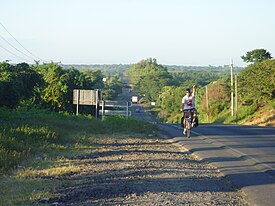
Bikes are a great mode of transport in Nicaragua. They provide a free means of transport while allowing you to stop and see the country that normally would be driven right by. In more rural areas, Nicaraguans are very friendly and helpful, and the roadways, for the most part, allow for bicycles in the shoulders. As riders on horses are known to use the streets, most drivers will know how to deal with a bicycle, although the locals prefer motorcycles, if they can at all afford them. In big cities like Managua, the streets and side walks can be very unsafe for bicycles. Lanes are narrow and not meant for bicyclists. Roundabouts are also very difficult to navigate. Negotiating with traffic is almost impossible and typically best to wait for a clearing in traffic. Sidewalks are uneven and often have poles, potholes or other obstructions for effective riding.
As of 2016 bicycles (fairly similar to cheaper multi-speed US models sold in the US, such as Huffy) are widely used by both urban and rural Nicaraguans; spare parts (tires, inner tubes, pedals) and repair services are available in most towns, even small ones, although sometimes you need to ask around to find them. (e.g., the town's only bike repairman may be working out of his backyard, with no sign on the street). At any rate, knowing how to repair basic defects comes highly recommended, especially if you intend to make overland trips. If you don't already have a bike, cheap bicycles can be bought in most towns of any size, even more remote ones like San Carlos. In cities like Leon or Granada almost every hostel (and a few independent operators) has bike rental for ten dollars a day or less.
Managua now boasts a twice monthly critical mass ride ( Facebook link in Spanish). Every first and third Sunday starting at 15:30 at Plaza Cuba in Managua. In other cities bike advocacy is still in its infancy but car traffic is not as heavy and you should have no major problems getting around on a bike.
By thumb [ edit ]
Hitchhiking is common in more rural areas and small towns, but not recommended in Managua. Nicaraguans themselves usually only travel in the backs of trucks, not inside of a vehicle, when they are traveling with a group of people (3 or more). Some drivers may ask for a little money for bringing you along - Nicaraguans see this as being cheap, but will usually pay the small amount (US$1/person).
Roads on the Pacific Coast are generally speaking in an acceptable condition, though the rains at the beginning of the rainy season can hit roads in Managua paved with cobblestone particularly hard. Roads on the Atlantic side are an entirely different story. There are few paved roads and dirt roads can become impassable during the rainy season. Bring patience and spare tires and plan on taking longer than you would on the Pacific side. City driving is not a good idea in any of the cities, though you have few alternatives to driving in Managua, due to sprawling car-centric layout. If you can, hire a driver or take taxis. Buses are an option for getting around Managua, but only during the daytime. Cities like Granada or León are much more walkable and you should ditch the car rather than trying to navigate the somewhat confusing network of one-way streets.
There are no tolls in Nicaragua and as of October 2016 diesel hovers above C$20 while gasoline (distinguished by octane count into regular and super) costs C$25-30. So compared to the US or Mexico gas at roughly US$4 a gallon can be considered expensive, but it is significantly cheaper than in most of Europe.
There is a general speed limit of 100 km/h on freeways that you really should not exceed, as cows and horses roam the streets as if they owned the place. Inside of cities there is a 45 km/h speed limit and on all other roads it's 60 km/h. Police have a particular skill in filtering out rental cars to collect "fines" from tourists, so drive defensively and within speed limits. The normal procedure for traffic fines is for the cop to collect your licence handing you a ticket, which you take to a bank to pay the fine. The bank will give you a receipt with which you can pick up your license later. However, far from every police officer will follow this standard procedure every time and should you be in a hurry, they are likely able to accommodate you by allowing you to pay on the spot. Haggling about fines does happen, and if your licence has been taken by a police officer you may sometimes get around paying the fine by convincingly arguing your case at the police station.
A particular quirk of the Nicaraguan laws of the road is that you absolutely must not move your car a single inch after you were in an accident. If you do, you will be saddled with full legal liability for all damages. Wait until the police arrive and ask for permission to move your car if you have to. Should you be unfortunate enough to get into an accident resulting in major injury or death, you will be taken into custody until everything is cleared up. In most cases the easiest way out is to take a plea - deal, though you should talk to an attorney first if that happens to you.
Nicaragua has a lot of roundabouts (rotondas) and they serve as local landmarks in Managua. Changing the lane inside a roundabout or shortly before one is illegal and will be fined, especially if you're driving a rental.
Most country's drivers licenses are accepted for up to 30 days. If you intend to stay and drive longer, you would have to get a Nicaraguan driver's license which is only available to citizens and legal residents.
Talk [ edit ]
Spanish is Nicaragua's official language. Do not expect to find much English spoken outside of the larger and more expensive hotels. Creole English (think Jamaican patois to get a first approximation) and indigenous languages are spoken along the Caribbean coast, and in the inland of the remote Bosawas national park (in the east of the country, thus the Caribbean in Managua parlance). Nicaraguans tend to leave out the s at the end of Spanish words, usually replacing it with an "h" sound (j in Spanish). Thus "dale pues" ("alright then", a common term when wrapping up a conversation) becomes "dale pueh". "Vos" is typically used instead of "tú", something that is common throughout Central America. However, "tú" is understood by native Nicaraguans as it shows up a lot in media, songs and books. For a handful of verbs, the "vos" form differs from what would be the "tú" form but you really needn't worry about such nuances. As in most Latin American countries, the plural form "vosotros" is almost unheard of outside of the Bible. When addressing a group, "ustedes" is the preferred form. Unlike modern English, Spanish distinguishes between different levels of formality through pronouns and verb forms - to be on the safe side use "usted" (the polite form) unless specifically told otherwise. Usted takes third person verb forms.
Nicaraguans, especially poorer people in more rural areas, sometimes spell words phonetically rather than the way they appear in a dictionary. This might include signs for small shops. Reading the sign out loud often helps making sense of it.
See [ edit ]
Nicaraguans like to call their country the country of lakes and volcanoes. Some of the most noteworthy volcanoes include:
- Volcán Concepción and Maderas on Ometepe
- Volcán Mombacho near Granada
- Volcán Masaya near Masaya . If it is not considered too dangerous you can drive up by car.
- Volcán Cosigüina that used to be one of the highest in the region but exploded in the 19th century, dotting the Golfo de Fonseca between Nicaragua and El Salvador with many small islets made out of its debris.
Other sights include:
- Wildlife on Ometepe or in the protected areas of Indio-Maiz (southeast, Rio San Juan Region) and Bosawas (northeast, Caribbean Nicaragua)
- Churches en masse especially in León (with one of the biggest churches of central America) and Granada
- Lake-panoramas and sunsets along the shores of Lake Nicaragua (Cocibolca)
- Museums and murals dedicated to the country's revolutionary past and its civil war (especially in Sandinista-strongholds such as León or Estelí)
Thankfully, Nicaragua retains much more colonial era architecture than its southern neighbor, and if you are coming from the south, places like Granada or León can be a breath of fresh air, compared to the rather bland modernist architecture you'll find there.
Do [ edit ]
There is an endless selection of things to do in Nicaragua, but some of the most overlooked are the fiestas patronales or Saint Festivals that happen nearly every day in some town or village in the country. Participating in the fiestas patronales is a great way to really experience the culture of Nicaragua, and such customs such as the dance of the Gigantona and the Los Aguizotes parade are truly unforgettable to see. Unfortunately, it can be difficult to determine what is going on and when. After April 2018, the Catholic churches have stopped sponsoring fiestas patronales, replacing them with prayer meetings inside the churches. The government is now organizing fiestas patronales.
Baseball [ edit ]
Baseball is the official national sport of Nicaragua, which has a professional baseball league consisting of five teams who play a 30-game season in November and December each year, followed by playoffs and a 7-game national championship series. If you're visiting Nicaragua between November and January, you might be able to catch a game in one of the following cities:
- Managua - Indios del Boer
- Chinandega - Tigres
- Rivas - Gigantes
- Leon - Leones
- Esteli - Tren
Buy [ edit ]
Money [ edit ].
If you are entering Nicaragua by land, get rid of those Honduran lempiras and Costa Rican colones as they are hard to exchange away from the border.
The national currency is called the córdoba oro (ISO code NIO , locally abbreviated as C$ ), known locally as peso , "cordoba" or vara , among other designations. Peace corps volunteers and expats sometimes say "cords" but Nicaraguans don't use that word.
The currency is devalued by 5% every year compared to the US dollar in what could be considered a sliding peg with built-in inflation. The córdoba thus traces and tracks the movements of the US dollar in its exchange rates to other currencies.
Most places accept US dollars (albeit sometimes at less than face value) but you will often get change in córdoba oro. Córdobas are essential when paying bus fares taxis, small meals and other daily purchases, try and have somewhere around C$500 in small bills on you at all times. Nearly all banks exchange US dollars to córdobas but lines are often long, and you may have to use your credit card to get money rather than your bank card. Make sure you bring your passport when exchanging money. All ATMs give out local currency and most can dispense US dollars too. Make sure that the ATM you're using is part of one of the networks listed on the back of your bank card. Though you may be able to find some ATMs that work on the MasterCard/Cirrus system, most will use only the Visa/Plus system. In many cases an ATM is in its own air conditioned (read: freezingly cold) mini-room with a door that you can close. You should opt for those over others, because the door is usually non-transparent thus protecting your data from prying eyes. It can sometimes be difficult to get change for a C$1000 or C$500 note as well as for a US$20 note. US$100 and US$50 notes are often not accepted at all except by banks; so if you are traveling from the USA (or another US$-using country), it is advisable to bring the bulk of your money in US$20 bills, with an ample supply of $5 and $1 bills as well (for places that quote the price in US$, but claim to have no small US bills to give change).
Córdobas come in denominations of 10, 20, 50, 100, 200, 500 and 1,000 córdobas and coins come in denominations of 5, 10, 25 and 50 centavos, 1, 5 and 10 córdobas, but coins smaller than one córdoba are mostly just used to make change in supermarkets and can often be found lying around on the street. All coins except the 25 centavos and the C$10 piece are silvery in color and bills are either made from paper (C$500 and C$1000) or polymer (plastic; all other bills including the C$200) with both somewhat more likely to tear than US dollars or euros. Bills can be distinguished by their color and by their size, and higher value bills are larger than smaller value bills. It is not uncommon to find marks or damages on bills and this will usually not be a problem with córdobas, but dollars may be refused if they aren't in pristine condition.

Euros (banknotes only) are exchanged only at banks and the exchange rate is much worse than what you would get exchanging US dollars. If you come from a European country it would be easiest to make sure to have a bank account that allows to withdraw money in Nicaragua cheaply or for free.
In case you need currency exchange when the banks are closed or you want to exchange currencies that the bank won't exchange, there are private money changers known as "cambistas" or "coyotes". While most of them are honest and belong to cooperatives that have an eye on their honesty, there are some dishonest money-changers that try to pass of 1980s córdobas as genuine currency or are otherwise out to trick you. Keep the exchange rate in mind, do your own calculations (manipulated calculators have happened) to double check theirs and don't hand your money over before you had a good look at the currency you are about to receive. Money changers can be found at most border crossings and in Managua at the Huembes market and the La Colonia supermarket at Plaza España. During the opening hours of the banks they often offer better rates and shorter waiting times, but it is your judgment call whether you deem it worth the risk. To minimize risks, try getting your money in small bills, which also makes it easier to make change.
Most modern stores, especially Texaco (Star Mart), Esso (On The Run), La Union (supermarket owned by Wal-Mart) will take US currency, often at a slightly better exchange rate than banks or "cambistas" on the streets (make sure to look for cambistas' ID badges), with change in córdobas. Limit the bills to US$20 for best success. Cambistas have no problem with US$50 and US$100 bills. They won't accept euros, Canadian dollars, or traveller's cheques. There is a currency exchange right at the airport but rates are - as usual - abysmal and you are rather advised to look for an ATM in the airport (there should be several) and withdraw córdobas there.
US and international credit cards are accepted in major store chains (Palí, La Colonia, La Unión). Many hotels accept credit cards as well; but, especially in remote areas, you'll often be charged a 4-6% surcharge for paying your bills with a credit card.
Souvenir purchases [ edit ]
If you are going to take one thing home from Nicaragua it should be a hammock. Nicaraguan hammocks are among the best made and most comfortable ever. The really good ones are made in Masaya, ask a taxi to take you to the Fabrica de Hamacas, the Mercado Viejo or the Mercado Nuevo. You will find the most variety and best prices in Masaya. A simple one person hammock should cost under US$20. Hammocks are also sold in the Huembes market in Managua, which has the only large local goods and arts and crafts section in Managua.
Nicaragua also produces excellent, highly awarded rum called Flor de Caña. This is the most common liquor drunk in Nicaragua. Those aged 5 (go for Extra Light over Extra Dry or Etiqueta Negra) and particularly 7 years (Gran Reserva) are a great buy for the money - about US$4–6 a bottle. Buy in the local stores as the prices at the duty-free airport shops are higher. Gran Reserva is the best value based on price and quality.

A trip to the artesan towns of the "Pueblos Blancos" is the most rewarding way to shop for local arts and crafts. The best and easiest location for tourists to buy artesan items is in the craft market in Masaya. There is a similar market with the same products (from a lot of the same vendors) in Mercado Huembes in Managua with slightly higher prices than in the market in Masaya. 10 minutes from Masaya, 30 minutes from Granada and 40 minutes from Managua, these towns are the arts and crafts center of Nicaragua. Catarina is home to dozens of nurseries with plants as diverse as this lush tropical country can produce, and also boasts a beautiful view over the Laguna de Apoyo (volcanic crater lake) where you can enjoy the view from numerous restaurants. San Juan del Oriente is the center of pottery production. You can find dozens of mom and pop studios and stores, meet the artisans and choose from a dazzling and creative array of vases, bowls and other ceramic items. Some of the best shops with more original designs are a few blocks into town off the main highway. Finally, Masatepe is known for its furniture—particularly wicker and wood, and with a special focus on rocking chairs, the favorite Nicaraguan chair. Although you might not be able take any rocking chairs or ferns home with you on the plane, it is definitely worth "window" shopping in these picturesque towns. You can also find San Juan del Oriente pottery, Masatepe furniture and other arts and crafts in Masaya, Mercado Huembes in Managua, and in the streets of Granada, Leon and other places visited by tourists. Remember to bargain . Although you may be a tourist, you can still bargain.
Shopping to Western standards is found mainly in Managua in shopping centers, the largest being Centro Comercial Managua, There is also the modern MetroCentro near the rotonda Ruben Dario. There are smaller and inferior malls at Plaza Inter and in Bello Horizonte at Plaza Las Americas. The fanciest shopping center, with a large food court and restaurants, is Galerías Santo Domingo, located at Carretera Masaya at about Kilometer 6.
Shopping like the locals takes place at the mercados, or public markets. The largest (and must be one of the largest in the Americas) is Managua's Mercado Oriental. This market contains everything in individual stores or stalls from food to clothes to home electronics. Mercado Oriental is one of the most dangerous locations for tourists in the city. If you go, take only the cash you want to spend. No wallets, watches or jewelry and if you take a cell phone, take it in your pocket not visible to others. It is best to go with a local or better yet a group of locals.
Less frightening, safer and with a similar selection is Mercado Huembes. It is smaller and more open (less difficult to get trapped in a dark isolated passage). This market has the aforementioned Masaya artisan crafts at higher than Masaya prices. There are a few other markets similar in nature, smaller in size, farther away from the beaten track and not worth looking for due to lack of safety and less goods at higher prices.
The small balsa-wooden figurines that you can buy at many places are produced on the Solentiname islands where you can watch as they are made and can probably arrange to have one custom made for you. A lot of the people on the Solentiname archipelago also paint and some sell their paintings directly out of their homes or at the markets of Managua, Masaya and other big cities.
Taxes and tips [ edit ]
Nicaragua has a national sales tax (or rather value added tax) of 15% that is called Impuesto al valor agregado and almost universally abbreviated IVA . Most small shops operating cash only will not charge it and most supermarkets will quote all prices including tax. However, it is common for restaurants to quote prices without tax and this is legal as long as the disclaimer "Los precios no incluyen IVA" is printed somewhere onto the menu (often in small print). Tips are common only in midrange and upscale restaurants and are frequently added onto the bill under the heading "propina voluntaria" (voluntary tip) usually of 10%. While you might in theory refuse to pay this "voluntary" tip, it is a good idea to pay it if there is even a slight chance of you ever showing up in the same restaurant again. There is however no need to tip more than that. Tip and tax together can add 25% to the quoted price in any restaurant, so be aware of that before you order. In most other fields the quoted price will be the final price but taxi drivers (who are bound by law to flat fares inside all cities except Managua) tour guides and hotel staff certainly appreciate a tip and will remember your tip on the next encounter.
Eat [ edit ]

Nicaraguan food is very cheap for Western standards. A plate of food from the street will cost C$30-70. A typical dinner will consist of meat, rice, beans, salad (i.e. coleslaw) and some fried plantains, costing under US$3. Buffet-style restaurants/stalls called "fritanga" are very common, quality varies quite a bit. A lot of the food is fried in oil (vegetable or lard). It is possible to eat vegetarian: the most common dish is gallo pinto (beans and rice), and most places serve cheese (fried or fresh), fried plantains and cabbage salad. There are a 'few' vegetable dishes such as guiso de papas, pipián o ayote—a buttery creamy stew of potato, zucchini or squash; guacamole nica made with hard-boiled eggs, breaded pipian (zucchini), and various fried fritters of potatoes, cheese and other vegetables. However, the very concept of vegetarianism is unknown to the majority of Nicaraguans, especially in the countryside, and saying you "don't eat meat" may get people to offer you chicken instead, which is considered distinct from "meat" (pork or beef).
If you like meat, grilled chicken and beef is delicious, the beef is usually good quality but often cooked tough. Also try the nacatamales, a traditional Sunday food, that is essentially a large tamal made with pork or beef and other seasonings, wrapped in a banana leaf and tied with a banana-leaf string (C$35-40). People who make them often sell them from their homes on Fridays, Saturdays, and Sundays; watch for signs that say, "Hay nacatamales" ("We've got nacatamales"),
Indio Viejo is a corn meal (masa) based dished made with either shredded chicken or beef and flavored with mint. The typical condiment is "chilero" a cured onion and chile mixture of varying spiciness depending on the cook. Nicaraguan food is not known for being spicy, though either chilero or hot sauce is almost always available (but be prepared for strange looks if you use them extensively).
While nowhere near as omnipresent as in neighboring Costa Rica, salsa Lizano (a kind of Worcestershire-like sauce) can usually be had with your meal and is sold in most supermarkets. Soy sauce ( salsa china ) and Worcestershire sauce ( salsa inglesa ) are commonly sold in supermarkets as well. If they don't have it, just ask.
The typical Nicaraguan diet includes rice, small red beans, and either fish or meat. Nicaraguans pride themselves for their famous gallo pinto that is a well-balanced mix of rice and beans and is usually served during breakfast.
Nicaraguan tortillas are made from corn flour and are thick, almost resembling a pita. One common dish is quesillo: a string of mozzarella-type cheese with pickled onion, a watery sour cream, and a little salt all wrapped in a thick tortilla. It can be found on street corners or in the baskets of women who walk around shouting "Quesiiiiiillo". The most famous quesillos come from the side of the highway between Managua and Leon in Nagarote (they also serve a local drink, tiste) and La Paz Centro. The best selection of cheeses, from quesillo to cuajada, is in Chontales.
A typical dish found for sale in the street and in restaurants is Vigoron, consisting of pork grind, yuca and cabbage salad, chilis can be added to taste.
Fritangas (mid to large street side food vendors and grills that usually have seats and are found in most residential neighborhoods) typically sell grilled chicken, beef and pork and fried foods. They also commonly sell "tacos" and "enchiladas" that can be delicious but have very little in common with their 2nd cousins-once-removed in Mexico. Tacos are made with either chicken or beef rolled up in a tortilla and deep fried, served with cabbage salad, cream, sometimes ketchup or a homemade tomato sauce, and chile on the side. "Enchiladas" don't have anything enchiloso about them (not spicy). They are a tortilla filled with a beef and rice mixture, folded in half to enclose the mixture, covered in deep fry batter and then yes, deep fried. They are served similarly to tacos.
One alternative to the fried offering in the typical menu is carne en baho . This is a combination of beef, yucca, sweet potato, potato and other ingredients steamed in plantain leaves for several hours.

One typical dessert is Tres Leches which is a soft spongy cake that combines three varieties of milk (condensed, evaporated and fresh, hence the name) for a sweet concoction. Your diet expert and your dentist will hate it, but as it is typically only eaten at special occasions, it is okay to indulge once in a while.
On the Caribbean coast you can have pretty much anything "de coco" (with or made out of coconut) try pan de coco (coconut bread)or gallo pinto with coconut. A famous delicacy of the Caribbean coast is rundown (sometimes spelled and pronounced ron-don) which consists of fish and some other ingredients cooked until the fish "runs down" as it takes a lot of time to prepare it should be ordered up to a day in advance and preferably for more than one person.
Fruit [ edit ]
Plantains are a big part of the Nicaraguan diet. You will find it prepared in a variety of forms: fried (subdivided into maduros/sweet, tajadas/long thin fried chips, and tostones/smashed and twice fried), baked, boiled, with cream or cheese, as chips for a dip. Green bananas and guineo bananas are also boiled and eaten as side dishes. Ripe (yellow plantains) ( platanas maduros ) can be eaten fresh as well, also people don't seem to do it too often; they are less sweet, and have a more "substantial" taste than bananas.
Passion fruit (known in international Spanish as maracuya , and in Nicaragua more commonly as calala ) is fairly common in Nicaragua. Nicaraguans seem to prefer to use them for making sweetened drinks ( refrescos ) etc, but they can be eaten fresh as well. They are especially good with ice cream or plain yogurt.
Most of oranges you'll see grown in Nicaraguans' yards are of a sour kind; almost as sour as a lemon, or sometimes even a bit bitter, they are not eaten, but are squeezed for juice. You can do it as well; squeeze the juice of 1-2 oranges (which will amount to a few tablespoons) into a cup, fill the rest of the cup with water, and some sugar to taste - and here's your cup of lemonade!
Mangoes grow on huge trees, and are harvested by means of mesh bags attached to long poles; sometimes people just hurl a few rocks into a tree to pick a few fruit to eat. During some parts of the year, or in some towns with little trade, you may not see any mangoes available for sale, but you may find a lot of them on the ground under roadside mango trees. If you take the trouble to pick some of those least damaged by the fall and pests, and to wash them, you may find them actually tastier than those on sale!
If you travel to Chinandega, ask the locals who sells "Tonqua" It is a great fruit that is candied in sugar and is only available in Chinandega. Most Nicaraguans outside of Chinandega do not know what Tonqua is. Tonqua is a Chinese word for a fruit, because tonqua is a plant that Chinese immigrants introduced to the Chinandega area.
Shopping for groceries [ edit ]
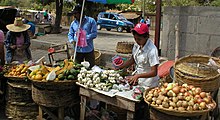
Nationwide supermarket chains include Palí (the cheapest and most crowded), La Union, and La Colonia (the most upscale one, with slightly higher prices and the widest selection of imported goods). A few Walmarts exist as well (mostly in Managua); in fact, Palí (and maybe some other chains too!) are owned by Walmart. Smaller towns, such as Ometepe's Moyogalpa and Altagracia, may only have smaller independent supermarkets.
Nicaragua being a small country, it appears that for most products most stores carry the same small set of brands. For example, in the dairy aisle you'll usually find Eskimo (a Nicaraguan national brand), and may also see some products by Parmalat (an international brand) and Dos Pinos (out of Costa Rica).
Local grocery stores (pulperias) are typically tiny; in smaller communities, they are no more than kiosks, or simply someone selling a few products from his living room. Often, no refrigerator or freezer is available in small stores; so milk is sold in UHT boxes, and cheese is very salty (to slow spoiling). Panaderias and pastelerias, where available, sell fresh bread and pastries.
Most cities have large markets, where all kind of produce, bread, cheese, and sweets can be found.
When buying packaged dairy products in supermarkets, pay attention to labels: some of them (sour cream, milk in plastic bags, sometimes ice cream) may be adulterated with vegetable fats.
Drink [ edit ]
Rum is the liquor of choice, though you will find some whiskey and vodka as well. The local brand of Rum is Flor de Caña and is available in several varieties: Light, Extra Dry, Black Label, Gran Reserva (aged 7 years), Centenario (aged 12 years) and a new top-of-the line 18 year old aged rum. There is also a cheaper rum called Ron Plata.
Local beers include Victoria , Toña , Premium , and Brahva . Victoria is the best quality of these, similar in flavor to mainstream European lagers, while the others have much lighter bodies with substantially less flavour, and are more like the palid mainstream US lagers. A new beer is "Victoria Frost" which is similarly light.
In the non-alcoholic arena you will find the usual soft drinks such as Coca-Cola and Pepsi Cola. Local drinks include pinolillo and cacao ,which are delicious drinks from cocoa beans, corn and milk and usually some cinnamon, a thick cacao based drink; Milca, the first red soda in Nicaragua ; and Rojita , a red soda that tastes similar to Inca Cola or "Red Pop" (if you're from Texas or the southern United States).
Nicaraguans drink a huge variety of natural fruit juices and beverages ( jugos naturales which are usually pure juices, and (re)frescos naturales which are fresh fruit juices mixed with water and sugar). Popular are tamarind, cantaloupe, watermelon, hibiscus flower ( flor de Jamaica ), limeade, orange, grapefruit, dragon fruit, star fruit (usually mixed with orange), mango, papaya, pineapple, and countless others. "Liquados" or shakes of fruit and milk or water are also popular, most common are banana, mango or papaya with milk. Also common and very traditional are corn and grain based drinks like tiste, chicha (both corn), cebada (barley) and linaza (flaxseed). Most fresh drinks are around C$10–20. As in other parts of Central America, avoid juices made with water if you are not conditioned to untreated water, unless at a restaurant that uses purified water (in Spanish: agua purificada ).
If you don't like ice ( hielo ) in your drink just say so otherwise you will be getting huge chunks of ice that may or may not be made from purified water and thus defeat the purpose of avoiding tap water by ordering coke.
A word on bottle deposits: while almost all plastic bottles and cans don't have a deposit, glass bottles do. In some small pulperias (family-owned mini-stores for everything) you may not be allowed to take a glass bottle with you unless you bring them an empty bottle in exchange. So either you will have to drink your coke there or they give you a small plastic bag with a straw to take the drink (but not the bottle) with you. Street vendors of home-made soft drinks ( (re)frescos ) would often have them in plastic bags as well; spiced vinegars are sold in markets in such bags too.
Sleep [ edit ]

Accommodation can generally be had quite cheaply throughout Nicaragua. Options range from simple hammocks (US$2–3), to dorm rooms in hostels (US$5–9), to private double-bed ("matrimonial") rooms (US$10–35, depending on presence of TV, air-con and private shower room and WC). You will likely only find real luxury in major cities like Managua, León or Granada and in a very few resorts such as Montelimar (Somoza's old holiday residence) and even then prices almost never reach four figures.
High and low season are not as pronounced as in e.g. Costa Rica, but there is a pronounced spike in rates during semana santa (Easter week) which is the time of year most Nicaraguans take their vacation. Doubling and tripling of prices is not unheard of in e.g. San Juan del Sur during that time. There is another minor spike around Christmas / New Year's , but it isn't as pronounced. You can sometimes negotiate better rates during the rainy season, but don't count on it.
While Barrio Martha Quezada has typically been a budget destination for visitors to Managua due to its many inexpensive hotel options, it has become increasingly dangerous, especially for tourists, with robberies occurring in broad daylight. Unless you need to be in this area to catch an early morning bus from a nearby terminal, it is advisable to avoid Martha Quezada, particularly since it is far from what is termed the "new" centre of Managua. The area near the Tica Bus station has a reputation for being dangerous as well, and tourists may be well advised to take a cab directly to and from the station, even if the walk is short. Backpackers Inn near MetroCentro (5min by taxi from the UCA microbuses), Hotel San Luis in Colonia Centroamerica (5 min by taxi from Mercado Huembes bus terminal) are good budget options in safe neighbourhoods, as are numerous hotels of various prices in neighbourhoods around the new centre near Metrocentro and Caraterra Masaya (i.e. Altamira, Los Robles, Reparto San Juan).
Look for pensiones or huespedes or hospedajes as these are the cheapest sleeps costing under USD5. They are usually family owned and you'll be hanging out with mostly locals. Make sure you know when they lock their doors if you are going out at night. Hotels have more amenities but are more expensive. There are some backpacker hostels in Granada, San Juan del Sur, Isla Ometepe , Masaya, Managua, and Leon; otherwise, it's pensiones all the way.
Learn [ edit ]
Spanish schools and courses are available in most cities, especially Granada . Look for specific listings in local guides, or just inquire when you're there.
Schools offer homestay as an option. Living with a Spanish family helps to use your Spanish and you learn the culture as a bonus. The courses are usually 20 hours per week.
Work [ edit ]
Employment opportunities for foreigners are limited. Since the country has a strongly agricultural and tourist economy, it can be difficult finding employment prospects. Other than that, doctors and engineers are always in short supply, though wages are no where near even the standards of some other countries in the region.
One job of particular interest to foreigners is teaching. If you are a native English speaker and have a bachelor's degree, you can teach at any major Nicaraguan university. The same also applies for other fields. Be aware, however, that courses and majors at Nicaraguan colleges and universities are limited. However, a degree can help you secure a good job and enough spending money during your stay. Instructors earn about US$500 a month and have plenty of free time to roam around. Opportunities have also become available for other languages, particularly romance languages. However, if you desire to teach a course other than English, it is best to consult with the university of your choice and see if they are willing and able to have you teach your course. If this is something you wish to do, you are advised to create a syllabus in advance. It can help you, the applicant, obtain the position faster and easier compared to not having any material at hand available.
Foreigners also enjoy volunteering. In Nicaragua, there are various opportunities for community service. Most of the organizations in Nicaragua can be used in obtaining community service hours for any organization or any college/university requirement. Look into organizations like the Fabretto Foundation . Abundance Farm , a small family-run farm in Carazo, accepts volunteers but screens them through email prior to arrival. It is a taste of the real Nicaragua and not for the faint at heart.
Nicaragua has an impressively dense network of hospitals, centros de salud and puestos de salud covering even remote areas. If you have appropriate medical knowledge, your help in one of those is certainly welcome, but you should be aware that supplies and anything that costs money are often severely lacking. Depending on your country of origin, you may also do (part of) your mandated practical studies in Nicaragua, but talk to your university before heading to Nicaragua.
Respect [ edit ]

- Nicaraguan Spanish has a distinction between "formal" and "informal" you. The formal form ("usted" for one person, "ustedes" for several people) is used with strangers, older people and higher-ranking people. The informal form ("tu" or "vos" with one person; "vosotros" for several people is hardly ever used outside of the bible, but still correct (mainland) Spanish, Nicaraguans would talk to a group using "ustedes") is used among peers and friends and after you have been explicitly offered to address someone informally.
- Don (for men) and Doña (for women) are a common term to politely address people with their given name. e.g. Don Ramon or Doña Maria. It can be loosely translated as Mr./Mrs.
- Nicaraguans are very conscious about their appearance and don't understand why "rich" tourists would go around in shabby clothes or unkempt. It's true a smile goes a long way, but in Nicaragua a shower with your smile goes an even longer way.
- While Nicaragua has a sizable irreligious minority and a growing (US-style) evangelical community, most people like their faith (usually Catholic) the way it is, thank you, and don't take too well to it being ridiculed or overt attempts at proselytizing.
- Men in shorts are not a common sight among Nicaraguans, and considering mosquito-risk, you should consider wearing pants or jeans
- Some Nicaraguan women bath with a t-shirt on top of their bathing-suit. While you don't have to do that, females going topless at the beach is certainly a no-no.
- It is common to be given nicknames by strangers based on your appearance. If you are visibly white, people will probably call you "chele" (from leche , milk). Nicknames such as "gorda" (fat lady), "flaco" (skinny man), or "negro" (black), are common and are not considered offensive.
- In a similar vein as the above, people might comment on your weight or, if they see you again after some time, on gains or losses in it. As weight is plain to see, they don't consider it an offensive topic to talk about. In fact it is sometimes even treated as a topic fit for small talk!
Stay safe [ edit ]
Nicaragua has made considerable strides in terms of providing police presence and order throughout the country. Crime is relatively low. However, starting in 2008, reports of low-level gang violence began coming in from Honduras and El Salvador. The National Nicaraguan Police have been successful in apprehending gang members and reducing organized crime.
Do not travel alone at night. Pay for a taxi to avoid being assaulted in dimly-lit areas. Tourists are advised to remain alert at all times in Managua. Although gang activity is not a major problem in Managua nor Nicaragua, caution should be exercised. Tourists are advised to travel in groups or with someone trusted who understands Spanish. There are local organizations that offer translator or guide services. One of them is Viva Spanish School Managua.
It is also advised that tourists refrain from using foreign currency in local transactions. It is best to have the local currency instead of having to convert with individuals on streets or non-tourist areas. Banks in Nicaragua require identification for any currency conversion transactions. Use ATMs that dispense the local currency. When using ATMs, follow precautions and be aware of your surroundings.
Buses can be extremely crowded and tight in terms of space. An overhead rack tends to be provided for the storage of bags and other items, but tourists are recommended to keep their bags at hand, in their sight, at all times and maybe to put a lock on your bag. A good idea is having a smaller bag for items you positively cannot afford to have stolen and never leave it out of sight.
Collective taxis are also risky as organized crime has flourished in this transportation sector because of fixed passengers. In other words, drivers already know who they pick up and thus can mug the one extra passenger. This crime, however, is not common. When riding taxis, tourists are strongly recommended to close their windows, as theft through an open window does occur in (frequent) Managua traffic jams and at red lights.
Although extensive demining operations have been conducted to clear rural areas of northern Nicaragua of landmines left from the civil war in the 1980s, visitors venturing off the main roads in these areas are cautioned that there is still the possibility of encountering landmines.
You will need a little bit of money to go over international borders. Nicaragua charges a border toll of US$10-13 (depending on the "administrative tax"). This is on top of a CA-4 visa that's good for crossing the borders between Nicaragua, Honduras, El Salvador, and Guatemala. Under the treaty establishing that visa, the border guards are not supposed to check people with such a visa, but they do so anyhow and charge tolls, which they claim are border crossing visa fees.
Widespread protests against Ortega's government's attempt to reform social security laws broke out in April 2018 in every major city and department of the country - with violent clashes between protesters and police in the streets which resulted in more than 60 deaths, more than 400 injuries, and more than 200 arrests. Rioting, looting of stores, vandalism of property, and burning down of buildings occurred (especially at Managua and Leon), so tourists should avoid these protest areas and steer clear of large gatherings in urban centers. It is against Nicaraguan immigration law for foreigners to involve themselves in local politics
Stay healthy [ edit ]

According to the U.S. State Department's Consular Sheet for Nicaragua, the tap water in Managua is safe to drink, but bottled water with chlorine is always the best choice. The water in Esteli is especially good as it comes from deep wells. Bottled water is readily available, with a gallon at a supermarket around an American dollar.
Given its tropical latitude, there are plenty of bugs flying about. Be sure to wear bug repellent containing DEET particularly if you head to more remote areas ( Isla Ometepe , the Rio San Juan Region , or Caribbean Nicaragua ).
Dengue fever is present in some areas and comes from a type of mosquito that flies mostly between dusk and dawn. Malaria is not of serious concern unless you are heading to the Caribbean coast or along the Rio San Juan east of San Carlos. You may be advised by a doctor to get Hepatitis A and typhoid vaccinations before heading to Nicaragua. These will substantially lower your odds of getting seriously ill from contaminated food or water, but they don't offer full protection, so you still need to be careful. Also, the Zika virus is known to be present in Nicaragua.
Even though there is a public health system and many public hospitals, these are terrible options for tourists apart from the gravest emergency and even then only until a private hospital can send an ambulance. However they can usually deal with minor problems just as well as any non-hospital doctor could and charge you nothing. There are several private hospitals, in order of quality from best to worst are Hospital Metropolitano Vivian Pellas at Carretera Masaya Km 10, Hospital Bautista, Hospital Militar near Plaza Inter and a few others.
Despite promoting medical tourism, these hospitals rarely have English speakers on staff for dealing with tourists. If you insist or someone with you does, you may get an English-speaking employee. It is still best to have some Spanish or attend with someone bilingual.
If you have a problem and Cruz Roja are called (the Nicaraguan Red Cross ambulance service) and you have money or insurance have them take you to one of the private hospitals in the order mentioned. They will probably ask you anyway, but specify the private hospital or call the hospital for their ambulance.
Private hospitals are much less expensive than in the United States : a private room with private nurse in 2009 at Metropolitano was US$119 per day. An MRI of the knee in 2010 was $300. Emergency surgery in 2008 in Bautista including surgeon, anesthesia, operating and recovery rooms and supplies was US$1,200 with the private room under US$100 after that.
Connect [ edit ]
Cope [ edit ], embassies [ edit ].
See the article Managua for foreign embassies in the country.
Newspapers [ edit ]
While most of the TV channels are owned by Ortega, his family or the government, the newspaper scene is much more diverse and it is here that you are most likely to see criticism of the government. Most newspapers also have an online edition and they can keep you up to date with what's going on in Nicaragua and the rest of Central America. While both La Prensa and El Nuevo Diario are focused on Managua to a ridiculous degree, they have semi-regular "tourism" sections that are well worth a read if you speak Spanish and they are rather cheap at C$7 a copy (C$10 in more remote areas like the Caribbean Coast or the Rio San Juan Region).
- La Prensa (in Spanish). Founded in 1926, La Prensa generally supports free market, neo-liberal economics and is largely pro-US. It is conservative on social issues. They loathe Ortega and everything he stands for and take (almost) any opportunity to say so.
- El Nuevo Diario [dead link] (In Spanish). Its offices are in Managua. El Nuevo Diario was founded in 1980 by a breakaway group of employees of La Prensa . Its politics are to the left of .La Prensa .
- Hoy [dead link] is a Managua-based Spanish language tabloid style newspaper with less tradition than the two mentioned above and even more of a focus on traffic accidents, crime and the price of tomatoes at various markets in Managua. However given their target demographic, it might be easier to read if you aren't that sure of your Spanish. Hoy also has articles on places of tourist interest which can also be read on their website.
- El 19 Digital (in Spanish). This is the official outlet of the ruling Sandinistas and quite blatant in its political outlook. The place to go for speeches by Ortega and his Vice President/wife and if you want to know how they want to be seen by the world at large. They do however also have straight news, even though they are short on anything that could make Nicaragua or the Sandinistas look bad.
- Has custom banner
- Has map markers
- Articles with dead external links
- Central America
- All destination articles
- Usable countries
- Usable articles
- Country articles
- Has Geo parameter
- Pages with maps
Navigation menu

What to Do in Nicaragua on Your Next Vacation
Whether you’re a nature lover, a history buff or a culture vulture, the largest country in Central America is a land of superlatives with plenty to offer. Here is our list of things to do in Nicaragua
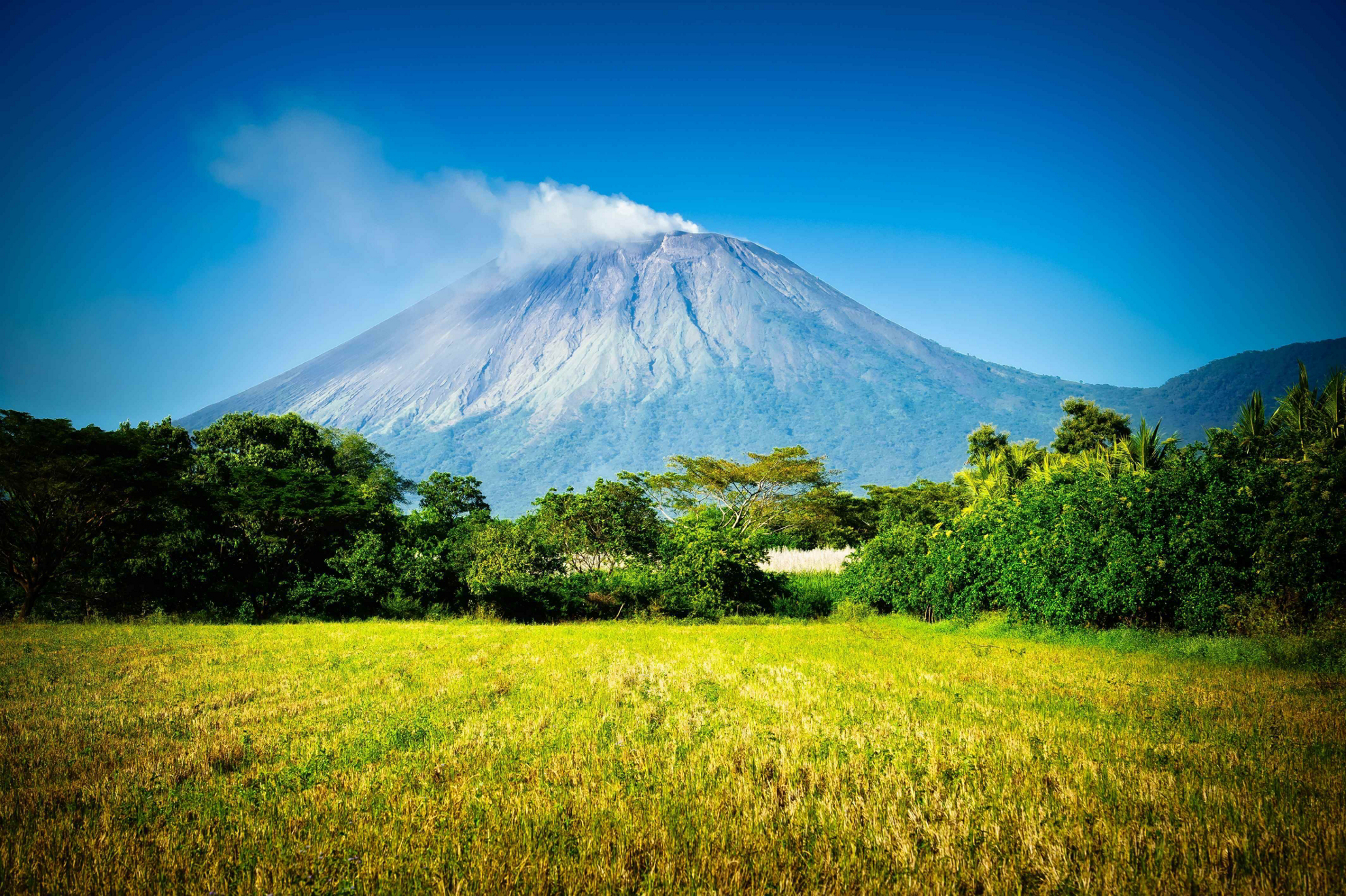
This little-known gem dotted with lakes and volcanoes is the only country in Latin America that was colonized by both the Kingdom of Spain, which reigned over the western Pacific region, and Great Britain, which controlled the Mosquito Coast along the Caribbean. But Nicaragua’s attractions go beyond its singular history . The country also stands out for its hospitality, its tranquil, laid-back vibes, and its stunning colonial cities . Not to mention its vibrant cultural and culinary traditions and its wealth of natural treasures including biosphere reserves, lakes, lagoons, waterfalls, beaches, mountains, rainforests, and volcanoes. And for travelers looking to safely explore off the beaten track, Nicaragua is also an ideal destination for ecotourism in Latin America .
Wondering What to Do in Nicaragua?: Start with a Visit to Managua
The capital city, Managua, is home to about a sixth of the nation’s six million inhabitants, so this is one city you must see in Nicaragua, among other reasons, because it’s the country’s main transport hub . Visit both its cathedrals: the eerie shell of the neo-Classical Catedral Vieja, damaged by an earthquake in 1972, and the eclectic uber-modern Nueva Catedral built by Mexican architect Ricardo Legorreta in the early nineteen nineties . The city offers easy access to many of Nicaragua’s top attractions and is also a hop skip and a jump away from the Pacific shore, where you’ll find the only all-inclusive hotel in Nicaragua .
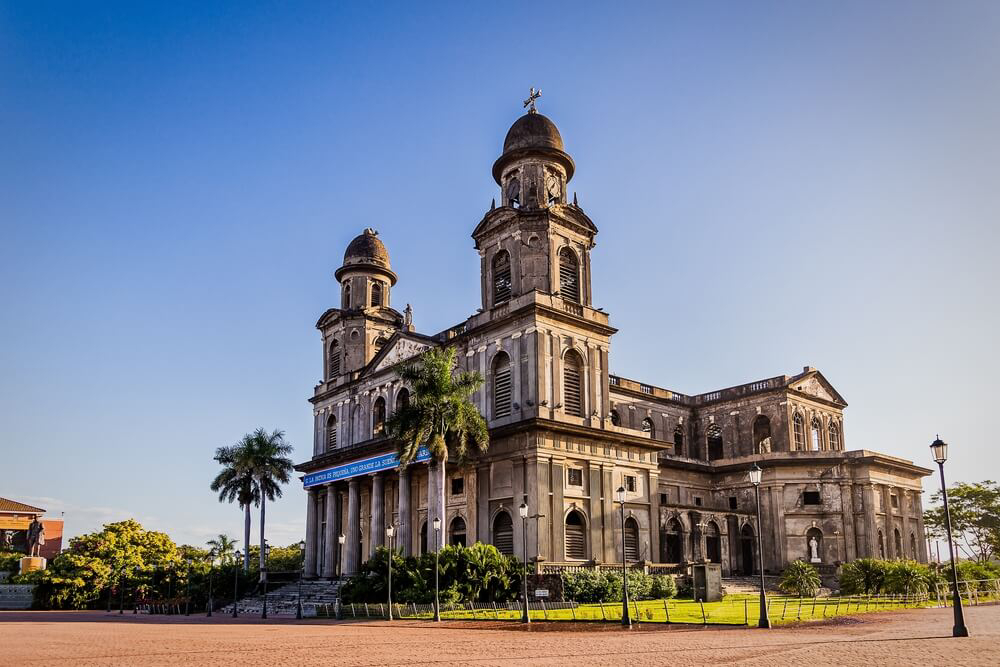
Managua is Nicaragua’s capital and largest city
Marvel at the Immensity of Lake Nicaragua when You Visit Nicaragua
Also known as Lake Cocibolca, the 3,191 square mile “sweet sea”—as the “Nicas” like to call it—is the largest lake in Central America and the 19 th largest in the world. The lake drains out into the Caribbean Sea through the San Juan river and once served as a port. It is no doubt one of the most famous landmarks in Nicaragua. In fact, the Spanish conquistadors initially mistook it for another sea , hence the nickname.
Lake Nicaragua is the only freshwater lake in the world that contains oceanic marine life
Lake Nicaragua is the only freshwater lake in the world that contains oceanic marine life. Scientists speculate these bull sharks must have traveled up the San Juan river, swimming upstream like salmon, and ultimately adapted to living in fresh water. Lake Nicaragua is also great for birdwatching , making it one of the best places to visit in Nicaragua.
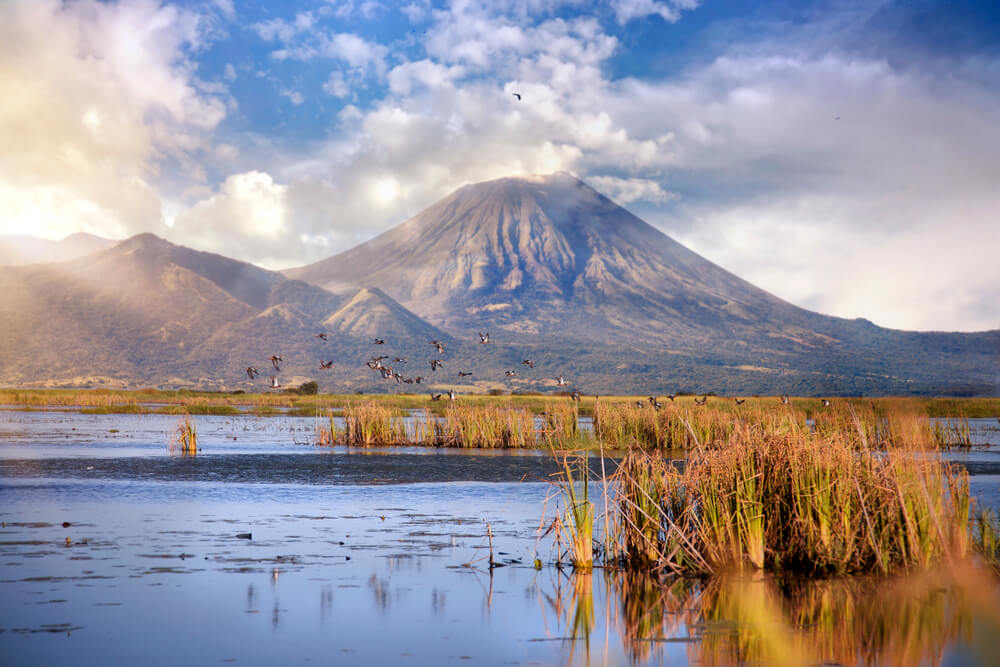
Lake Nicaragua is among the famous landmarks in Nicaragua
León’s Cultural Heritage Is Another of Nicaragua’s Points of Interest
Another of the cities to visit in Nicaragua is the country’s cultural capital and second-largest city. The city is officially called Santiago de los Caballeros de León (León for short). This vibrant university town and a bustling industrial and commercial center lies just off the Pacific coast , some 55 miles northeast of Managua, and is one a key stop on the Pan-American Highway .
The city boasts two UNESCO World Heritage Sites : the ruins of Old León —the original Spanish settlement founded in 1524 and destroyed by a volcanic eruption in 1610—and the cathedral . León’s cathedral is one of the most famous places to visit in Nicaragua, and the largest cathedral in Central America.
León’s cathedral is one of the most famous places to visit in Nicaragua, and the largest cathedral in Central America
Nicaragua’s most renowned poet, Rubén Darío , is buried inside the eclectic, white-washed building alongside other national heroes. Climb up on the roof for unforgettable panoramic views of city with the Los Maribios mountain range in the background.
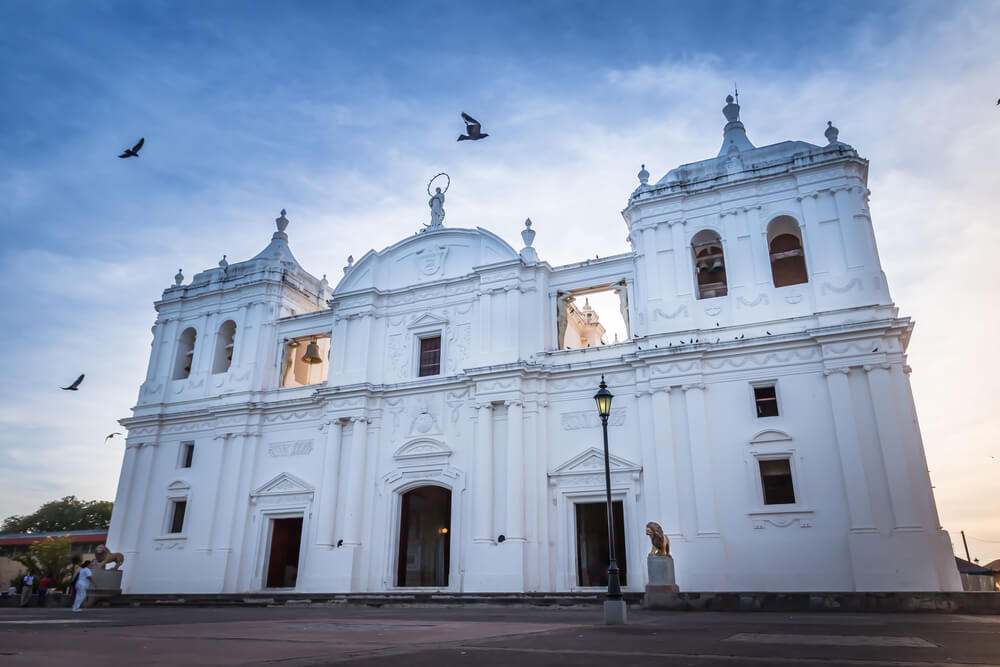
Visiting León’s cathedral, a UNESCO World Heritage Site deserves a place on your list of what to do in Nicaragua
Ometepe Island Is One of the Must-See Places in Nicaragua
Ometepe—or “two mountains” in Nahuatl—is the largest freshwater island in the world . This Biosphere Reserve covers an area of approximately 107 square miles and is made up of two volcanoes that gave it its name: the 5,249-foot-high Concepción and the slightly more modest 4,573-foot Maderas. One of the cool things to do in Nicaragua is to hire a guide (it’s mandatory) to take an 8-hour hike up one of the volcanoes and hang out at the top watching the sunset . You may well spot howler monkeys along the way.
And if you’re more inclined to relaxation, take a dip in the Ojo de Agua— a natural pool whose waters flow directly from the Concepción volcano and are said to have medicinal properties —or cool off under the spray of the 148-foot San Ramón waterfall at the foot of Maderas. And this is just a tiny selection of some of the best things to do in Ometepe.
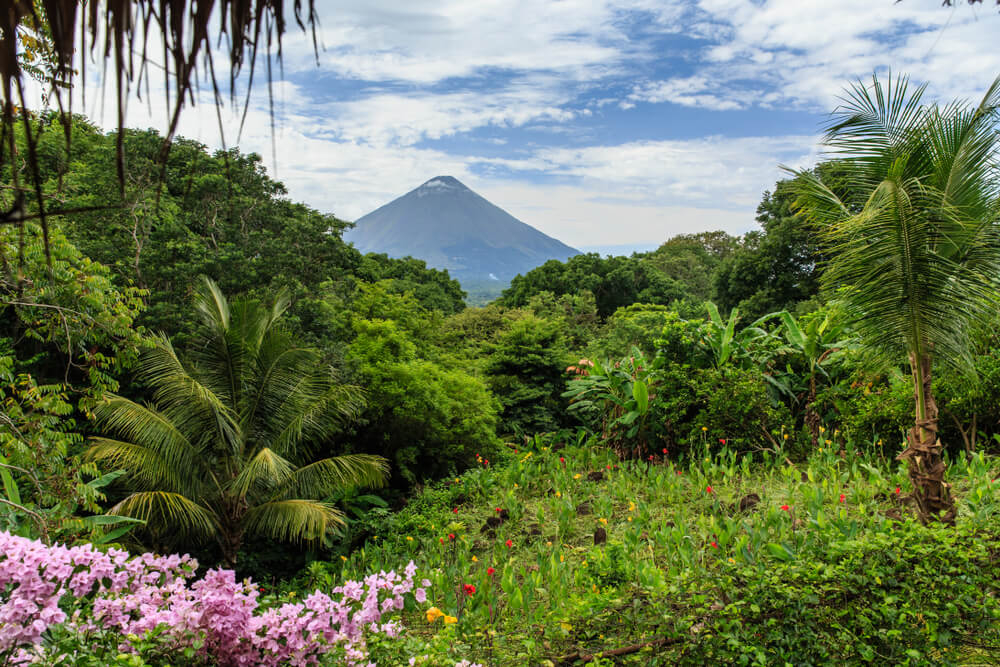
Admiring its natural beauty is just one of the many things to do on Ometepe Island, a must-see in Nicaragua!
Riding a Chicken Bus Is a Must-Do in Nicaragua
To get a sense of what day-to-day life is like for locals, make sure to put riding a “chicken bus” on your Nicaragua bucket list. Chicken buses are decommissioned American school buses that were repurposed in the 1970s for use as a means of public transport for the general public throughout Central America. Keep in mind these buses were designed for school children. They’re often packed, and legroom is limited even if you do find a seat, but riding in one is a great way to meet locals and one of the most unique things to do in Nicaragua.
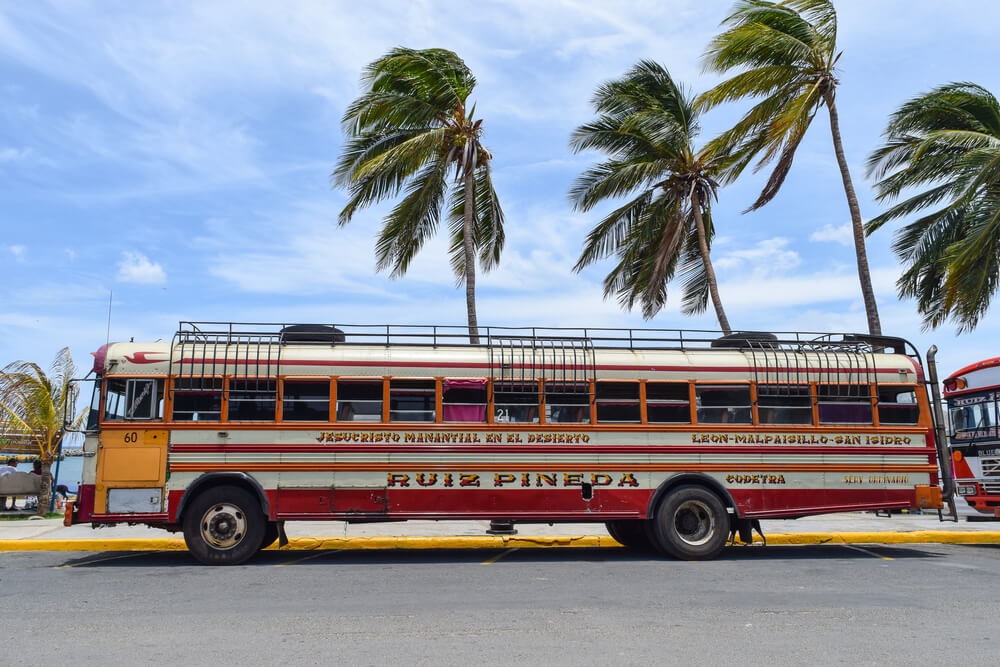
When in Nicaragua, do as the Nicaraguan’s must do and ride a chicken bus with the locals!
Volcanoes Are Among Nicaragua’s Top Attractions
With some 50 volcanic formations in all, including at least eight active volcanoes , it’s no surprise the volcano tourism has become one of the main tourist attractions in Nicaragua. The country offers volcanoes to suit all tastes. San Cristobal —also known as Tepemesquián—is the highest peak in Nicaragua, and one of its most active volcanoes. Cerro Negro , on the other hand, is the country’s youngest and smallest volcano and offers visitors the chance to go volcano surfing . Lake Apoyo, in the crater of a dormant volcano, is deep enough to enjoy swimming, kayaking, fishing, and sailing.
Gazing at the incandescent lava lake at night is another unforgettable experience to include in your Nicaragua bucket list
Another must-see is the Masaya Volcano National Park in Nicaragua, the country’s first and largest national park, where you’ll find the Masaya Volcanic Complex, one of the most interesting places in Nicaragua. Gazing at the incandescent lava lake at night is another unforgettable experience to include in your Nicaragua bucket list.
Keep in mind that visits are limited to 10 minutes because the bubbling lava in the volcano’s crater emits carbon dioxide, which can be toxic.
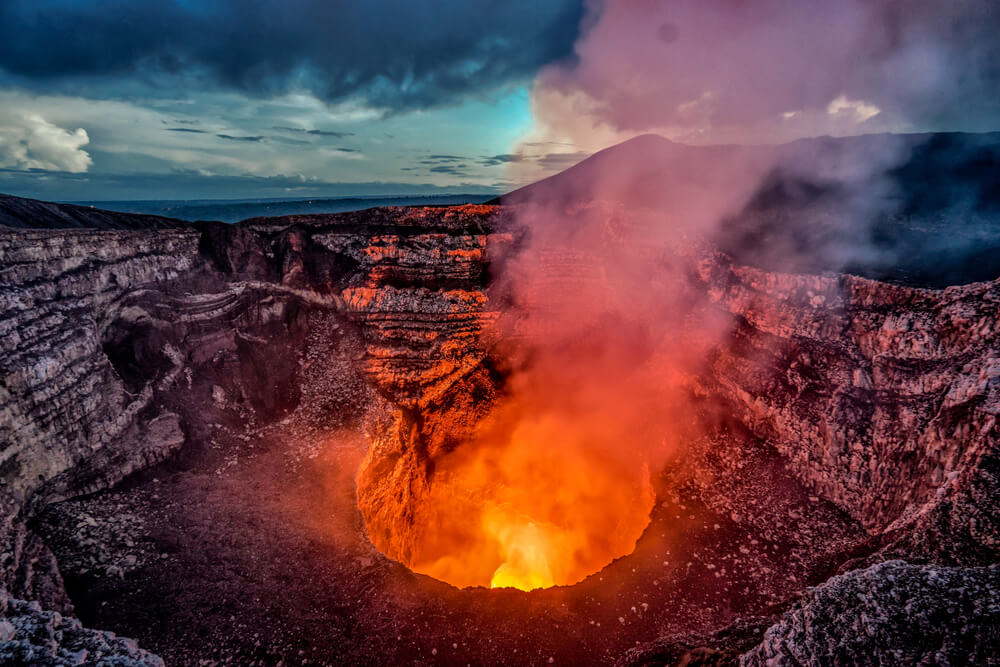
The Masaya Volcano National Park is the country’s largest national park and one of the top tourist attractions in Nicaragua
Stocking Up on Local Crafts Is Among the Fun Things to Do in Nicaragua
When you hop on the chicken bus, chances are many of your fellow passengers will be headed for one of the many traditional markets you’ll find all over Nicaragua. Perhaps the most famous of these is the Mercado Nacional de Artesanías . Visiting this market is of the most popular things to do in Masaya.
Every Thursday night, during the Verbena, the market comes alive with local food and music and traditional Nicaraguan dances
Every Thursday night, during the Verbena, the market comes alive with local food and music and traditional Nicaraguan dances. And you’ll find a wide selection of rum, coffee, hammocks, ceramics, and other handicrafts that will make perfect souvenirs. Truly one of the most unforgettable places to visit in Nicaragua!
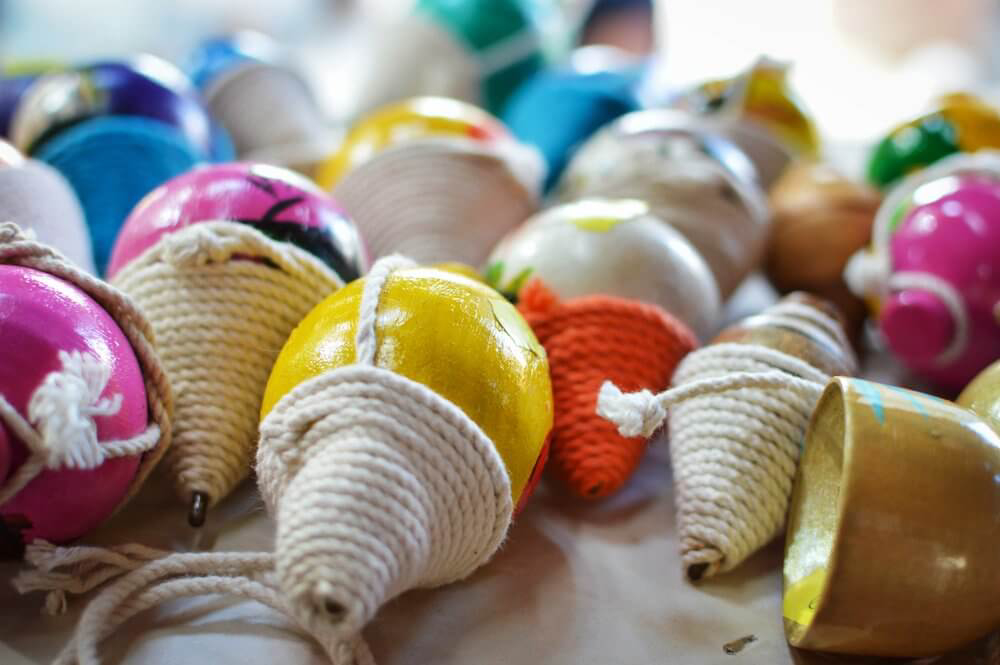
One of the many must do things in Nicaragua is checking out the local crafts markets
Discover the Colonial City of Granada, One of Nicaragua’s Top Attractions
On the northern shore of Lake Nicaragua, Granada—officially, Santiado de Granada, founded in 1524—is the country’s oldest city and one of the prettiest places to visit in Nicaragua. The city is often referred to as the Paris of Central America and is one of the must-see places in Nicaragua. Stroll its cobblestoned streets and enjoy its colorful colonial buildings. Visit the San Francisco convent museum to learn about the regions pre-Columbian civilization and you’ll find the city’s history is as colorful as its architecture. Spend a day on the lake kayaking around the Granada Islets—there are 365 in all, so you can visit one each day of the year!
Spend a day on the lake kayaking around the Granada Islets—there are 365 in all, so you can visit one each day of the year!
Or visit the archeological site on Isla Zapatera to check out the petroglyphs . And while you’re in town, make sure you sample the famous vigorón —a typical local dish made of cassava, fried pork rinds and cabbage salad. Because sampling local fare is no doubt one of the best things to do, in Nicaragua or anywhere else for that matter!
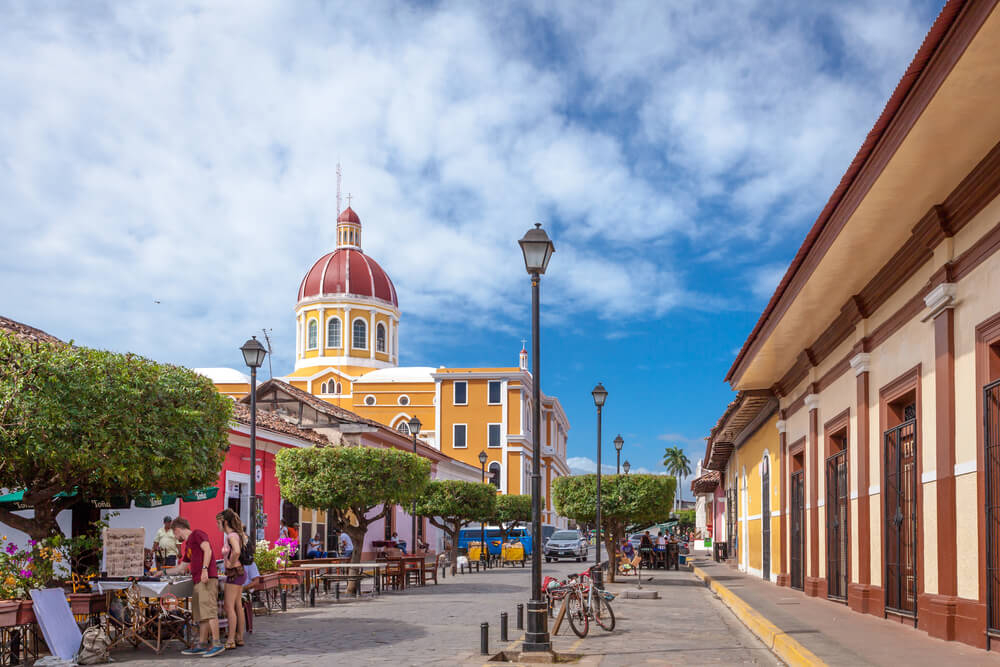
The country’s oldest colonial settlement, Granada, is one of the prettiest cities to visit in Nicaragua
Touring a Coffee Plantation Is One of the Unique Things to Do in Nicaragua
Coffee is one of Nicaragua’s main exports and has played a key role in its history and economy for the past 200 years. Major production hubs include the volcanic region around Jinotega , the mountains of Matagalpa , and the area near Estelí , in the northern part of the central highlands. One of the great things to do in Nicaragua is to learn all about how this staple product is grown and processed. And since over 90% of coffee plantations in Nicaragua are owned by small farmers , visiting a coffee plantation is a great way to make a positive impact on the local economy .
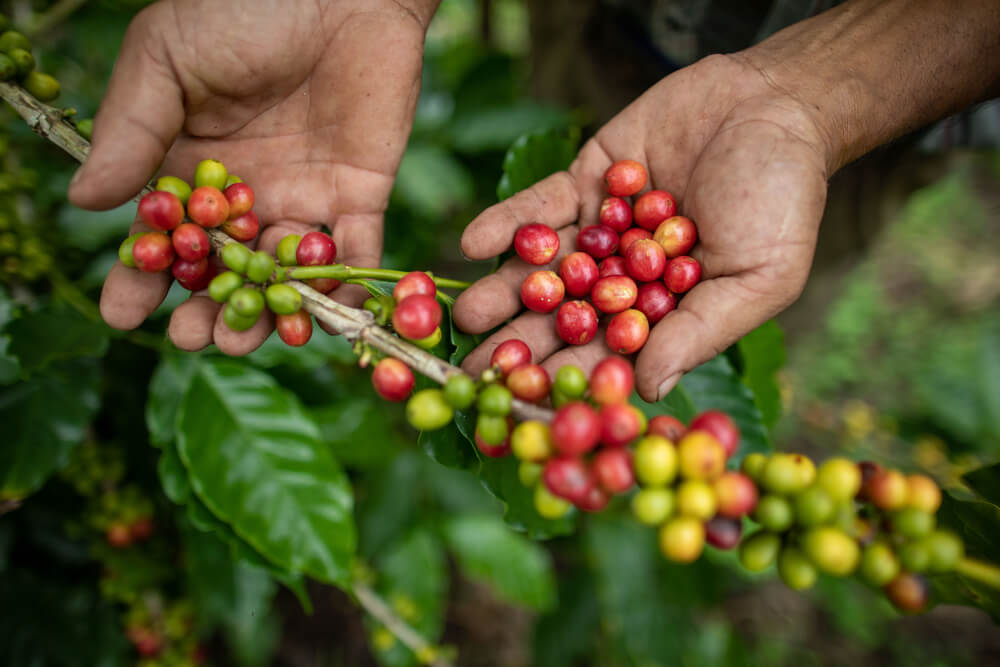
Learning all about how the country’s main export (coffee) is produced is a must when you visit Nicaragua
The Surfer Scene at San Juan del Sur Is One of the Best Things About Nicaragua
San Juan del Sur is a surfer’s paradise . Notable activities include lounging on the beach, gazing at the sunset over the Pacific, strolling along the bay, sipping cocktails... you get the drift. Not surprisingly, the town has become a popular place to hold yoga retreats and is one of the top places to visit in Nicaragua to chill out. Contemplate the impressive Christ of Mercy, one of the 10 tallest statues of Jesus in the world while you’re there. Oh, and… you can also go surfing!
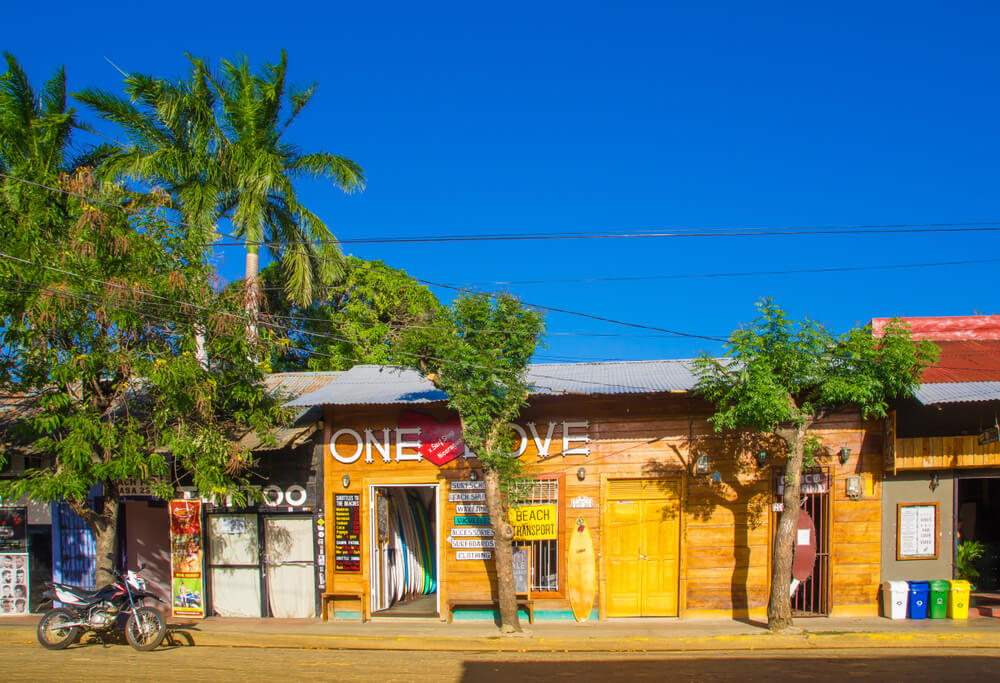
San Juan del Sur is one of the must-see places in Nicaragua for surfers
Put Island Hopping in the Caribbean on Your Nicaragua Bucket List
Aside from Ometepe and all the other islets on Lake Nicaragua, “The Land of Lakes and Volcanoes” also boasts some of the best beaches in the Caribbean . Head for one of the string of 18 remote Pearl Cays or visit the Corn Islands , once a base for British buccaneers. Exploring underwater caves, snorkeling or scuba diving with hammerhead sharks are just some of the Corn Island activities to look forward to. Or, you can simply laze about on a traditional Nicaraguan hammock on a deserted beach as you contemplate the azure waters of the Caribbean while enjoying the freshest seafood imaginable. Because doing nothing is another of the great things to do in Nicaragua!
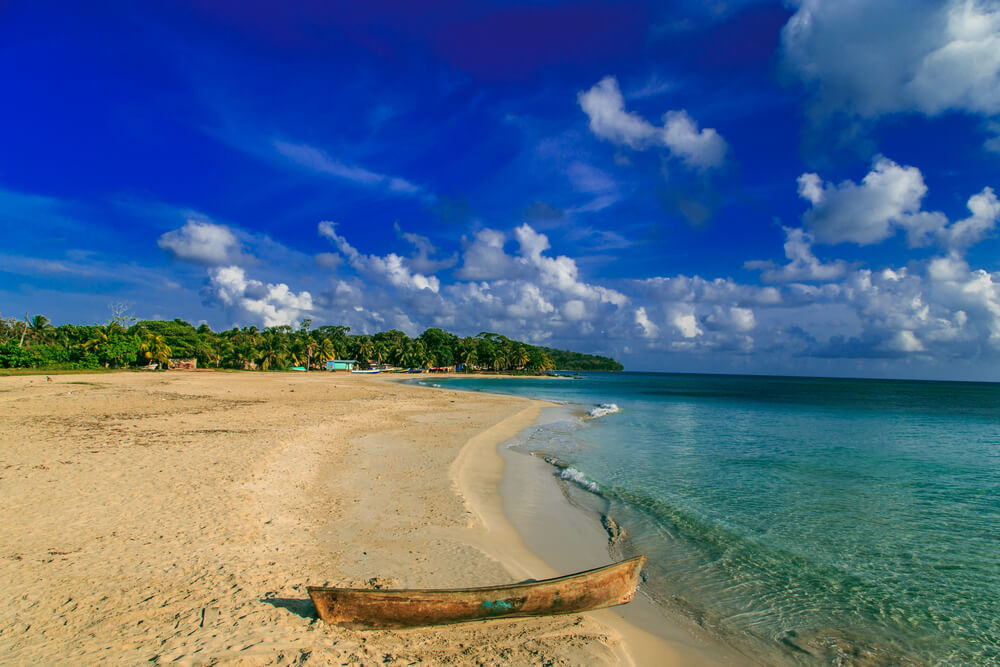
The Corn Islands off the country’s Caribbean coast are another of Nicaragua’s attractions
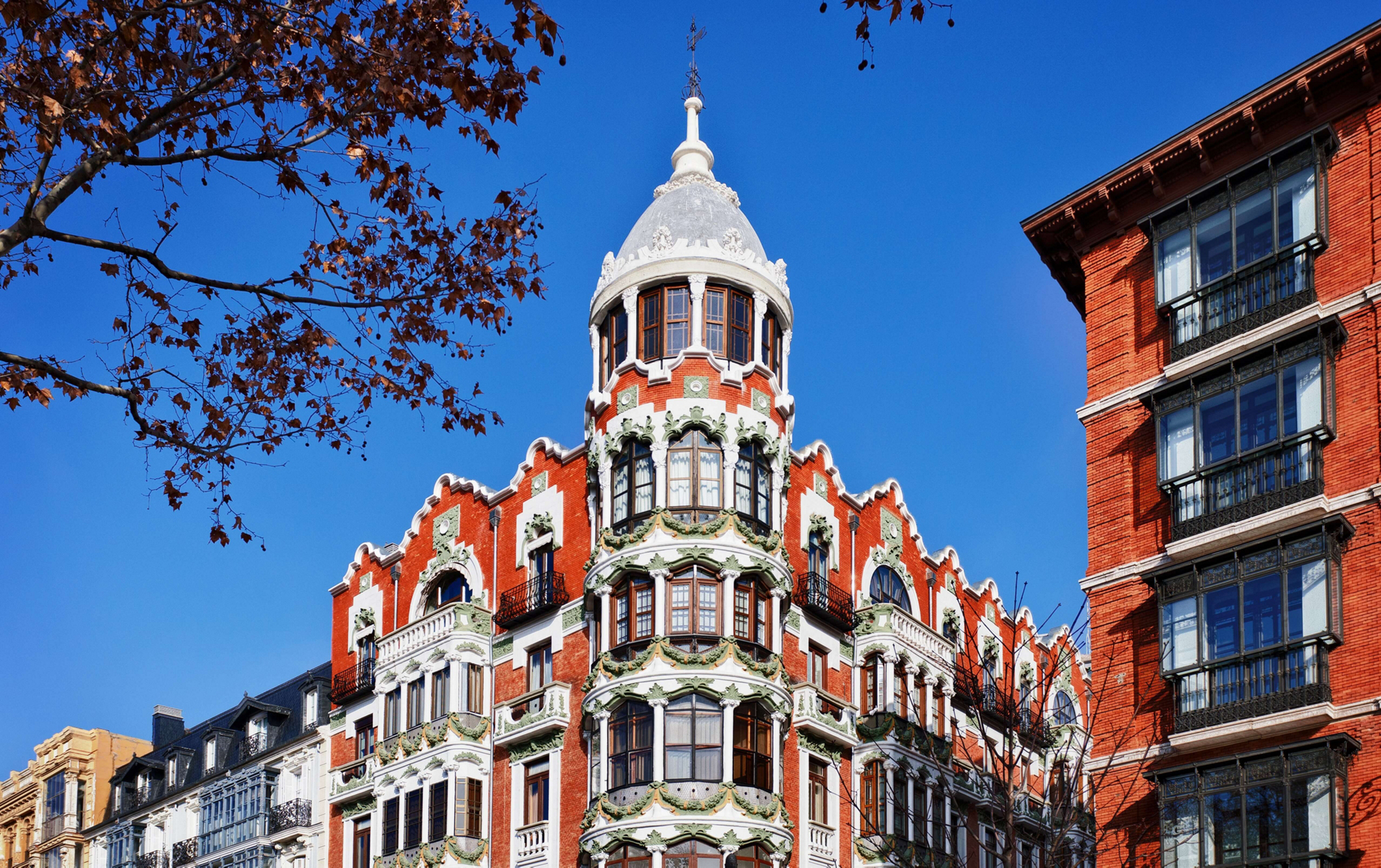
Please try modifying your search
- All hotels - 180 hotels
España (all) - 81
Select your dates (optional)
This hotel has a maximum occupancy per room of people
Unfortunately, we do not have availability for this distribution.
We suggest splitting guests into more rooms and updating your search.
Do you have a promotional code?
You get a discount

Suscríbete a la newsletter de Barceló Hotel Group para no perderte nada
Ofertas, promociones especiales, novedades…
Acepto y confirmo que he leído la Política de Privacidad *
Acepto que Barceló Hotel Group pueda enviarme comunicaciones comerciales por cualquier medio sobre productos o servicios de Barceló Hotel Group*
14 Must See Places to Visit While You Are in Nicaragua
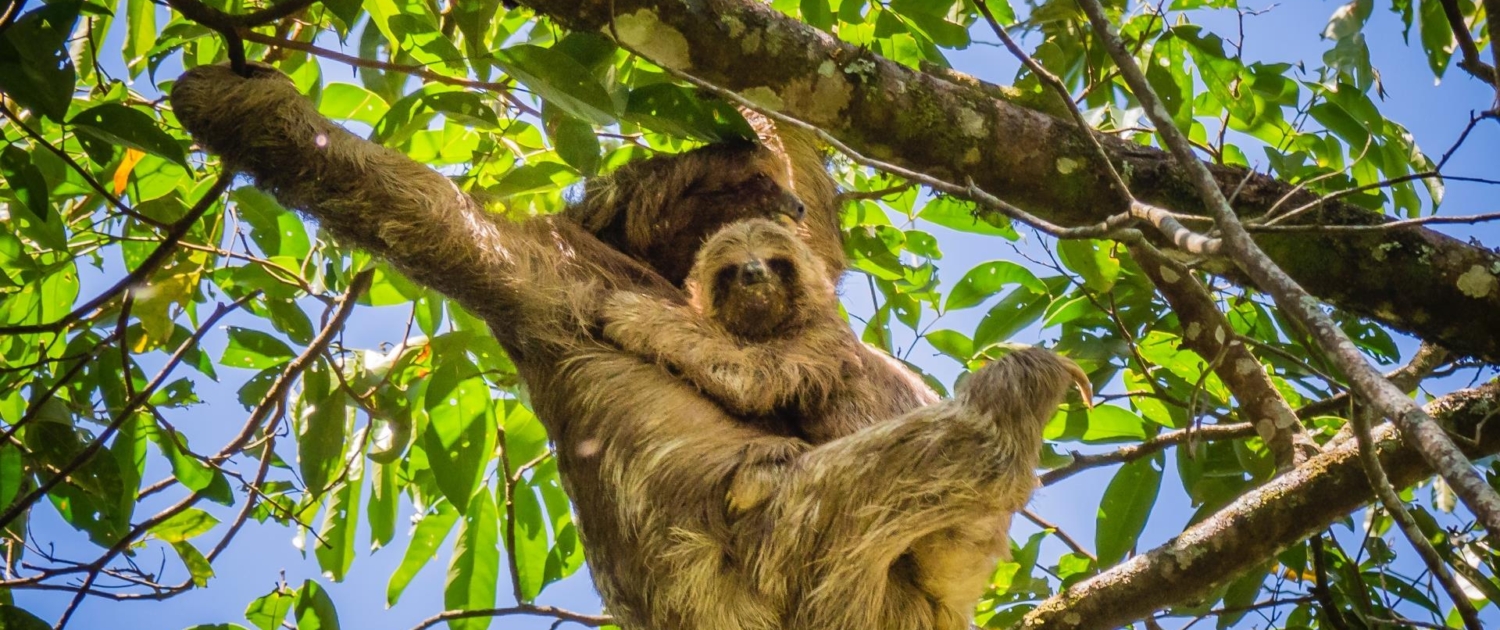
San Juan Del Sur
The quaint fishing village that grew into a fun beach town.
One of the most popular places to visit in Nicaragua is a small town called San Juan del Sur. This fun beach town is located on the sunny Pacific coast, only 20 minutes from the Costa Rica border crossing of Penas Blancas. It is a perfect place to add to your Nicaraguan travel itinerary if you are heading south to Costa Rica.
San Juan del Sur was originally a fishing village that grew into a fun town for backpackers, surfers, families, and entrepreneurs. You can still see fishermen on the street selling their fresh catch of the day. The town has recently exploded into a vibrant Latin American tourism destination that still retains its charm and uniqueness.
San Juan del Sur is a bustling beachside community that offers many delicious restaurants, fun bars, and beautiful hotels. It is a great place to meet other travelers and enjoy the nightlife and social events, such as Sunday Funday and the Farmer Market. You can also enjoy diverse activities such as surfing, fishing, sailboat tour, diving, snorkeling, horseback riding, and visiting a few of the many beaches surrounding town.
This Central American town also attracts many surfers. The conditions for surf lessons are good almost every single day of the year! The most famous surf beaches around San Juan del Sur are Playa Maderas, Playa Remanso, and Playa Yankee.
La Isla de Ometepe
The volcanic island on lake nicaragua.
Ometepe Island was formed by two volcanoes, Concepcion (1,610m/5,279ft) and Maderas (840m/2,756ft). To access Ometepe Island, you will need to take a ferry from San Jorge, only 25 minutes driving from San Juan del Sur.
The two volcano summits of Ometepe Island are currently inactive. The abundance of natural wonder to explore on this island makes it a perfect travel destination for nature lovers. The most common tours on Ometepe Island include hiking the volcanoes or the San Ramon waterfall with a local guide. Also, kayaking on the lake, wildlife spotting, and renting a bike to zip around La Isla de Ometepe. Make sure to check out Santa Cruz, Balgue, and Moyogalpa while visiting Ometepe Island.
Day trips with tour operators are available to visit Ometepe Island. Still, we recommend staying at least one night to fully experience this mystical island and the volcanic lake of Nicaragua.
The Beaches of Popoyo Area,
On the pacific coast.
If you are visiting Nicaragua, you cannot miss the beauty of the Pacific coastline, and the best way to do so is to enjoy the white sandy beaches of Popoyo. Popoyo is located two hours from Managua and about an hour and a half from San Juan del Sur. Like San Juan del Sur, Popoyo is world renown for its surf breaks and international surf contests.
The beach towns in this area, such as Guasacate and las Salinas, have been recently discovered by many travelers and ex-pats who enjoy the quietness and the stunning sunsets over the blue waters of the Pacific coast.
Popoyo is an excellent place for practicing different types of surf and Spanish classes at one of its many Spanish Schools in Nicaragua. Both beginner and advanced wave riders will find wave options depending on which beach you visit. The waves are best during the summer months.
Granada, Nicaragua
An old colonial city of central america.
Granada is one of the oldest colonial towns in Nicaragua and Central America. Granada is an hour and a half from San Juan del Sur and one hour from Managua, the capital city of Nicaragua.
As a colonial city, Granada features charming cobblestone streets, a leafy central plaza, and various colonial architecture and patios. This makes it one of the must-visit places to add to your Nicaragua travel itinerary. Granada has many restaurants, bars, and hotels, making this town a great place to meet other travelers and enjoy the culture of Central America. You can also visit a UNESCO Cathedral featuring stunning views of the city.
While staying in Granada, you can organize a day trip to one of the following attractions: Laguna de Apoyo, volcano Masaya, Ometepe Island, Mombacho Volcano, and more.
La Laguna de Apoyo
A beautiful central american volcano crater that turned into a lagoon.
The Laguna de Apoyo is a 6 km natural crater lake that was formed by the volcanic activities of the Apoyo Volcano. It is located about half an hour from Granada and one hour and a half from San Juan del Sur. You can easily book a day trip to La Laguna de Apoyo from Granada, San Jorge, or San Juan del Sur with a private transfer.
La Laguna de Apoyo is the perfect place for relaxing among the cloud forest vegetation, while only feet from its quiet waters. It’s a great place to swim, hike, and kayak as this natural wonder is surrounded by local wildlife, such as birds, howler monkeys, and iguanas.
A few bed and breakfasts and hotels offer shared and private rooms for you to stay and relax after your day exploring the Laguna de Apoyo. We like to include a stop to la Laguna de Apoyo before flying back from Managua’s capital city.
Masaya Volcano National
An active volcano in nicaragua.
The Masaya Volcano is an active volcano located about 30 minutes from Granada and a little more than two hours from San Juan del Sur. You can organize a day trip with private transport from San Juan del Sur and Granada, or take the chicken bus to the entrance of the Masaya National Park.
Although the volcano is active, don’t worry, it’s very safe. It would be a fantastic introduction to the volcanoes of Central America and a highlight of your trip to Nicaragua.
Los Pueblos Blancos
The villages of the artisans.
Los Pueblos Blancos in Nicaragua are a group of little towns that are often referred to as “the white villages.” The reason behind their name is that almost all of their churches and houses are painted white. The list of Los Pueblos Blancos in Nicaragua includes: San Juan de Oriente, San Marcos, Niquinohomo, Masatepe, Catarina, Diriá, and Diriomo.
Each of these towns is specialized in either artisan leatherwork, woodwork, bamboo work, or pottery. Catarina is the gardens of Nicaragua and where you can find an abundance of trees and plants for sale. Enjoy your time discovering their shops and workshops while getting to know the local culture.
There are not many touristic hotels around the Pueblos Blancos but you could still find a private hotel room in one of these little towns. You can also book a day trip from San Juan del Sur, visit these small towns, and buy arts and crafts directly from the artists.
Mombacho Volcano Nature Reserve
“the roof of nicaragua”.
The Mombacho Volcano summit is one of the highest points in Nicaragua. Its surrounding nature reserve offers fantastic views of Granada, Lake Nicaragua, and the Pacific coast. Mombacho Volcano can be visited as a day trip from both Granada and San Juan del Sur.
You can hike (2 hours) or take a shuttle to the summit of Mombacho Volcano. There are two craters where you can see sulfuric fumaroles gases. The view from the crater’s summit is spectacular! Once at the summit of Mombacho Volcano, you can enjoy many hiking trails among the cloud forest populating the Mombacho Volcano.
León Nicaragua
The city of culture and revolution.
León was founded in 1524 by Francisco Hernández de Córdoba. It became the first capital of Nicaragua until 1852 when Managua took over due to its growth and progress. Leon is less than two hours from Managua and about four hours from San Juan del Sur.
León is rich in culture, and you can visit the numerous cathedrals and monuments built during the colonial era. León is also an incredible city for food lovers as it has some of the best restaurants in Nicaragua.
You can take a day trip to Playa las Penitas, only 20 minutes from the city center of Leon, or book a volcano boarding day trip to Cerro Negro.
Chinandega and its Surroundings
The city at the foot of volcan san cristóbal.
Chinandega is located in the North of Nicaragua near the Pacific coast. The city is known for its many beaches, seafood restaurants, and fishing vessels as it features a close marina. A day trip to Chinandega and its surroundings would be a great way to discover the charm of northern Nicaragua and learn about this beautiful region.
You can hike the San Cristobal volcano, go volcano boarding on the Cerro Negro volcano, or visit the nearby Flor de Cana Distillery, all close to Chinandega city center.
Esteli and Matagalpa
The region of coffee and cigar plantations.
Located about three hours from Managua, this northern region is known for its vast plantations of coffee and tobacco. Esteli and Matagalpa are also surrounded by a few nature reserves, including Reserva Natural Miraflor and Reserva Natural Tisey La Estanzuela. The nature reserves are a great place to explore local flora and fauna.
While in Esteli and Matagalpa, you can visit a cigar and coffee plantation. Also, try the variety of local food, drinks, and crafts from this region. You could also check out el Jalacate which is a mountain that has been carved by Alberto Gutiérrezsince the 70s’.
Somoto Canyon
The natural wonder of nicaragua.
Somoto Canyon is located close to the border of Honduras with Nicaragua. Somoto Canyon is about four and a half hours from Managua and less than two hours from Esteli.
The canyon is only accessible by foot or horseback riding, featuring lush vegetation and waterfalls that cascade into deep pools. You can also see local wildlife such as monkeys, iguanas, toucans, and butterflies.
This secluded hidden gem of Nicaragua is worth the visit. You can swim the Somoto Canyon and its pools or hike the many trails around the canyon with a local guide.
The Corn Islands
A caribbean gem in nicaragua.
The Corn Islands consist of Big and Little Corn Island, located off the Caribbean coast of Nicaragua. The Corn Islands are only accessible by plane or boat. You can take a one-hour flight from Managua to Big Corn and enjoy the Caribbean vibes for less than $140 round trip.
Big Corn Island features coconut trees, palm trees, white-sand beaches, and coral reefs. You can explore the island on foot or rent a bike to get around it faster.
Small Corn Island is a 30-minute boat ride from Big Corn Island and has no vehicle traffic. It’s a small island where you can enjoy incredible scuba diving and snorkeling or simply relax on the breathtaking beaches of the Corn Islands.
Rio San Juan
The river in between nicaragua and costa rica.
The 200 km San Juan River flows between Nicaragua and Costa Rica and features a tropical jungle and lush environment. Rio San Juan is less than five hours from Managua, and six hours from San Juan del Sur, on the eastern side of Lake Nicaragua.
You can visit the river by boat or kayak as it flows through dense jungles, rivers, lagoons, and wetlands filled with local wildlife such as crocodiles, macaws, monkeys, iguanas, pumas, and snakes.
You can visit el Castillo, a fortress in Granada built by Spanish conquistadors to defend against pirate attacks, or book an overnight glamping tour with a local tour guide. You could also plan a 4-day trip and paddle all the way to the Caribbean Coast through the natural reserve Indo Maiz.
Thanks for reading
La Santa Maria Resort would be happy to help coordinate your stay in San Juan del Sur and schedule exciting day trips to maximize your time in Nicaragua and discover this incredible culture and country!
Property Details
- Short-Term Accommodation
- Long-Term Accommodation
- Property Ownership
More Information
- Experiences
- Terms and Conditions

IMAGES
VIDEO
COMMENTS
It's a beautiful place to visit and you can hike up both volcanoes for great views over the lake. It's the largest lake in Central America At 177 kilometres (110 miles) long and with an average width of 58 kilometres (36 miles), Lake Nicaragua is an impressive body of water.
Lake Nicaragua will leave an indelible impression on anyone brave enough to explore its beaches, regardless of what draws you there—the stunning volcanic landscape, the historic villages, or the welcoming locals. I hope you like reading "10 Things To Know Before Visiting Lake Nicaragua".
Lago de Nicaragua, Central America's largest lake, ... On Mancarrón, you can visit Cardenal's cabin and church, with its pre-Colombian style altar and whitewashed walls decorated with the locals' paintings, as well as a monument dedicated to five young men who died in the uprising. Don't miss a trip to Refugio de Vida Silvestre Los ...
Swim in a natural spring on Isla de Ometepe. El Ojo de Agua is a natural swimming hole on the stunning Isla de Ometepe, an island composed of two volcanoes in the middle of Lake Nicaragua. Nicaragua is freaking hot pretty much any time of year, so cool off with a lovely dip at this natural beauty.
The best way to see Lake Nicaragua is on a boat tour from Managua. You can combine a cruise on the lake with a tour of the Granada city highlights. You can also take a boat tour of the Granada Islets, a scattering of 365 tiny islands formed by the eruption of the Mombacho Volcano and a haven for exotic birds or visit the lake's largest island ...
On its eastern edge the lake is fed by the 170km Río San Juan, which you can boat down to the remote El Castillo, an old Spanish fort surrounded on all sides by pristine jungle. The Río San Juan and El Castillo are reached via the largest town on the east side of the lake, San Carlos , a bug-ridden settlement mainly used by travellers as a ...
In a week, most visitors skip Managua and head straight to colonial-era Granada, on the shores of Lake Nicaragua. After you've explored the city, its lakes and volcanoes, take a puddle jumper to the Corn Islands, bus it to the beaches of San Juan del Sur, chill on the volcanic isle of Ometepe, or surf down an active volcano in Léon.
2. Encuentros Club. What are the best day trips from Lake Nicaragua? Things to Do in Lake Nicaragua, Nicaragua: See Tripadvisor's 213 traveler reviews and photos of Lake Nicaragua tourist attractions. Find what to do today, this weekend, or in May. We have reviews of the best places to see in Lake Nicaragua.
The United States has issued a level 3 'Reconsider travel' advisory on Nicaragua due to the 'civil unrest, limited healthcare availability and arbitrary enforcement of laws'. Both the UK and Canada have issued 'exercise a high degree of caution' travel advisories. Commercial airlines still fly to the country.
Lake Nicaragua or Cocibolca or Granada (Spanish: Lago de Nicaragua, Lago Cocibolca, Mar Dulce, Gran Lago, Gran Lago Dulce, or Lago de Granada) is a freshwater lake in Nicaragua.Of tectonic origin and with an area of 8,264 km 2 (3,191 sq mi), it is the largest lake in Central America, the 19th largest lake in the world (by area) and the tenth largest in the Americas, slightly smaller than Lake ...
January 7, 2024. Ometepe Island is the largest island in Lake Nicaragua. Covering an area of 276 square kilometers (107 square miles), its curious hourglass shape rises out of the water with an active volcano on one end and a dormant one on the other. Farmland and homes lie between the volcanoes on this island whose name comes from the Aztec ...
Top Things to Do in Granada. These are some of the must-do activities in and around Granada, Nicaragua:. Explore the Isletas on Lake Nicaragua via this boat and city tour, or this kayak tour, or on a party boat tour; Take a guided historical walking tour through the city; Hike up the Masaya Active Volcano (I recommend booking this night tour, so you can see the fiery lava aglow!
Nearby tourist destinations include Poneloya Beach and Cerro Negro volcano (see #2) that you may want to visit on a trip from Leon. 10. 10. Climb Masaya Volcano at night (From 155 USD) Home to one of only 9 lava lakes in the world, Masaya Volcano National Park is a must-visit for anyone visiting Nicaragua.
Visit Lake Nicaragua. Lake Nicaragua, also called Lake Cocibolca, is nearly the same size as South America's Lake Titicaca, which is why the Spanish nicknamed it the 'Mar Dulce,' or Sweet Sea. There are plans to make the lake the centrepiece of a canal project that would rival the one in Panama, likely causing serious environmental ...
Ometepe Island is an extraordinary destination resting peacefully within Lake Nicaragua. Framed by the imposing profiles ... You can go on a kayak tour through the mangroves where you will see a variety of wildlife. During our tour, we saw lots of birds, turtles, and a caiman! We booked through El Caiman. Times: 08:00-17:00
The world's largest island and one of Central America's top attractions, Ometepe was formed by two volcanoes with its twin peaks rising above Lake Nicaragua and encircled by freshwater sandy beaches.With various tribes populating the area during the pre-Columbian era, there are also a large number of petroglyphs and stone idols distributed throughout the island, making it a must-visit for ...
3. Masaya Volcano Masaya Volcano. Protected in the country's largest national park, the Masaya Volcano is also one of Nicaragua's top places to visit, just 20 kilometers south of Nicaragua's capital city of Managua.. The most amazing part about visiting this active volcano is how close you can get to the lip of the crater in a private vehicle - you simply drive right up to the edge and park ...
Nicaragua is the largest country in Central America by area and the least densely populated. Nicaraguans (or "Nicas" as they are often called) like to refer to their country as the "país de lagos y volcanes"; the country of lakes and volcanoes. And those are indeed striking features as Nicaragua contains the largest freshwater body in Central ...
Find the top-rated and best-reviewed tours and activities in Lake Nicaragua for 2024. From prices and availability to skip-the-line options and mobile tickets, get all the information you need to make the most of your trip to Nicaragua. ... where on a clear day you can see the Lake of Nicaragua and the majestic Rincón de la Vieja Volcano ...
1. Isla de Ometepe. A sunset from our hotel, Totoco Lodge on Ometepe. Isla de Ometepe is easily one of the most unique places to visit in Nicaragua. This small island is made up of not one, but two volcanos, and sits within Lake Nicaragua (Nicaragua's largest lake.)
Marvel at the Immensity of Lake Nicaragua when You Visit Nicaragua. Also known as Lake Cocibolca, the 3,191 square mile "sweet sea"—as the "Nicas" like to call it—is the largest lake in Central America and the 19 th largest in the world. The lake drains out into the Caribbean Sea through the San Juan river and once served as a port.
The Volcanic Island on Lake Nicaragua. Ometepe Island was formed by two volcanoes, Concepcion (1,610m/5,279ft) and Maderas (840m/2,756ft). To access Ometepe Island, you will need to take a ferry from San Jorge, only 25 minutes driving from San Juan del Sur. The two volcano summits of Ometepe Island are currently inactive.
Caiman basking on the water's edge in Lake Nicaragua, Isla Ometepe. Photo credit - Bigstock, SG2048. Despite being a small island, Ometepe is actually home to lots of wildlife. You can see monkeys throughout the island and lots of birds. With that said, if you want to increase your chances then a kayaking tour down the Rio Istian is a must! ...